日本色彩学会東海支部講演会
名古屋大学東山キャンパス・環境総合館1F レクチャーホール
2013年12月15日(日) 15:00-17:00
色の錯視いろいろ
立命館大学文学部人文学科心理学専攻(心理学域) 北岡 明佳 email HP
(立命館大学 文学部 心理学専攻)
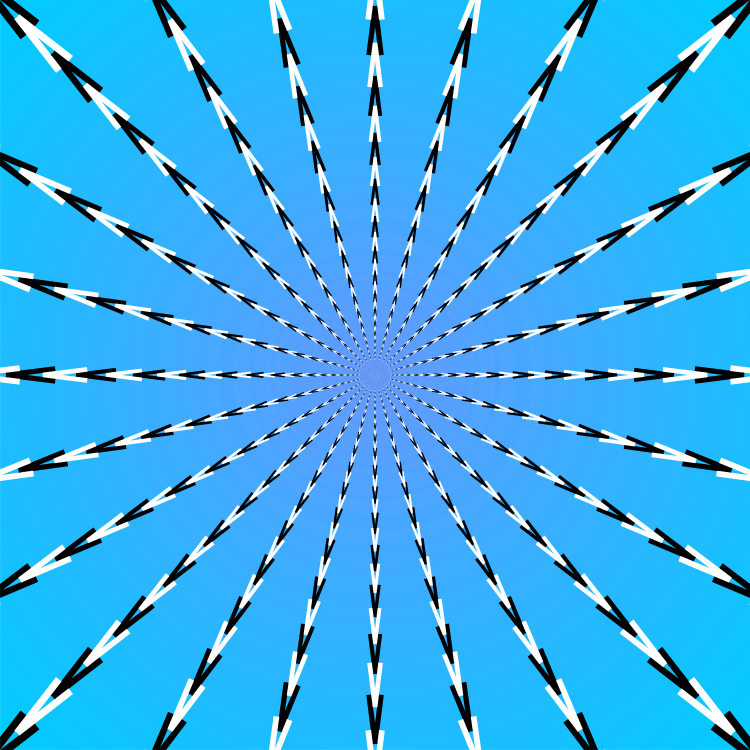
「ガンガゼ」
ガクガクして見える。
Copyright Akiyoshi Kitaoka 2008 (March 11)
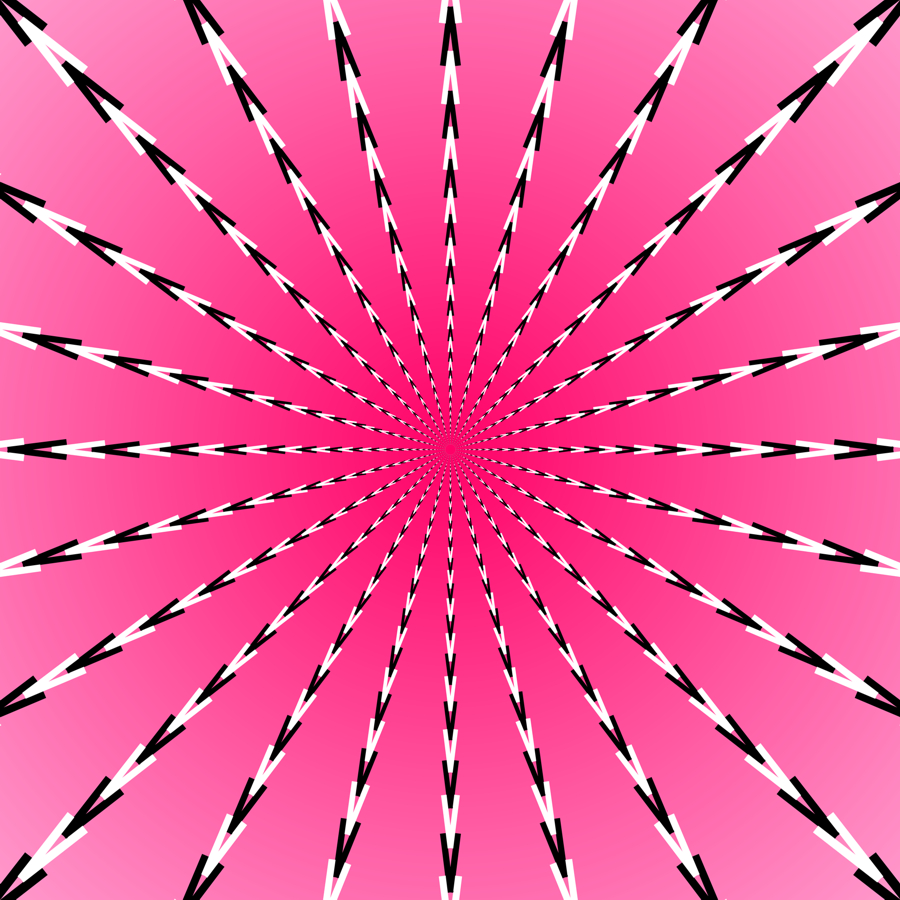
「ピンクのガンガゼ」
ガクガクして見える。
Copyright Akiyoshi Kitaoka 2013 (February 5)
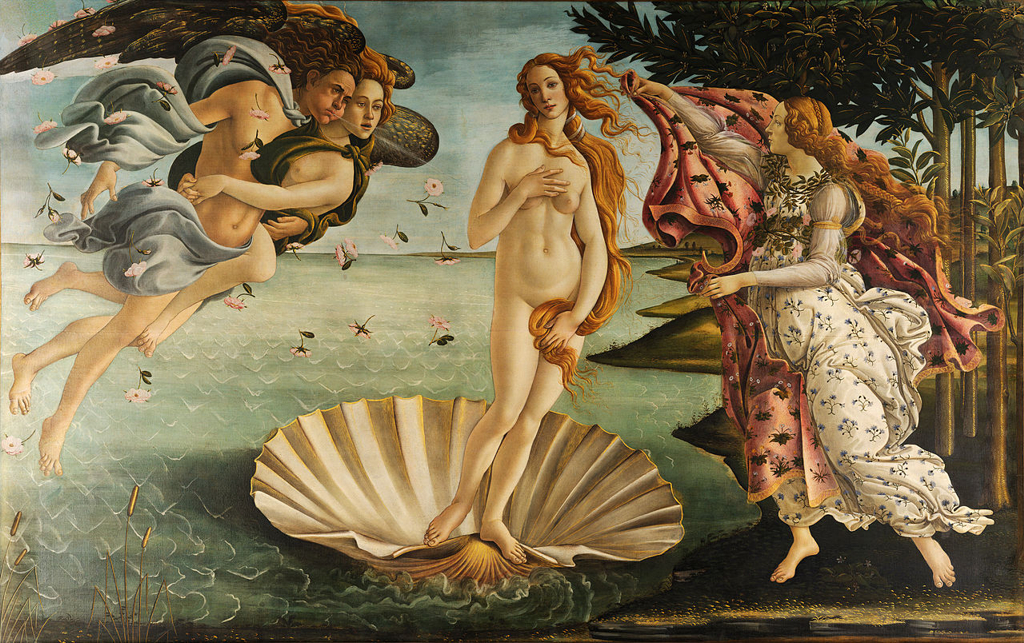
『ヴィーナスの誕生』 サンドロ・ボッティチェリ作 1483年頃
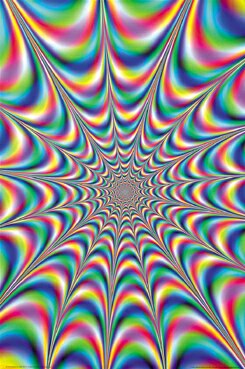
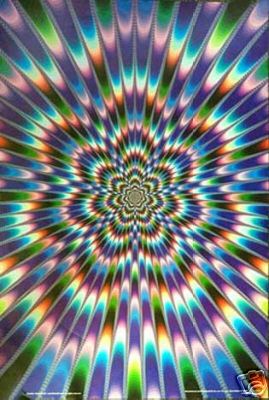
"Fractal Illusion" and "Fractal Zap"
Copyright Jeff Berkeley 1993 (Fractal Illusion), 1994 (Fractal Zap)
((c) 2000 Lifesmith Classic Fractals, Palmdale, CA, USA; 16-045 Published by AQUAIUS; Printed in the UK. www.aquariusimages.com; 福井県こども歴史文化館による情報)
"These are two of my fractal posters still sold at stores like Spencer's Gifts... "
シマシマドリフト錯視・シマシマガクガク錯視
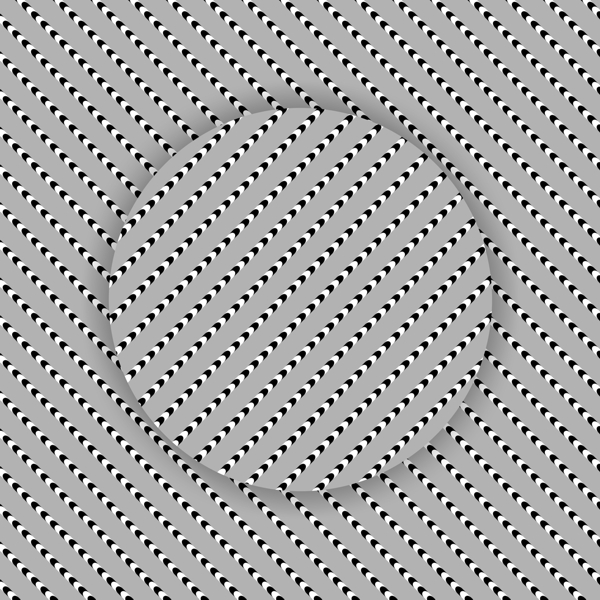
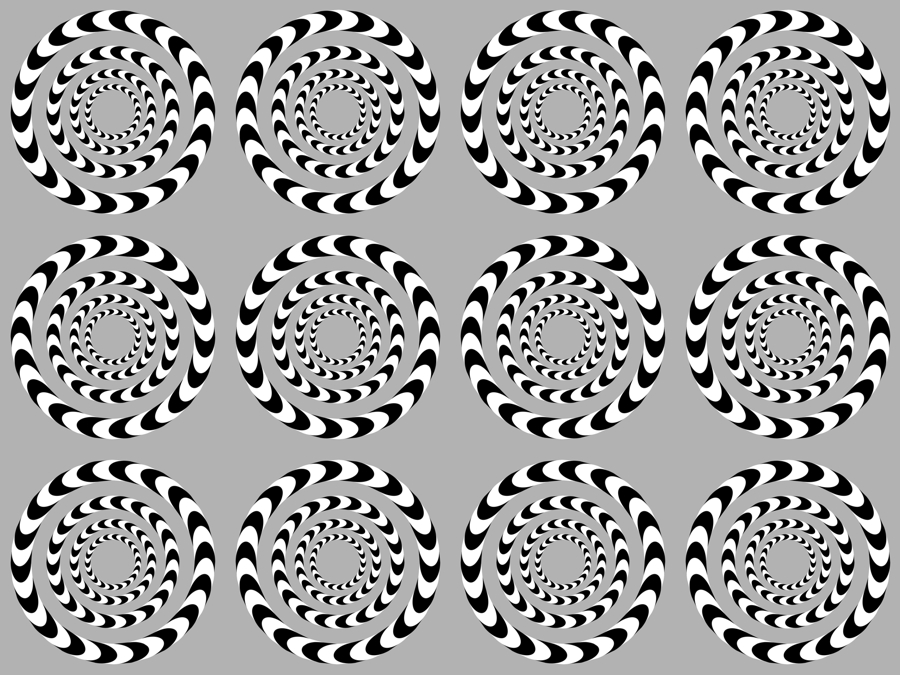
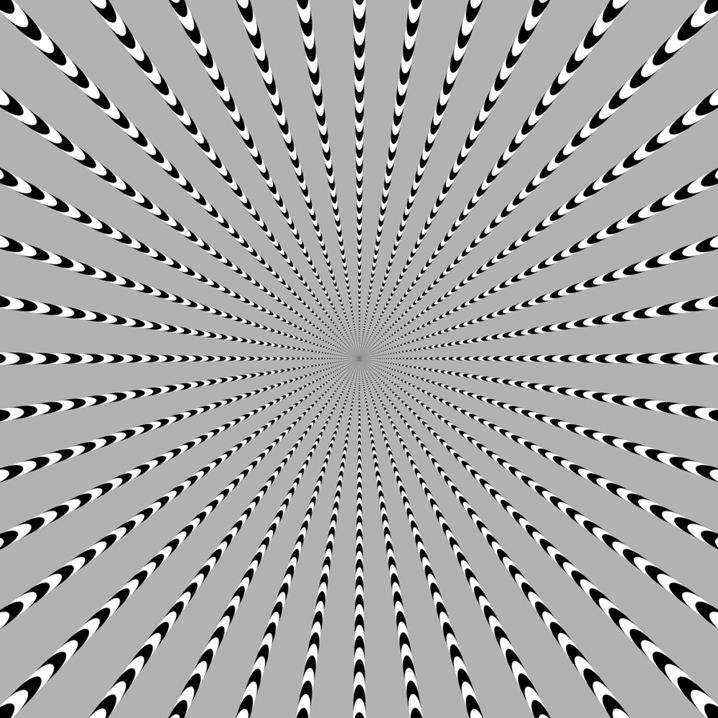
静止画が動いて見える錯視 フレーザー・ウィルコックス錯視群
Motion illusion in a static oimage: Fraser-Wilcox illusion group
特定の繰り返しのパターンに沿って動いて見える錯視である。 It is an illusory motion along repetitive patterns.
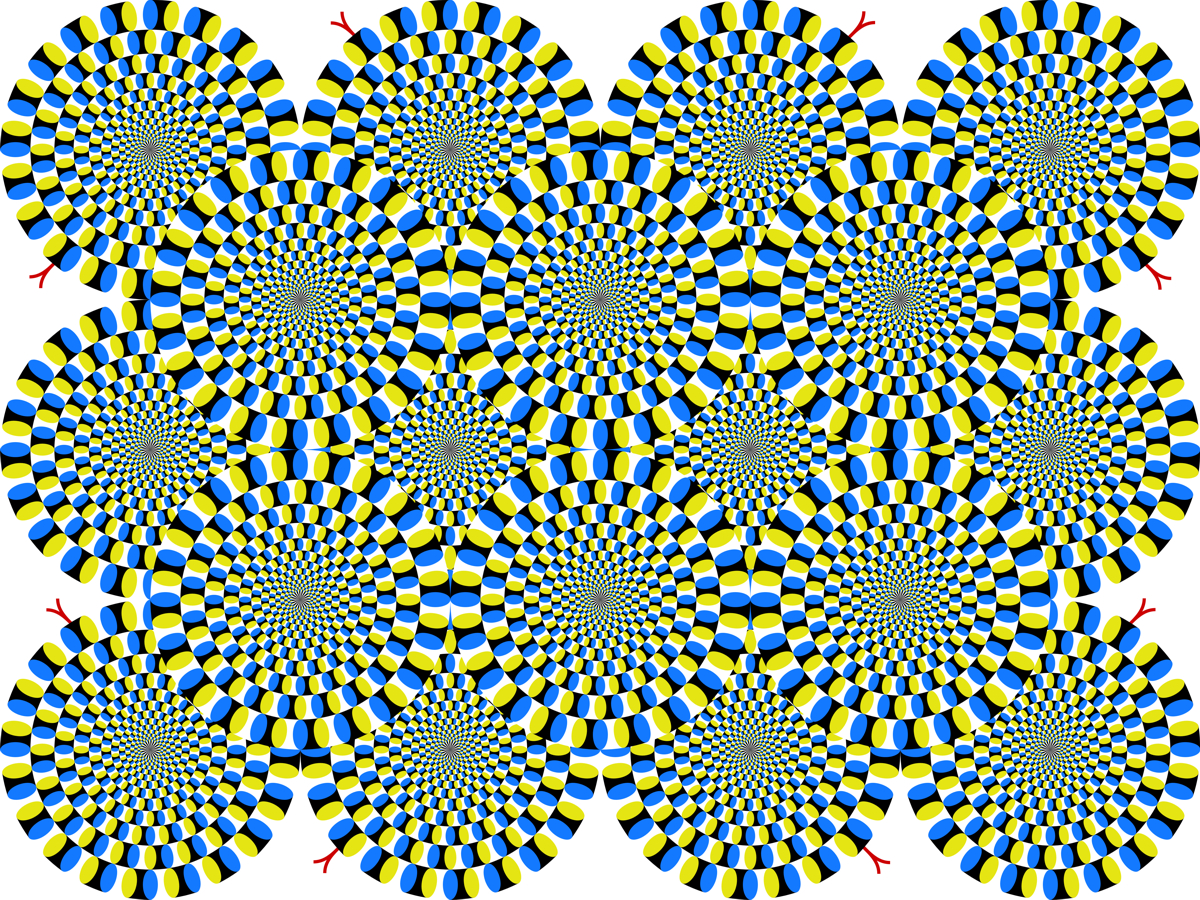
「蛇の回転」
(リメーク)
"Rotating snakes"
(a remke)
Copyright Akiyoshi Kitaoka 2013 (February 16)
黒→濃い灰色→白→薄い灰色→黒 の方向に動いて見える。
Direction: black → dark-gray → white → light-gray → black
「蛇の回転」の作り方

この錯視のわかりやすい説明のある本
北岡明佳著 人はなぜ錯視にだまされるのか? トリック・アイズ メカニズム カンゼン刊
(定価:1,600円(税別) ISBN 978-4-86255-020-0) アマゾンのページ
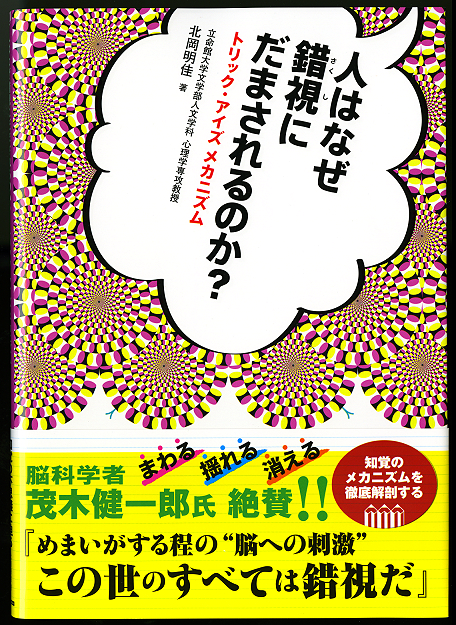
錯視のメカニズムの解説多し!
新刊!
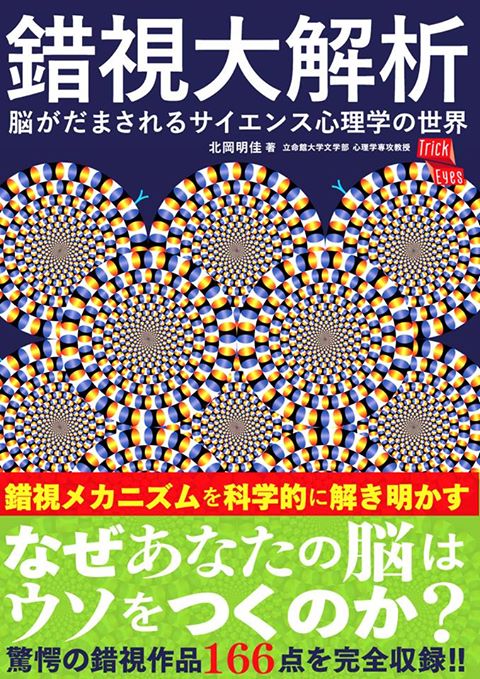
北岡明佳著 錯視入門 朝倉書店 (2010年7月) ![]() new!
new!
北岡明佳(監修) ニュートン別冊 脳はなぜだまされるのか? 錯視
完全図解 (2007年10月刊行) ![]()
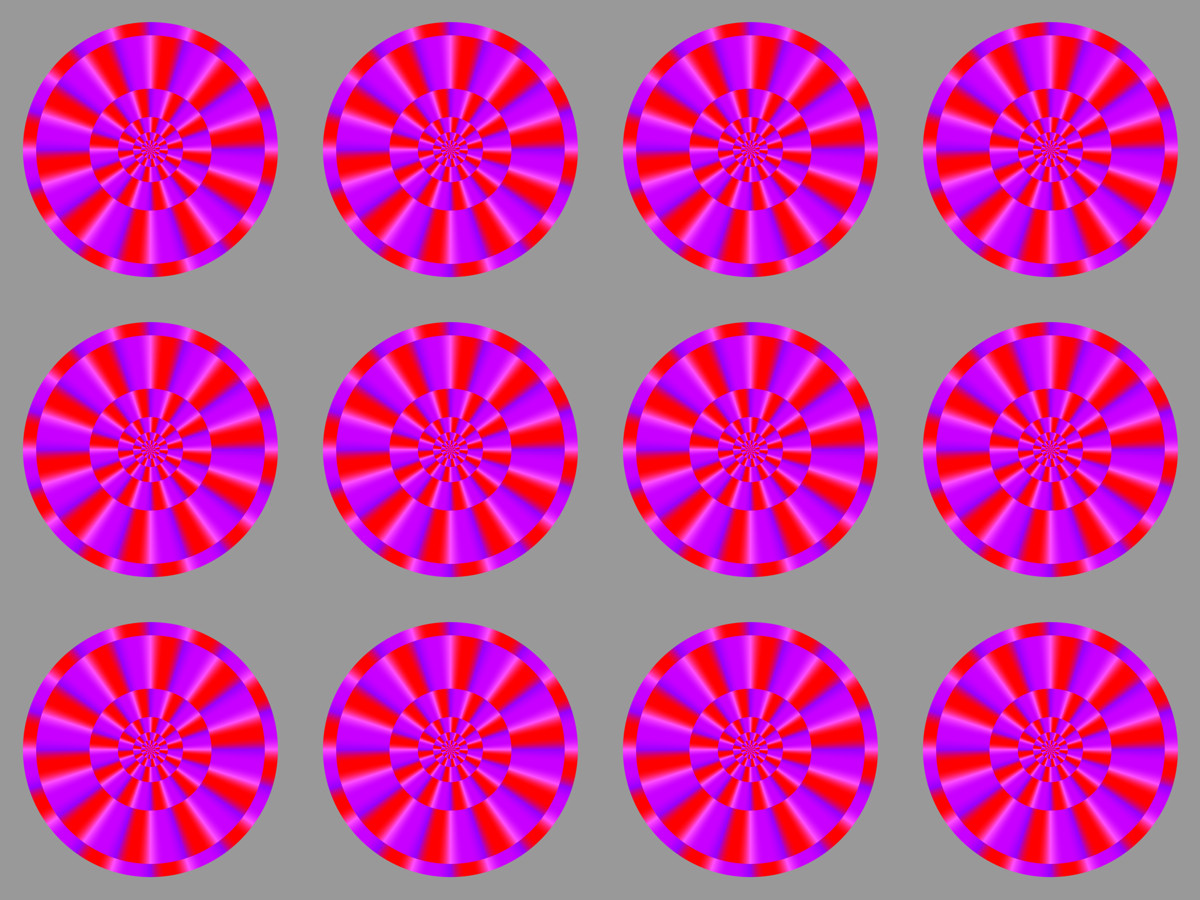
"Rotating red-and-purple disks"
Each disk appears to rotate clockwise on a bright display, while it appears to rotate counterclockwise with a printed image under dark illumination.
Copyright Akiyoshi Kitaoka 2013 (February 6)
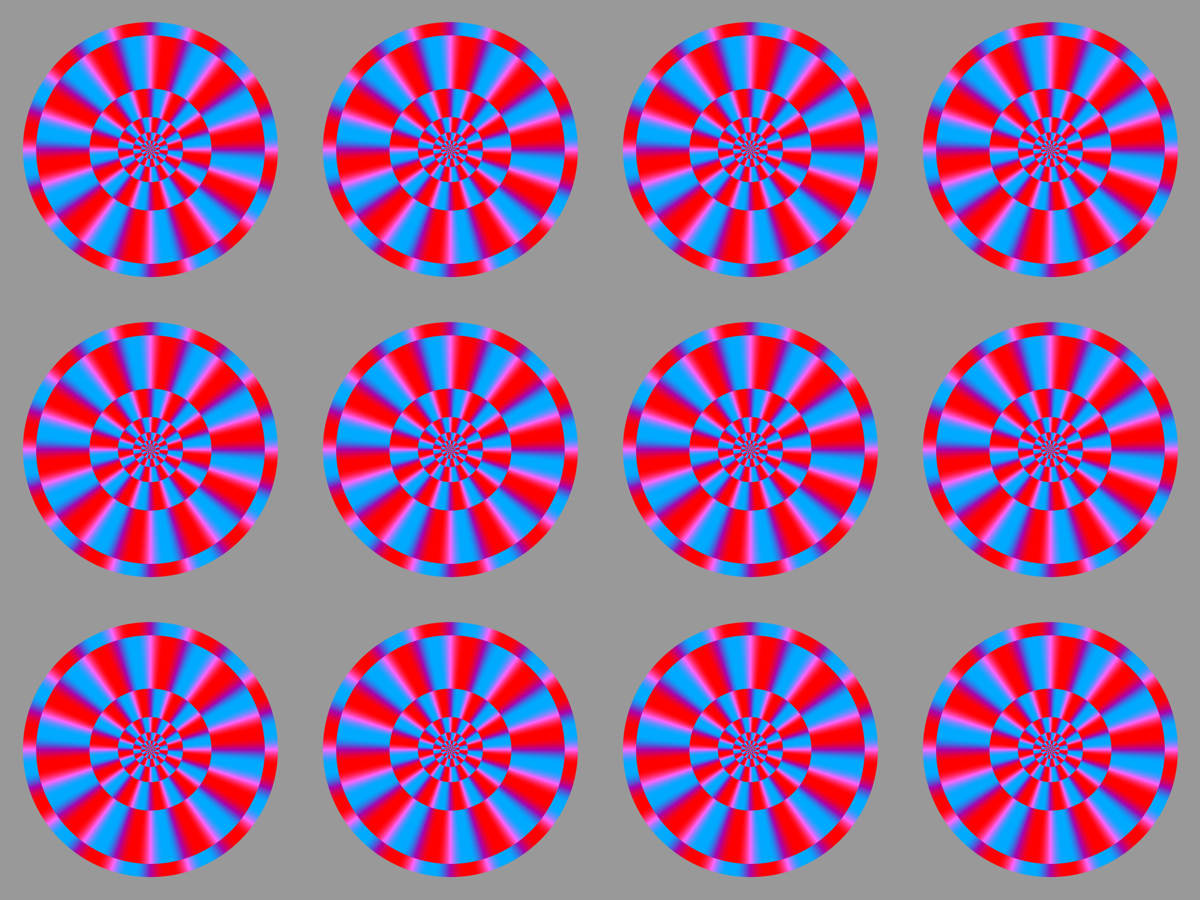
"Rotating red-and-cyan disks 2"
Each disk appears to rotate clockwise on a bright display, while it appears to rotate counterclockwise with a printed image under dark illumination.
Copyright Akiyoshi Kitaoka 2013 (February 6)
Conclusion in advance
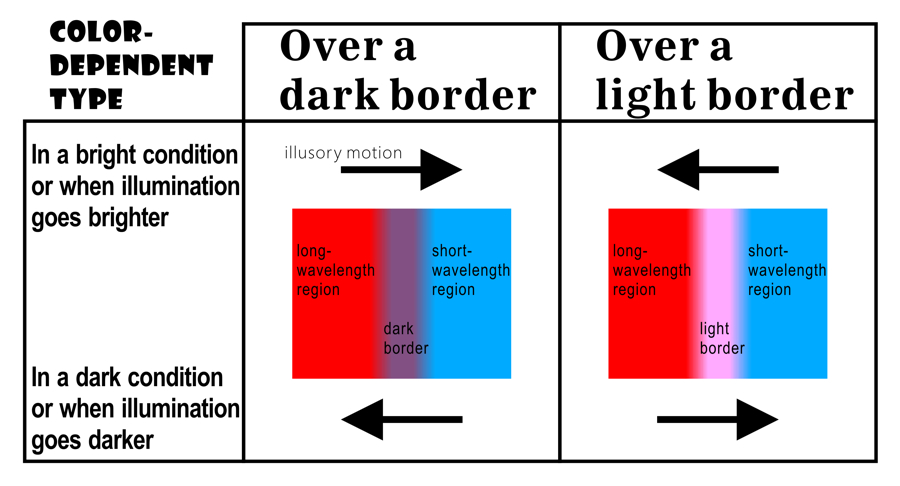
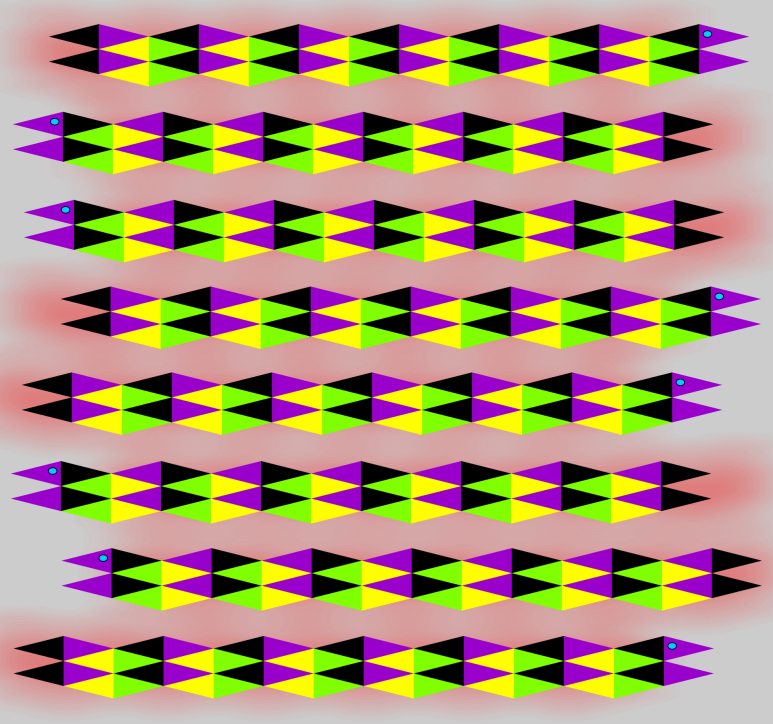
"Moving snakes with a cloud of dust"
Snakes appear to move horizontally.
Copyright Akiyoshi Kitaoka 2009 (June 7)
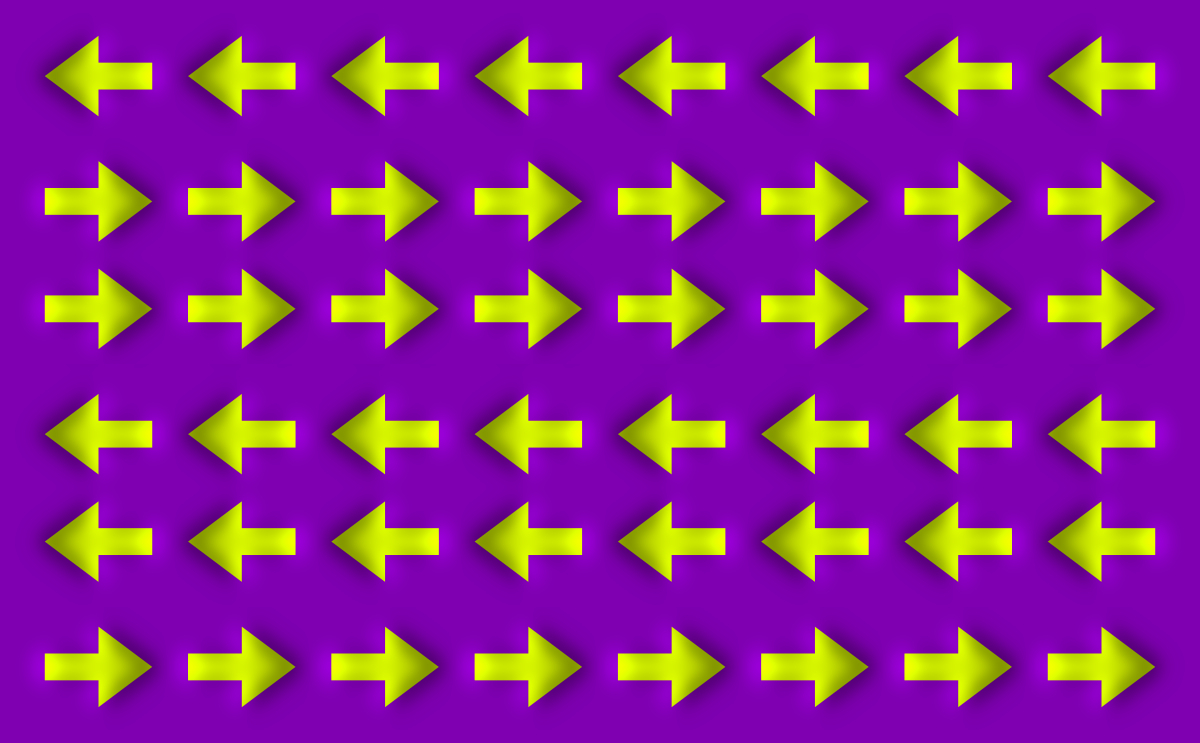
"Moving arrows illusion"
Arrows appear to move.
Copyright Akiyoshi Kitaoka 2013 (September 26)
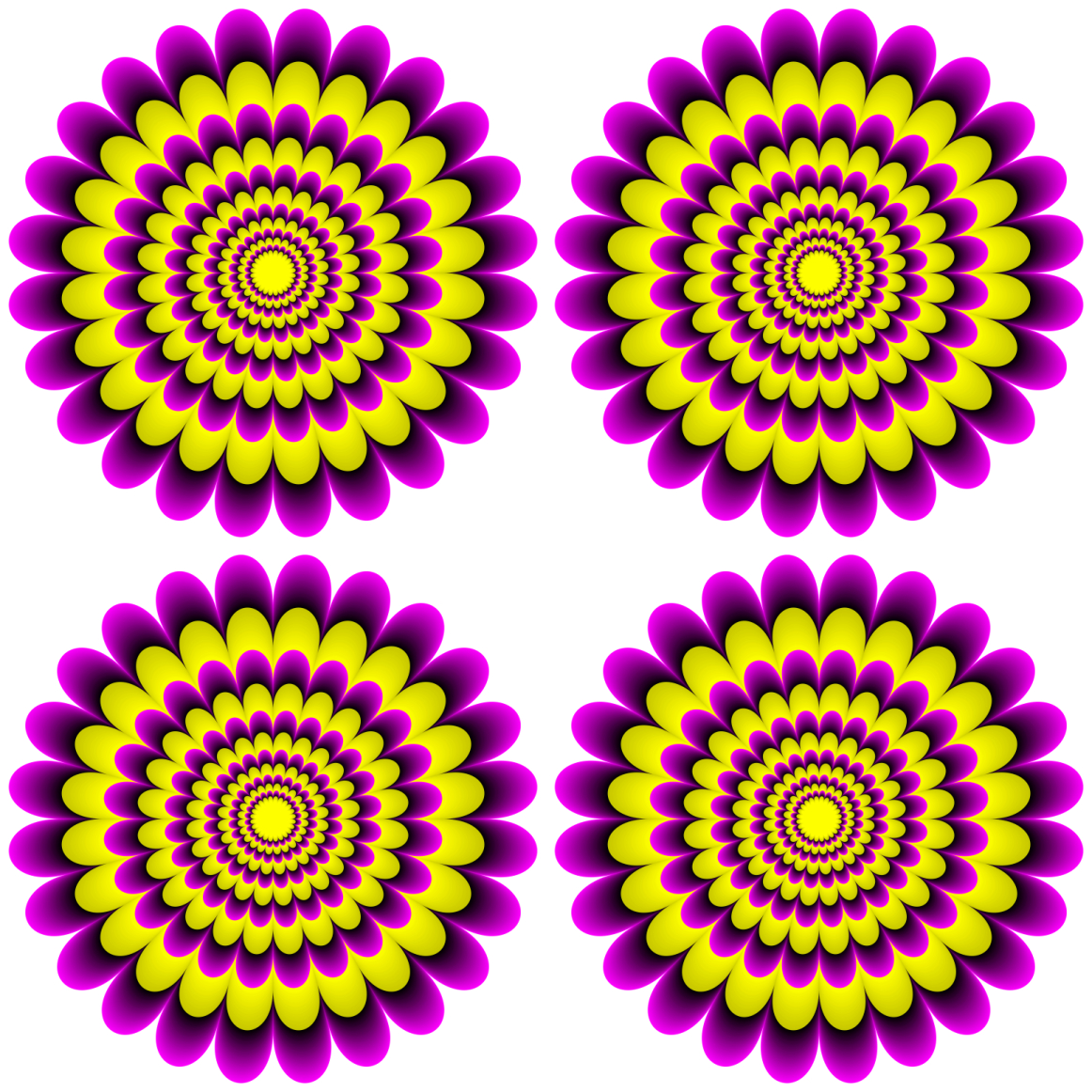
"Blooming flowers"
Flowers appear to expand.
Copyright Akiyoshi Kitaoka 2008 (March 11)
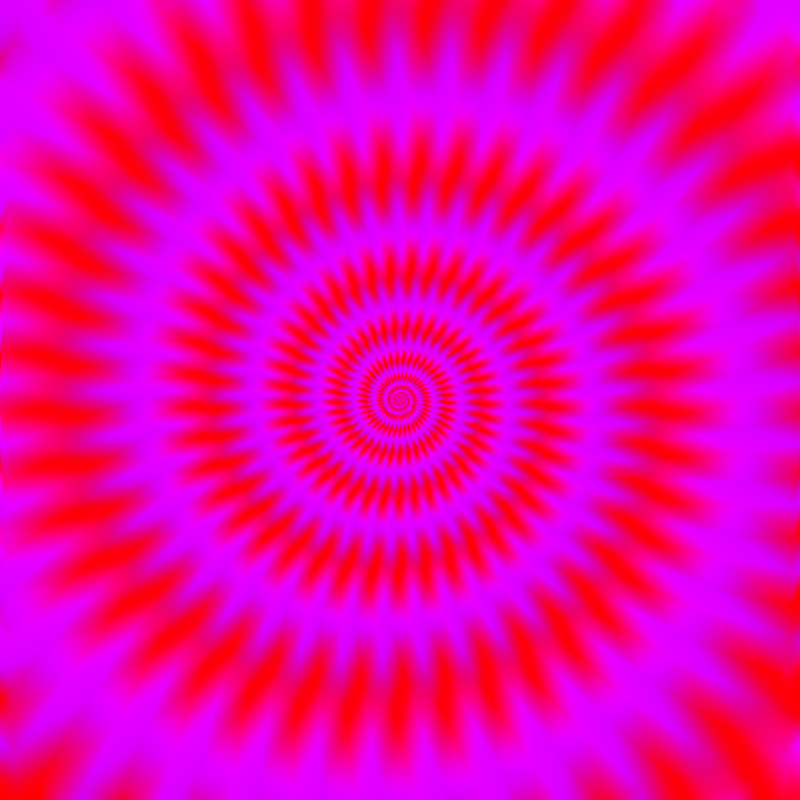
「ぐいぐい昇竜」
Ascending dragon
竜が昇っていくように見える(下から見たところ)。
An dragon appears to rise.
Copyright Akiyoshi Kitaoka 2011 (February 12)
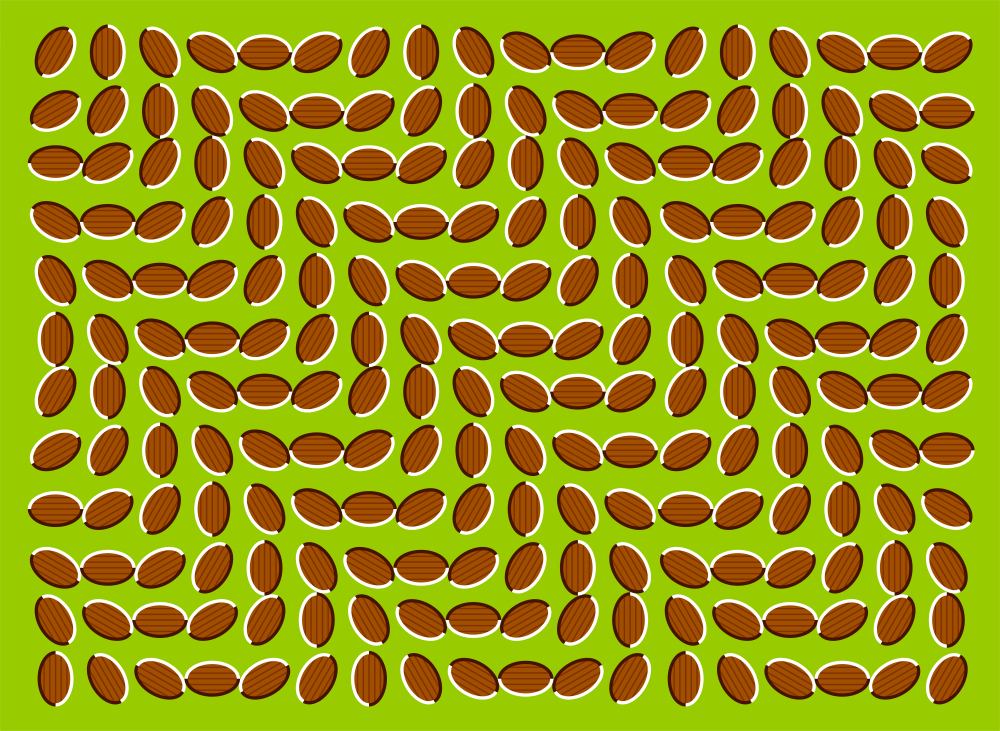
"Dongurakokko" (The donguri wave)
Donguri (acorns) appear to wave.
Copyright A.Kitaoka 2004 (April 19)
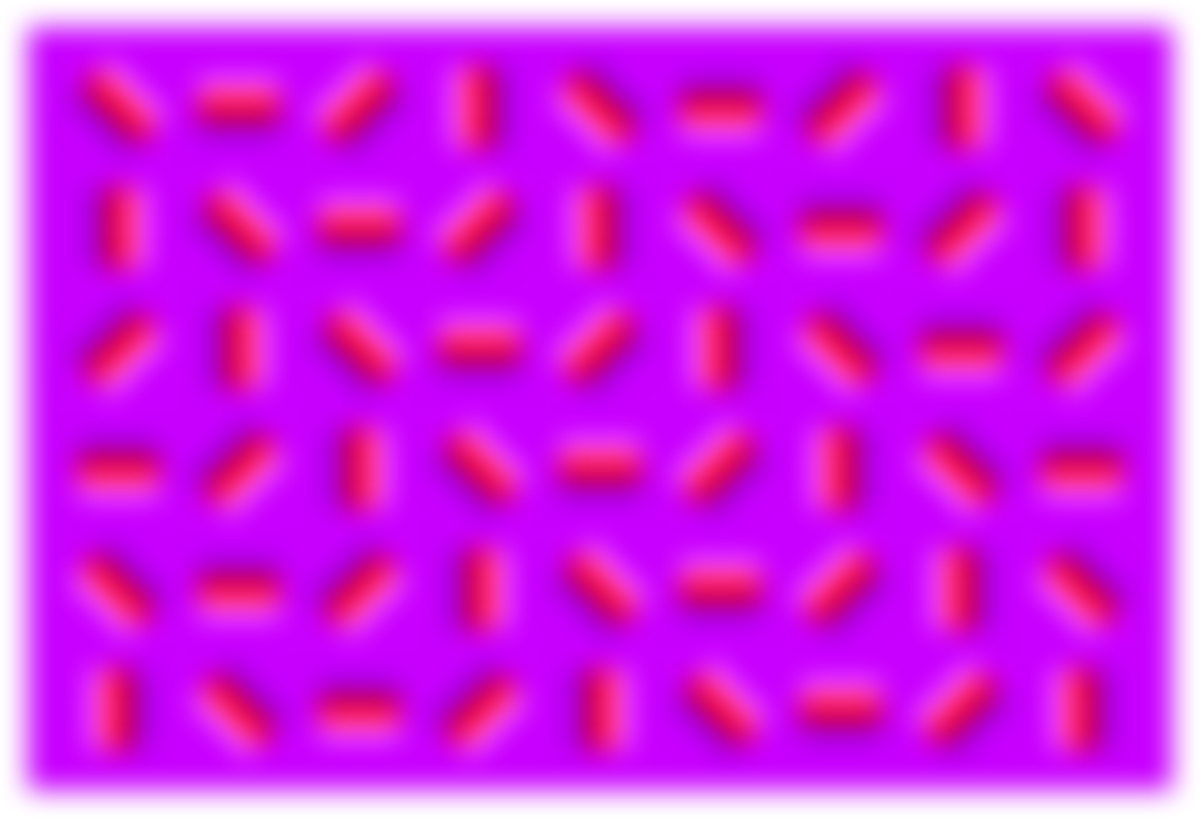
「トロの波」
図が波打って見える。
Copyright Akiyoshi Kitaoka 2011 (September 5)
A brief history of phenomenal aspects of the Fraser-Wilcox illusion group
<Kitaoka, A. (forthcoming). The Fraser-Wilcox illusion and its extension. In Shapiro, A. and Todorovic, D. (Eds.), Oxford Compendium of Visual Illusions. Oxford University Press.>
1. Fraser and Wilcox (1979)
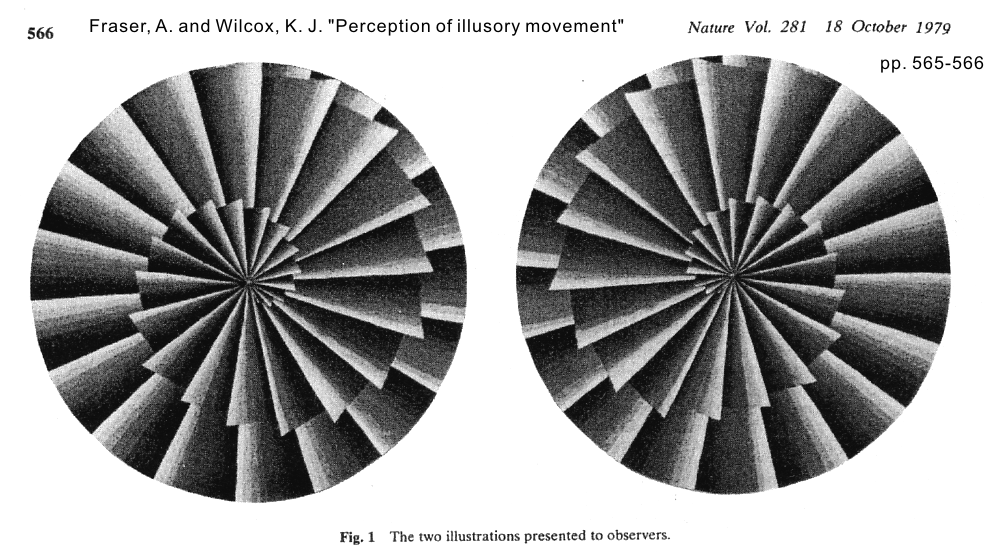
References
Fraser, A. and Wilcox, K. J. (1979). Perception of illusory movement. Nature, 281, 565-566.
Observers saw illusory motion in a stationary image which consists of repeated luminnace gradient in a saw-tooth wave form. Some reported illusory motion from dark to light along a luminance gradient, while others saw the reversal. The illusion is strong in the peripheral viewing. Fraser and Wilcox (1979) claimed that this individual difference depends on some genetic properties.
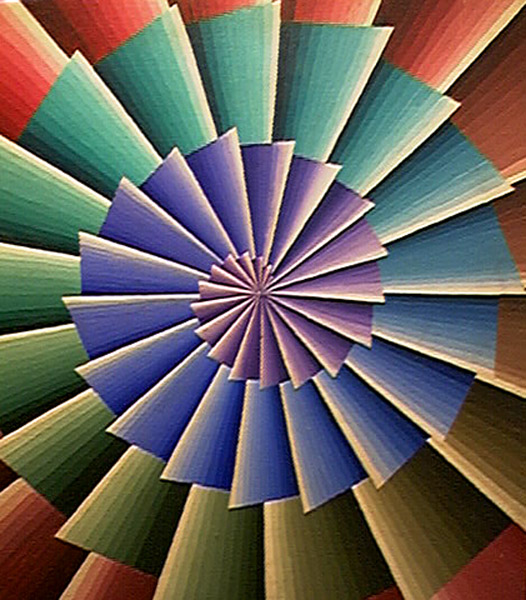
Adopted from “Alex Fraser, Geneticist and Painter”
(http://doctoralexfraser.blogspot.jp/p/spirals.html) <access August 25, 2012> (with permission from Alan Fraser)
Alex Fraser (1923-2002) was a geneticist and a painter.
2. Faubert and Herbert (1999)
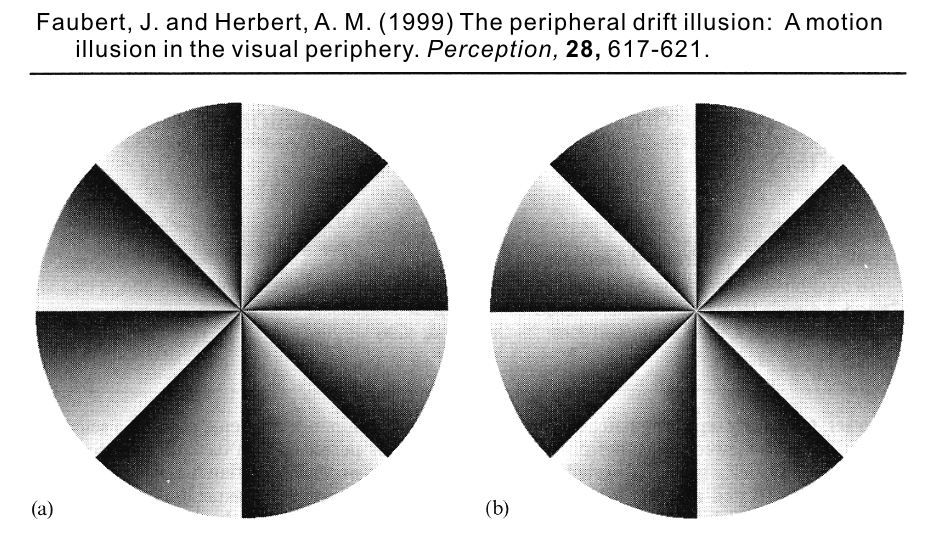
The left disk appears to rotate clockwise while the right one counterclockwise. Faubert and Herbert (1999) reported only illusory motion from dark to light along a luminance gradient. They attributed the illusory motion to the assumed time difference between responses to black and white.
References
Faubert, J. and Herbert, A. M. (1999). The peripheral drift illusion: A motion illusion in the visual periphery. Perception, 28, 617-621.
3. Naor-Raz and Sekuler (2000)
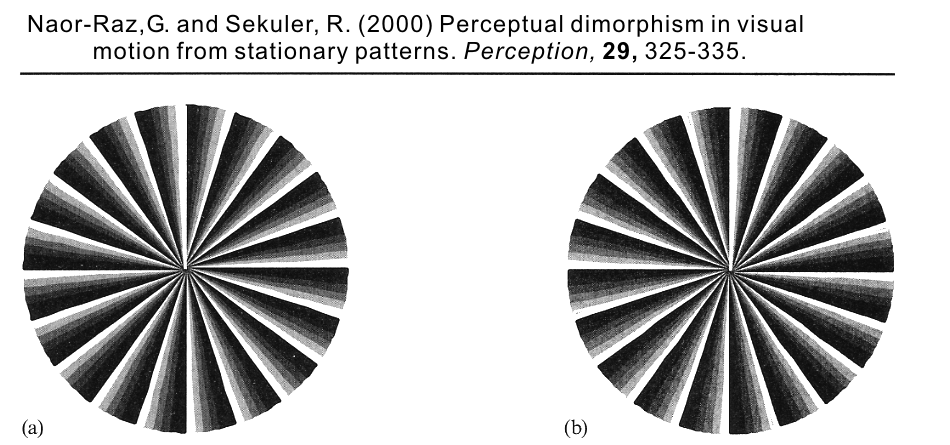
The left disk appears to rotate clockwise while the right one counterclockwise. Naor-Raz and Sekuler (2000), too, reported only illusory motion from dark to light along a luminance gradient. They revealed that the illusion magnitude is a positive, nearly linear function of contrast.
References
Naor-Raz, G. and Sekuler, R. (2000). Perceptual dimorphism in visual motion from stationary patterns. Perception, 29, 325-335.
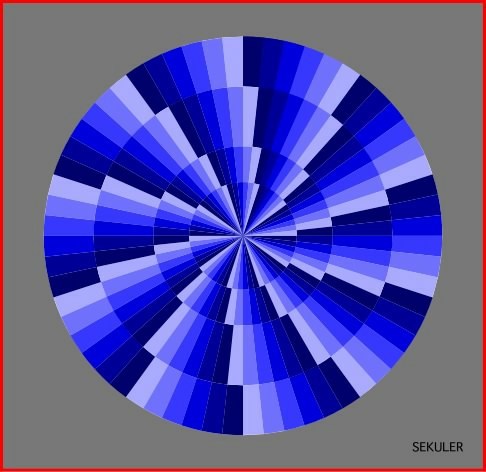
This disk appears to rotate clockwise.
This color illusion image presented by Naor-Raz and Sekuler (2000) (shown
below) might be attributable to this type.
http://www.perceptionweb.com/perception/perc0300/sekuler.jpg <access August 26, 2012>
<with permission from Robert Sekuler>
4. Kitaoka and Ashida (2003)
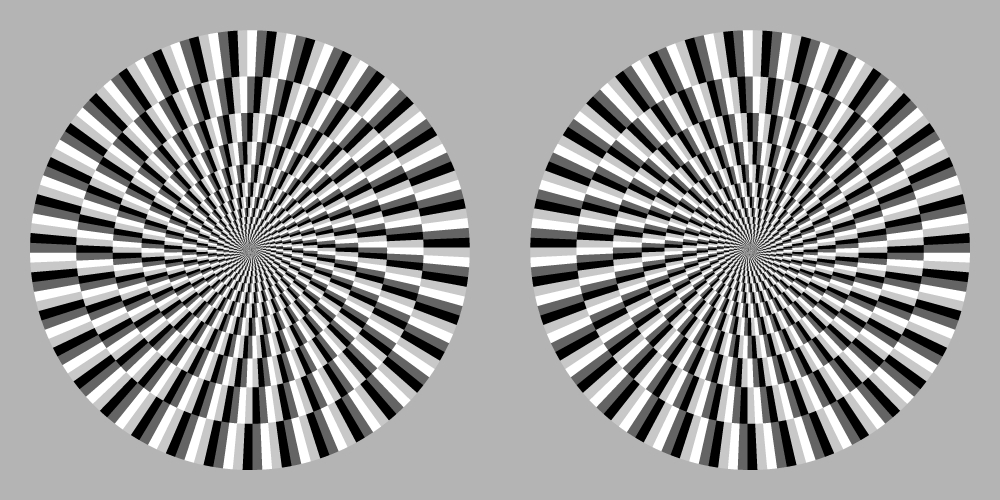
The left disk appears to rotate counterclockwise while the right one clockwise. Kitaoka and Ashida (2003) proposed that the illusory motion is strong when patterns are arranged in the following luminance order: from black, dark-gray, white, light-gray, and back to black.
References
Kitaoka, A. and Ashida, H. (2003). Phenomenal characteristics of the peripheral drift illusion. VISION (Journal of the Vision Society of Japan), 15, 261-262. PDF
5. Kitaoka (2007)
Kitaoka (2007) classified the Fraser-Wilcox illusion into Type I, IIa, IIb and III, in each of which the dark-to-light type was distinguished from the light-to-dark one.
References
Kitaoka, A. (2007) Phenomenal classification of the “optimized” Fraser-Wilcox illusion and the effect of color. Poster presentation in DemoNight, VSS2007, GWiz, Sarasota, Florida, USA, May 14, 2007.
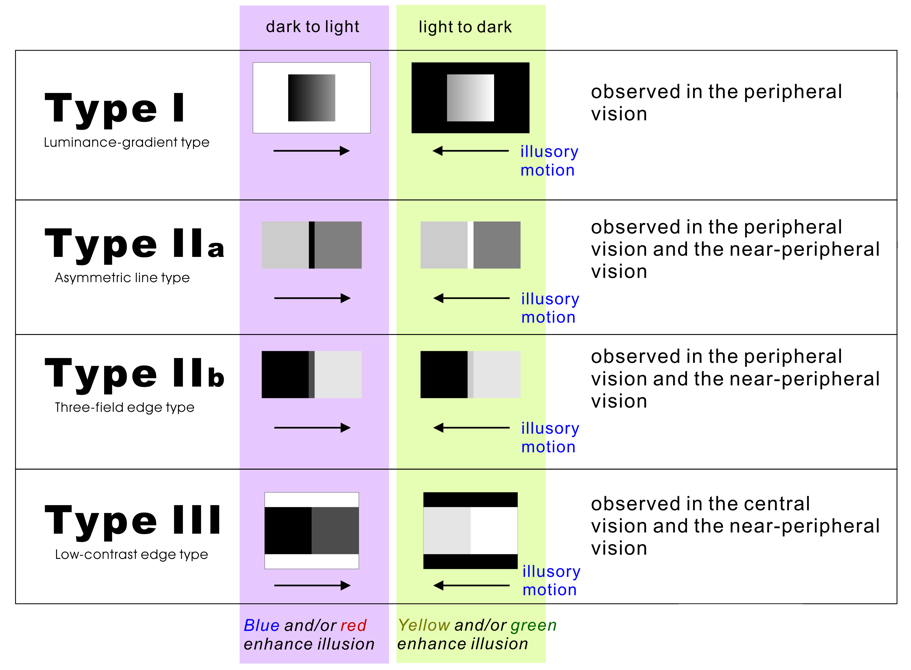
Type I
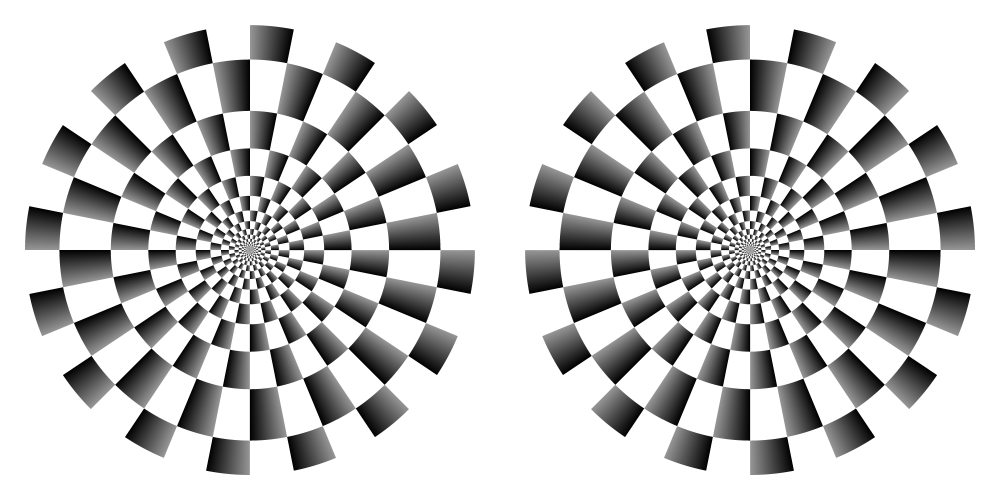
"Dark to light"
The left disk appears to rotate counterclockwise while the right one clockwise.
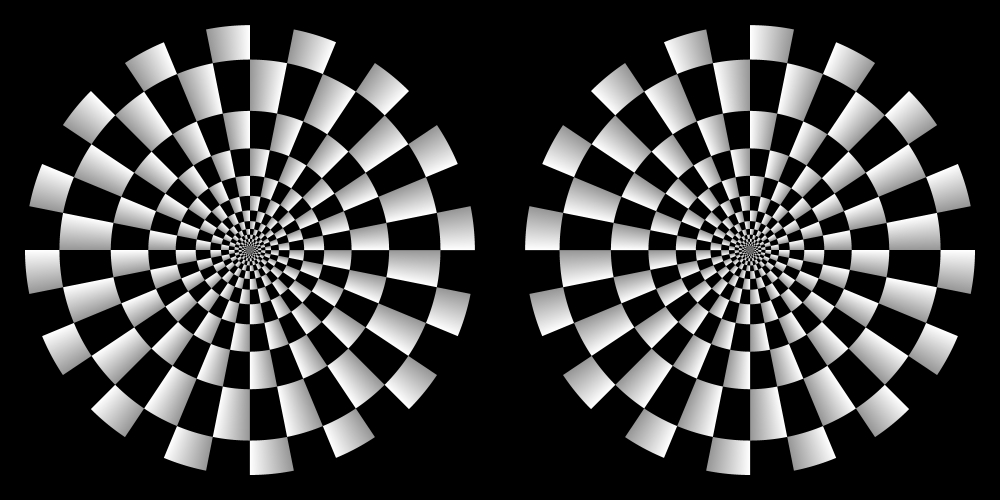
"Light to dark"
The left disk appears to rotate counterclockwise while the right one clockwise.
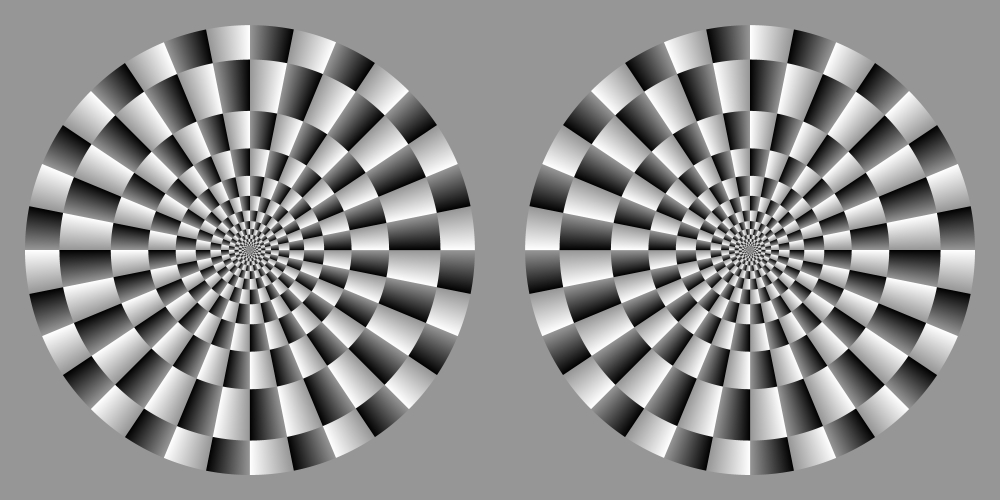
"Dark to light" and "light to dark" combined
The left disk appears to rotate counterclockwise while the right one clockwise.
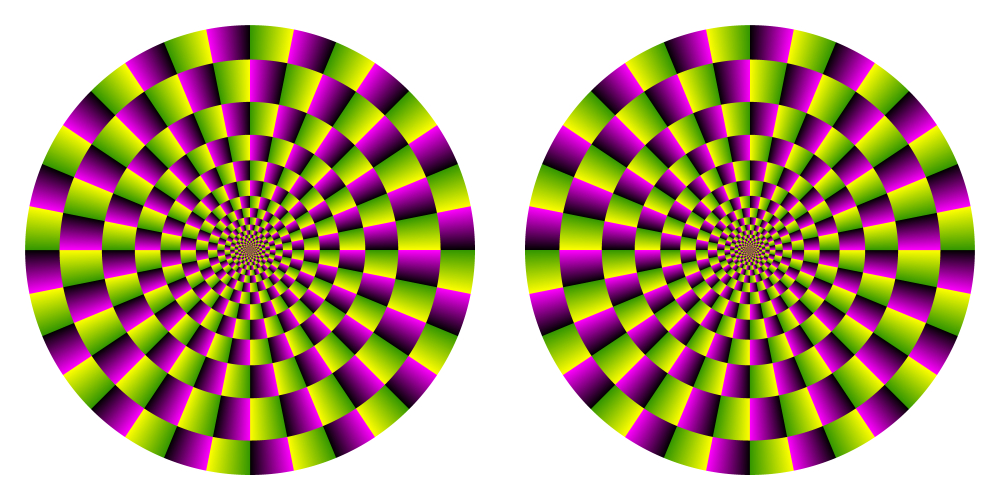
"Dark to light" and "light to dark" combined, with
color enhancement
The left disk appears to rotate counterclockwise while the right one clockwise.
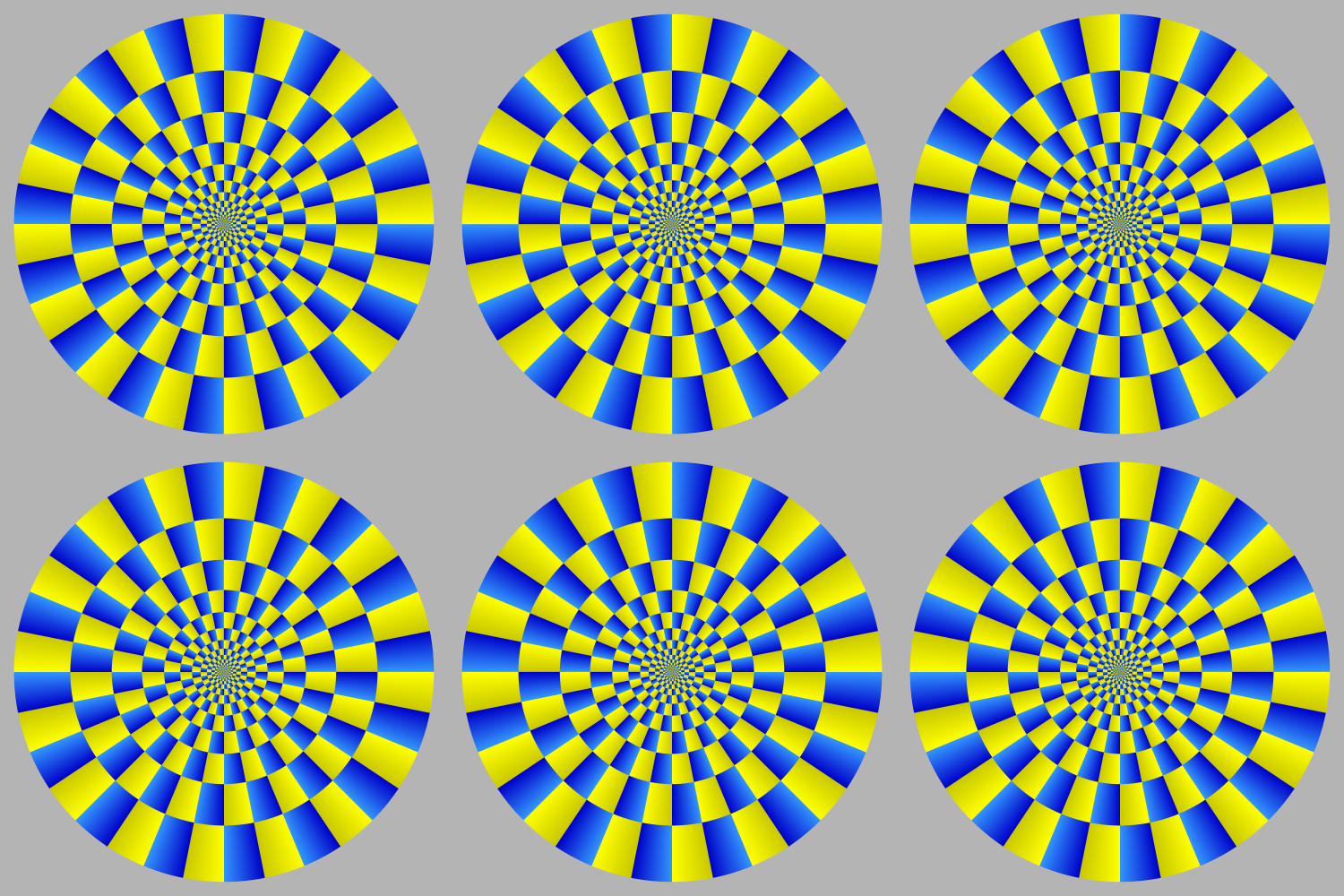
The upper-left, upper-right, and lower-middle disks appear to rotate counterclockwise
while the rest clockwise.
Type I (six disks) 1500 x 1000 (pixel)
Type I (six disks) 6000 x 4000 (pixel)
Type II
Type IIa
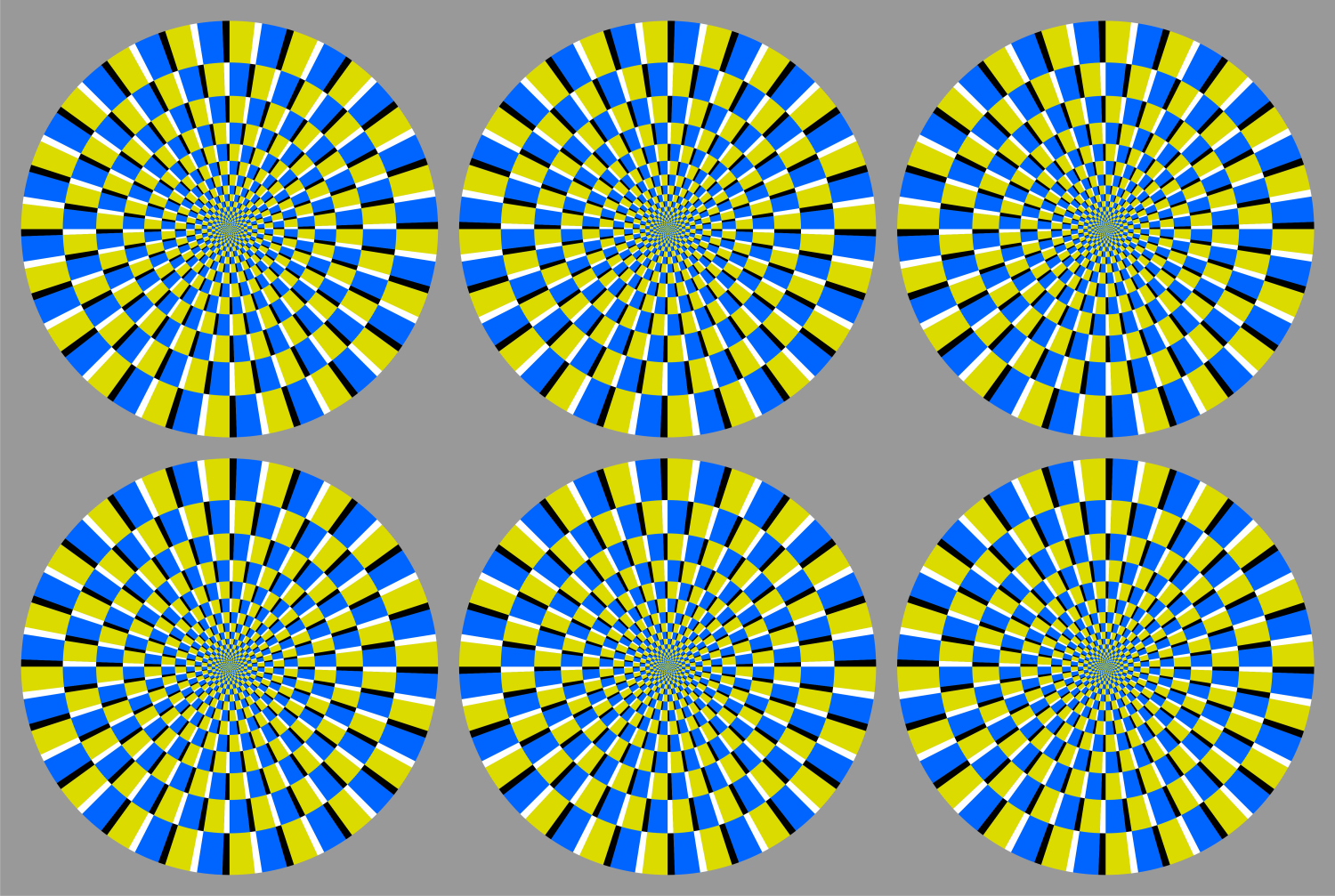
The upper-left, upper-right, and lower-middle disks appear to rotate counterclockwise
while the rest clockwise.
Type IIb
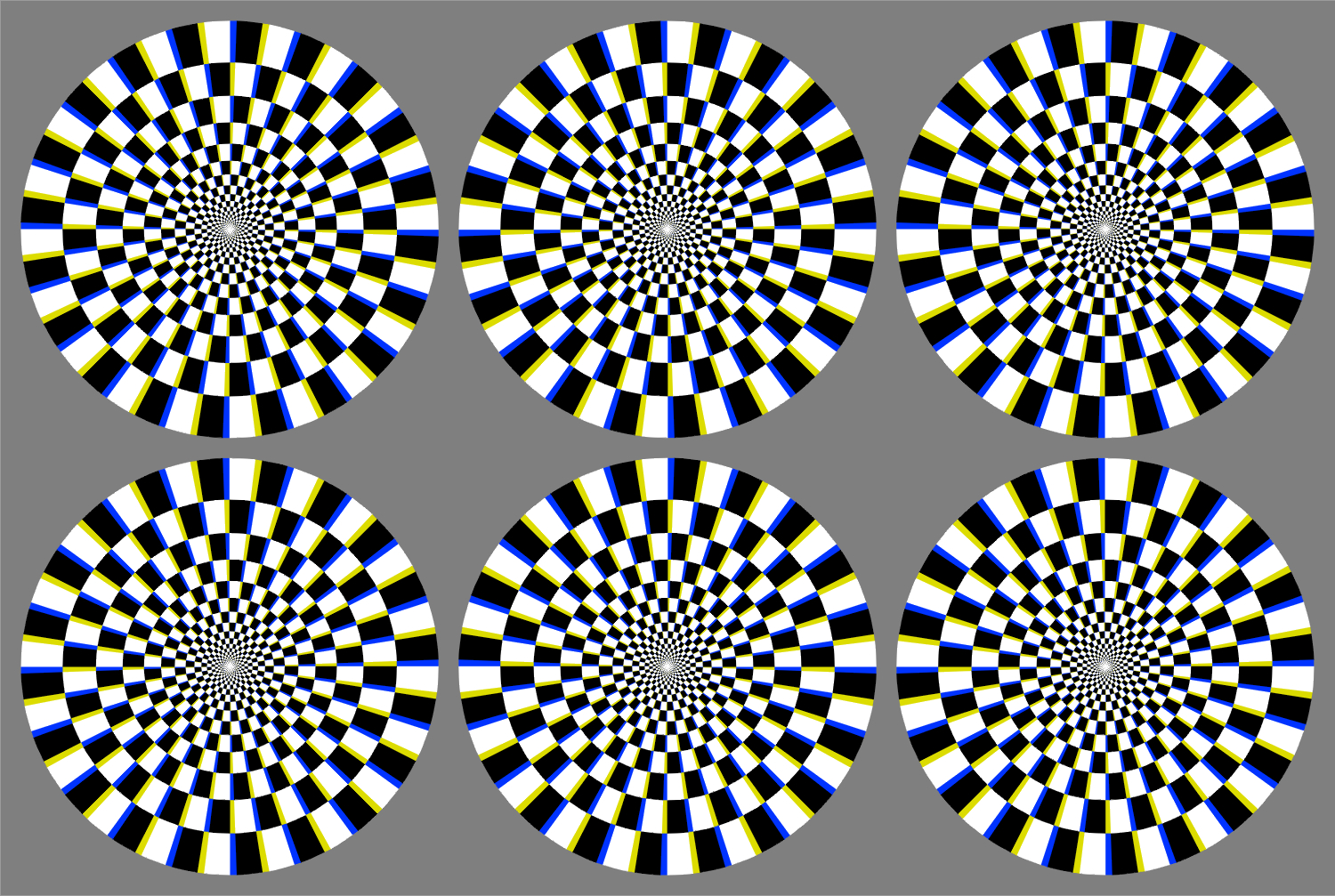
The upper-left, upper-right, and lower-middle disks appear to rotate counterclockwise while the rest clockwise.
Type IIa (six disks) 1500 x 1007 (pixel)
Type IIa (six disks) 6000 x 4031 (pixel)
Type IIb (six disks) 1500 x 1000 (pixel)
Type IIb (six disks) 6000 x 4000 (pixel)
"Rotating snakes"
(Ver. 2011)
Each disk appears to rotate.
Copyright Akiyoshi Kitaoka 2011 (January 23)
Adjusted for printing using EPSON PM-4000PX
「オカザえもんの回転」
右のリングは時計回りに、左のリングは半時計回りに回転して見える。
Produced by Akiyoshi Kitaoka 2013 (September15, 9, 10)
オカザえもんは許諾を得て使用
Type III

The upper row appears to move rightward while the lower one leftward.
Type III (two rows) 1500 x 400 (pixel)
Type III (two rows) 4500 x 1200 (pixel)Type III 4500 x 1200
.jpg)
The upper-left, upper-right, and lower-middle disks appear to rotate counterclockwise
while the rest clockwise.
6. Kitaoka (2008a, b)
"Type IV" was added to the list.
References
Kitaoka, A. (2008a). Optimized Fraser-Wilcox illusions: a pictorial classification by Akiyoshi Kitaoka. Talk in Workshop No.005 "Experimental studies of anomalous motion illusions" in the 72nd Annual Convention of the Japanese Psychological Association, Hokkaido University, Sapporo, Japan, September 19, 2008. Talk
Kitaoka, A. (2008b). A new type of the optimized Fraser-Wilcox illusion in a 3D-like 2D image with highlight or shade. Journal of Three Dimensional Images (Japan), 22(4), 31-32. PDF PDF (manuscript) Presentation
Type IV
m.jpg)
The upper-left, upper-right, and lower-middle rings appear to rotate counterclockwise
while the rest clockwise.
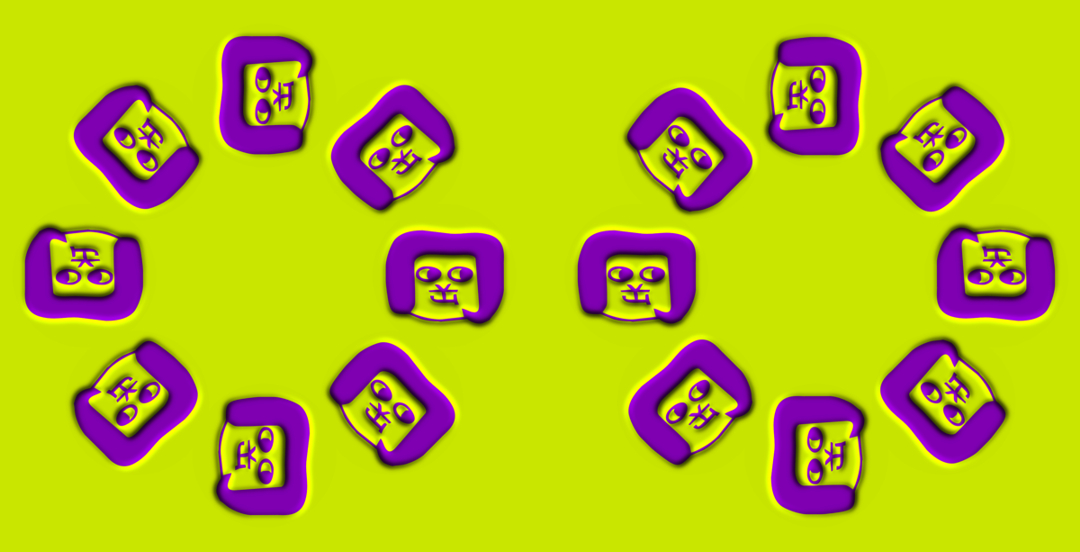
"Rotating Okazaemon"
(Seiriken Lecture 2013 version)
The right ring appears to rotate clockwise while the left one counterclockwise.
produced by Akiyoshi Kitaoka 2013 (October 24)
Okazaemon included with permission
7. Kitaoka (2008, 2010, 2012a, b)
A strongly color-dependent, "reddish" version was added to the list.
In 2008, Kitaoka found that the direction of illusory motion is “red → dark purple → purple → magenta (light red-purple) → red”, and that the illusion magnitude is strong when overall luminance contrast is low. Images of high luminance make a strong effect.
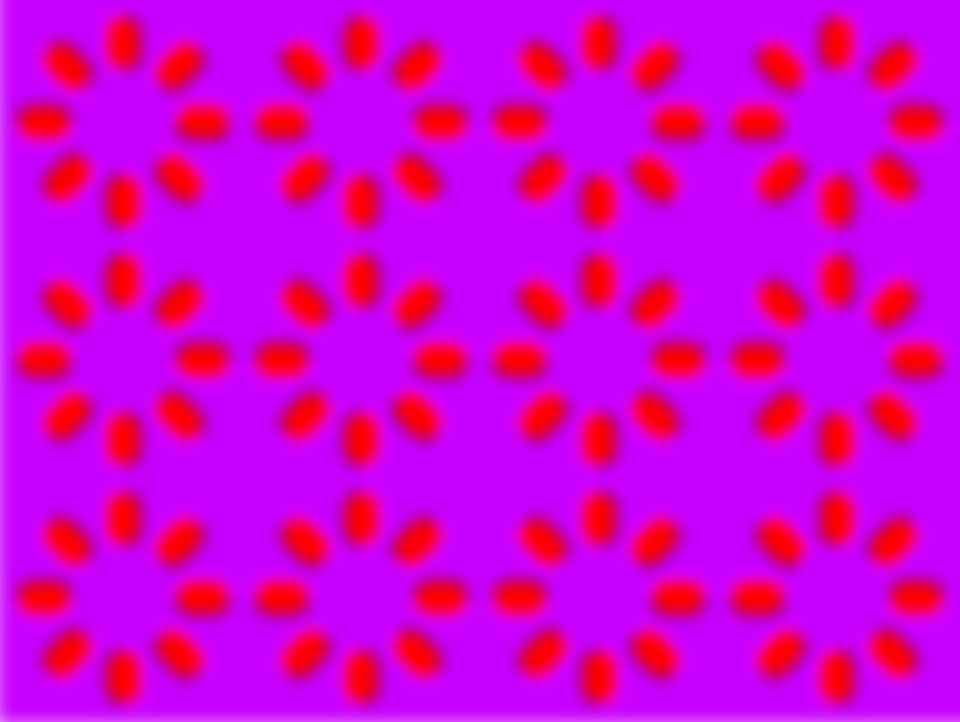
"Rotating red fruits"
Rings of fruits appear to rotate.
Copyright Akiyoshi Kitaoka 2008 (December 19)
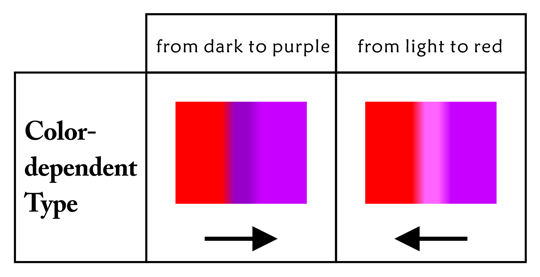
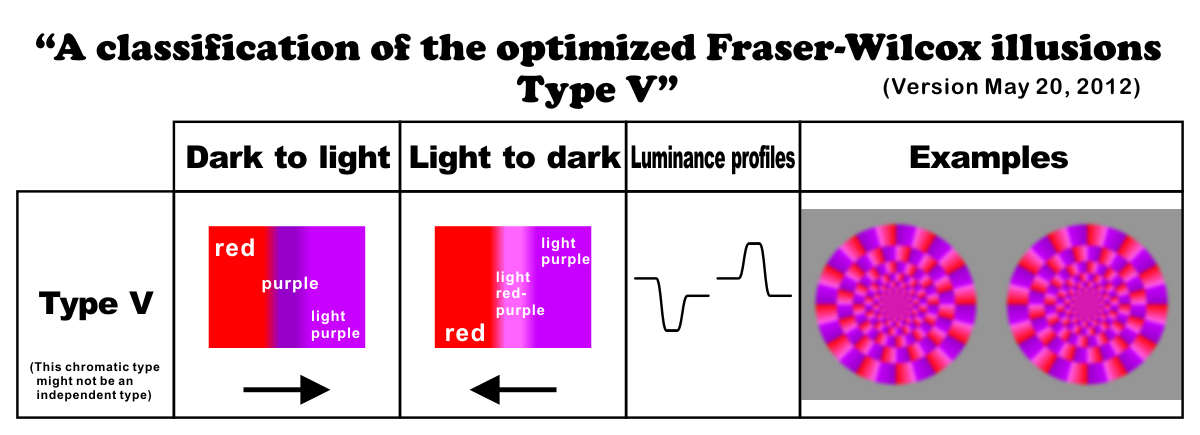
Purple » light purple » light red-purple » red » purple
References
Kitaoka, A. (2010). Introduction to visual illusion. Tokyo: Asakura-shoten (in Japanese). Book
Kitaoka, A. (2012a). Designs using the red Fraser-Wilcox illusion. Journal
of the Color Science Association of Japan, 36, Supplement, 188-189. PDF (color manuscript) Talk
Kitaoka, A. (2012b) The Fraser-Wilcox illusion and its extension. Perception 41 ECVP Abstract Supplement, page 91 (Poster September 3, 2012). Poster PDF
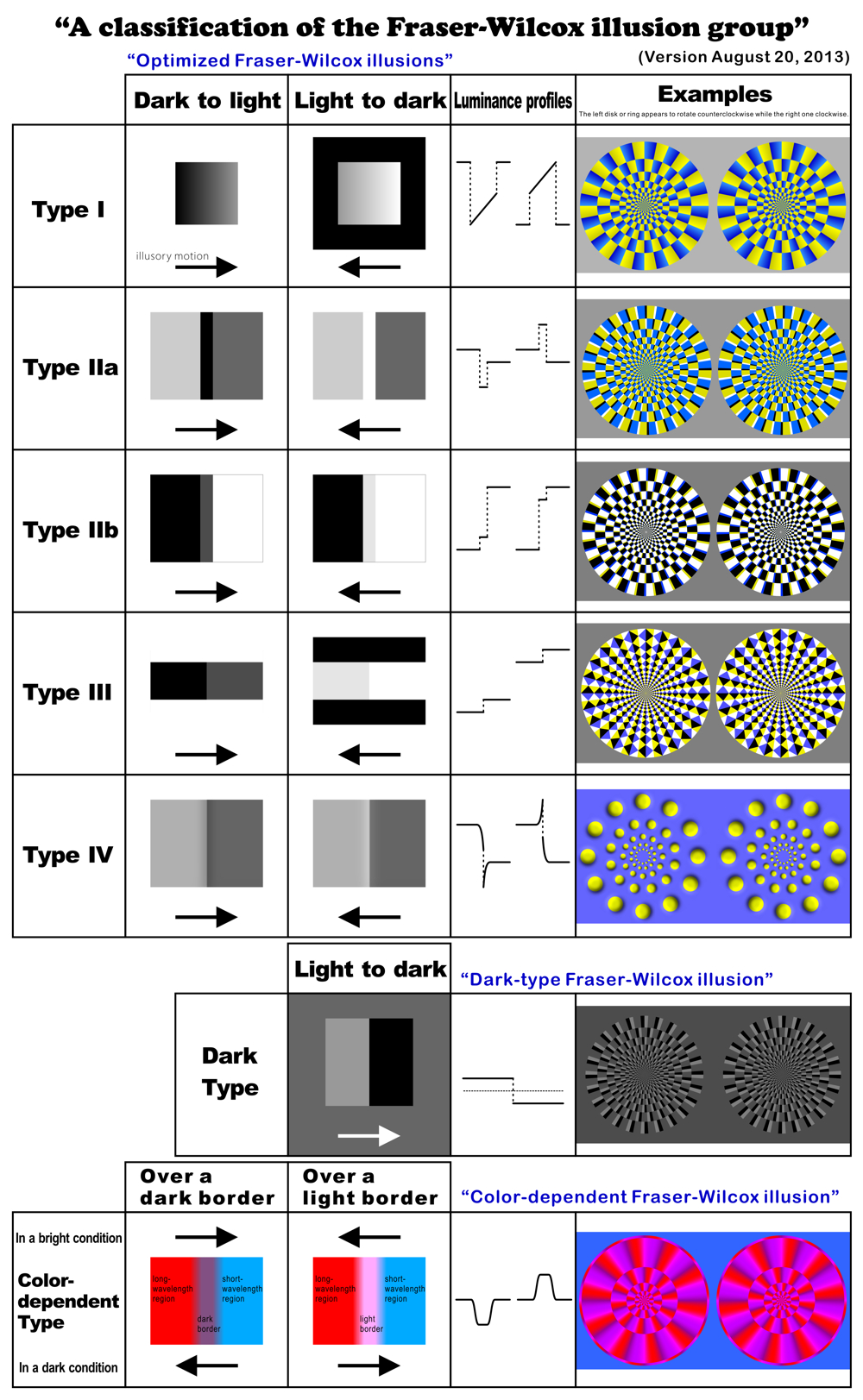
8. Kitaoka (2011)
In 2011, Kitaoka found that flickering the image increases the illusion magnitude. Blinks also work.
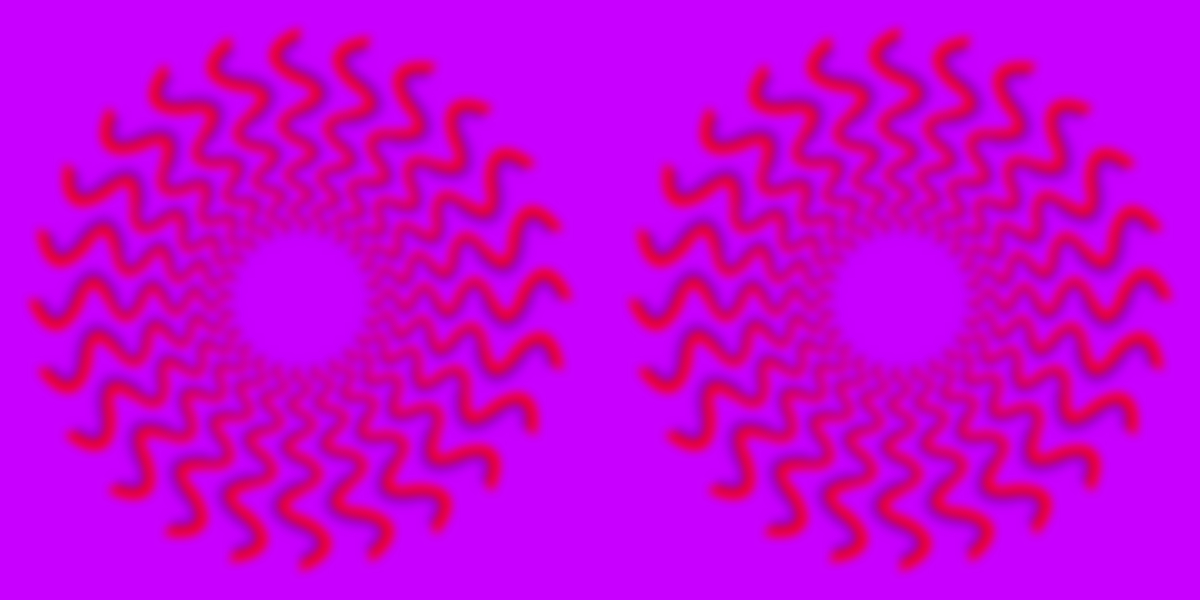
Copyright Akiyoshi Kitaoka 2012 (June 14)
Further studies on the flickering enhancement or induction (Kitaoka, 2013)
Flickering induction depends on the interaction between the stimulus and the blank.
Each disk appears to rotate clockwise during fading-in while counterclockwise during fading-out.
Copyright Akiyoshi Kitaoka 2013 (February 19)
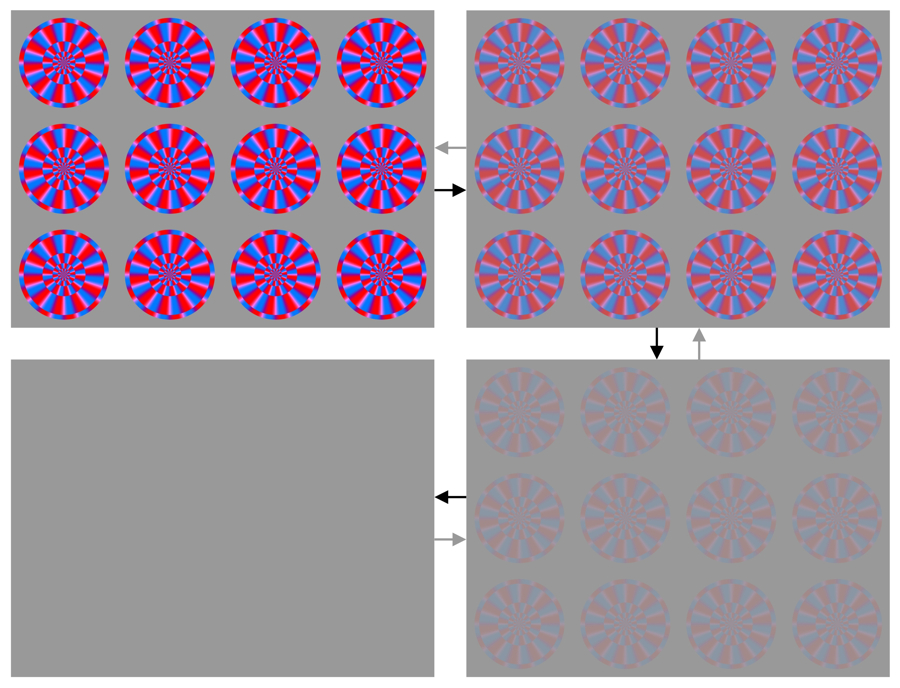
Copyright Akiyoshi Kitaoka 2013 (August 20)
Each disk appears to rotate clockwise during fading-in while counterclockwise during fading-out.
Copyright Akiyoshi Kitaoka 2013 (April 19)
Each disk appears to rotate counteclockwise during fading-in while clockwise during fading-out.
Copyright Akiyoshi Kitaoka 2013 (April 19)
Each disk appears to rotate counteclockwise during fading-in while clockwise during fading-out.
Copyright Akiyoshi Kitaoka 2013 (April 19)
Each disk appears to expand during fading-in while to contract during fading-out.
Copyright Akiyoshi Kitaoka 2013 (April 20)
"On-off rotating snakes: red and sky blue #1"
When fading in, each disk appears to rotate in the direction: black, red, white, sky blue, black. The direction is reversed when fading out.
Copyright Akiyoshi Kitaoka 2013 (April 30)
"On-off rotating snakes: red and sky blue #2"
When fading in, each disk appears to rotate in the direction: black, sky blue, white, red, black. The direction is reversed when fading out.
Copyright Akiyoshi Kitaoka 2013 (April 30)
9. Yanaka and Hirano (2011)
Yanaka and Hilano (2011) reported that this illusion is enhanced by mechanical shaking.
Each disk appears to rotate counterclockwise.
(Note that this movie is not their original)
References
Yanaka, K. and Hilano, T. (2011). Mechanical shaking system to enhance
"Optimized Fraser–Wilcox Illusion Type V". Perception, 40, ECVP
Abstract Supplement, page 171.
10. Yanaka (2012)
Yanaka (2012) reported that this illusion is enhanced by viewing images under dark illumination.
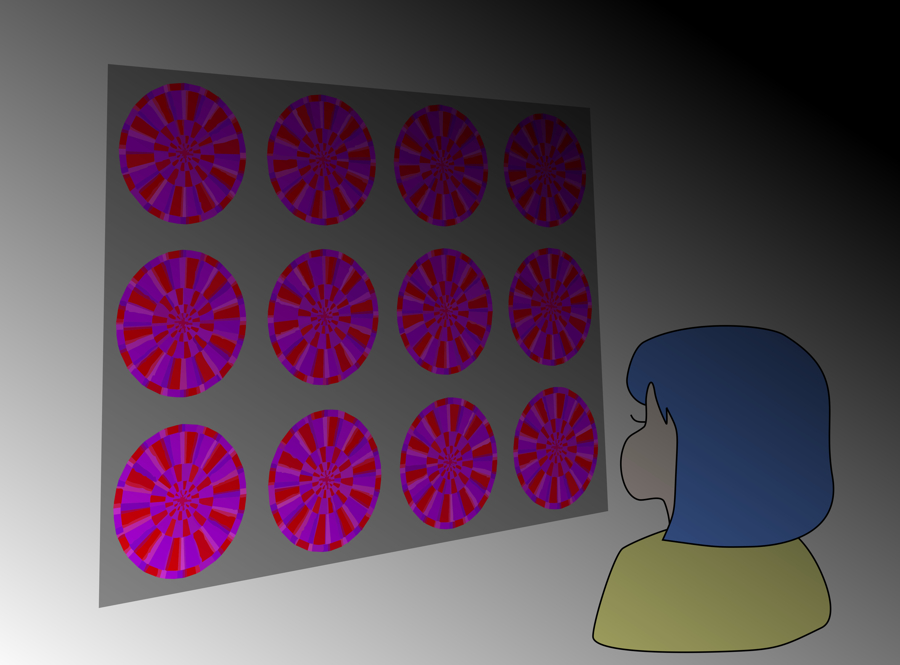
References
Yanaka, K. (2012). Enhancement of the optimized Fraser-Wilcox illusion Type V by swinging the image. Talk in the 5th Illusion Workshop, Meiji University, Tokyo, Japan, September 18, 2012.
11. Kitaoka (2013)
In 2013, Kitaoka (ECVP2013) found that Yanaka’s darkening enhancement is accompanied by a reversal of illusion: i.e., the direction under dark condition is “red → magenta (light red-purple) → purple → dark purple → red”.
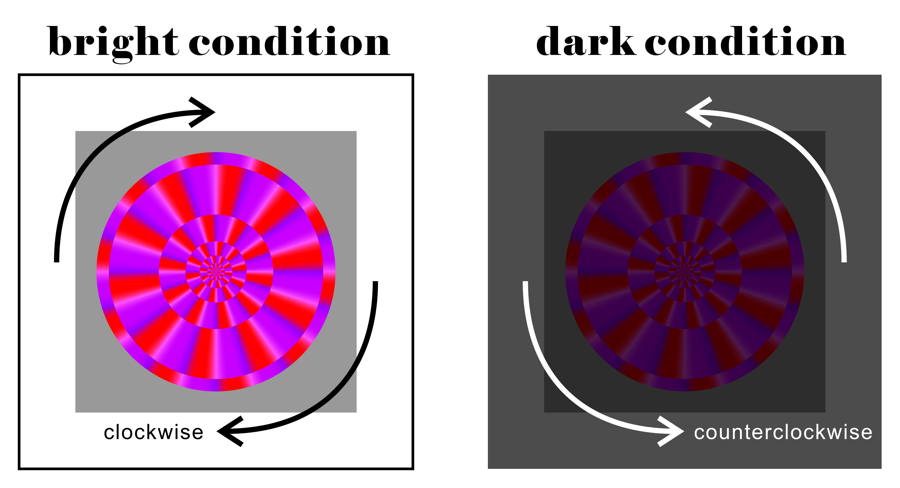
References
Kitaoka, A. (2013). Invisible color and visible color: Mystery of color the brain feels. Talk in the Shizuoka Science Museum Ru-Ku-Ru, Shizuoka, Japan, January 13, 2013. Talk
12. Kitaoka (2013)
In 2013, Kitaoka (ECVP2013) found that combination of a long wavelength color and a short one makes the illusions.
Illusory motion depending on the combination of colors


"Rotating red-and-purple disks"
Each disk appears to rotate clockwise on a bright display, while it appears to rotate counterclockwise with a printed image under dark illumination.
Copyright Akiyoshi Kitaoka 2013 (February 6)
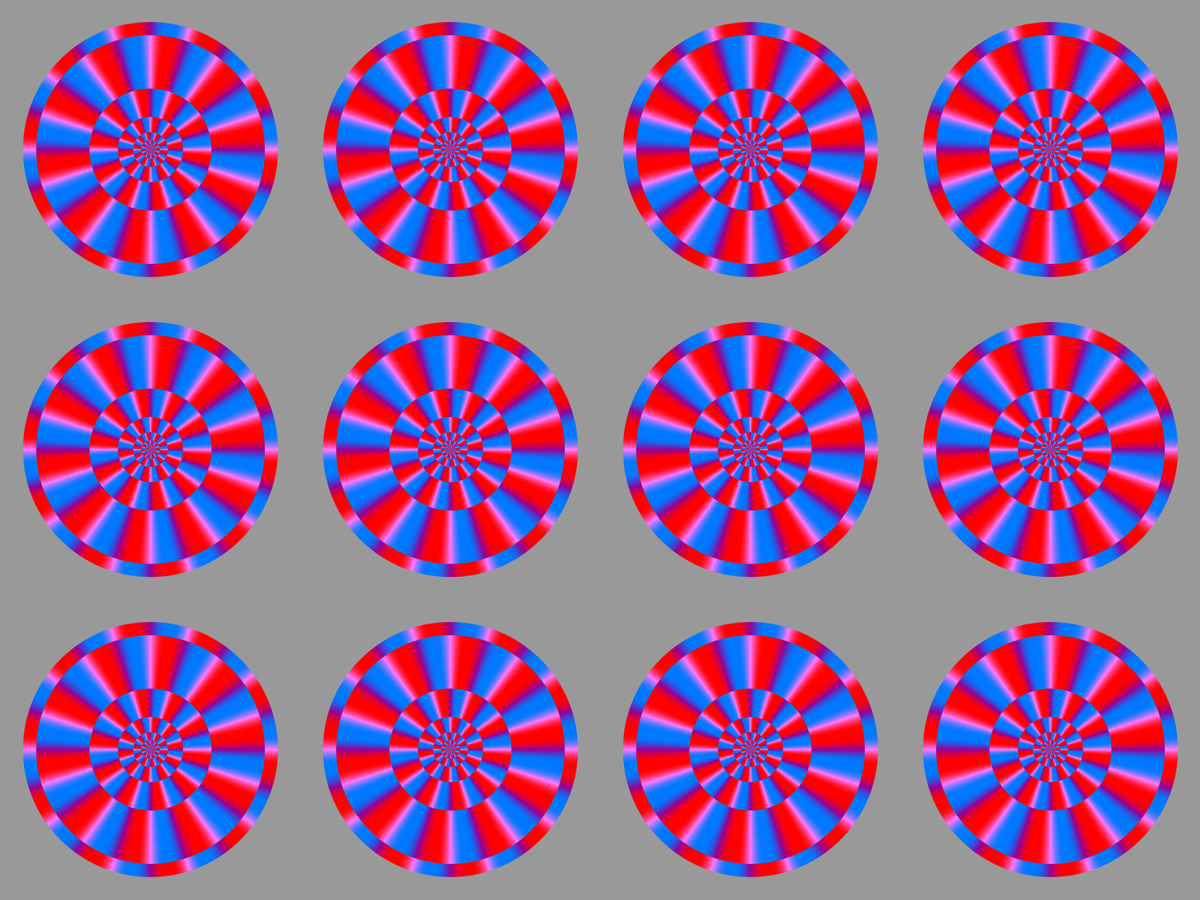
"Rotating red-and-cyan disks"
Each disk appears to rotate clockwise on a bright display, while it appears to rotate counterclockwise with a printed image under dark illumination.
Copyright Akiyoshi Kitaoka 2013 (February 1)

"Rotating red-and-cyan disks 2"
Each disk appears to rotate clockwise on a bright display, while it appears to rotate counterclockwise with a printed image under dark illumination.
Copyright Akiyoshi Kitaoka 2013 (February 6)
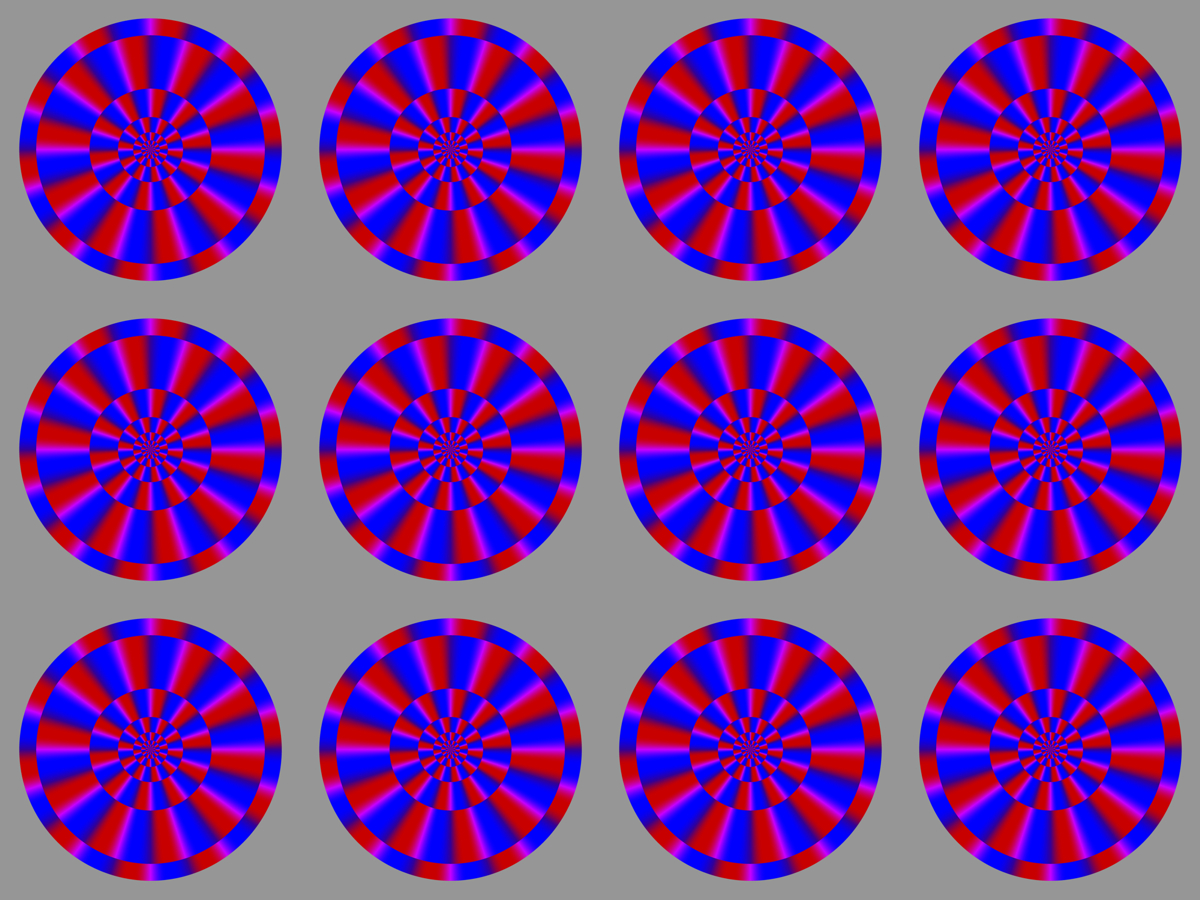
"Rotating red-and-blue disks"
Each disk appears to rotate clockwise on a bright display, while it appears to rotate counterclockwise with a printed image under dark illumination.
Copyright Akiyoshi Kitaoka 2013 (January 29)
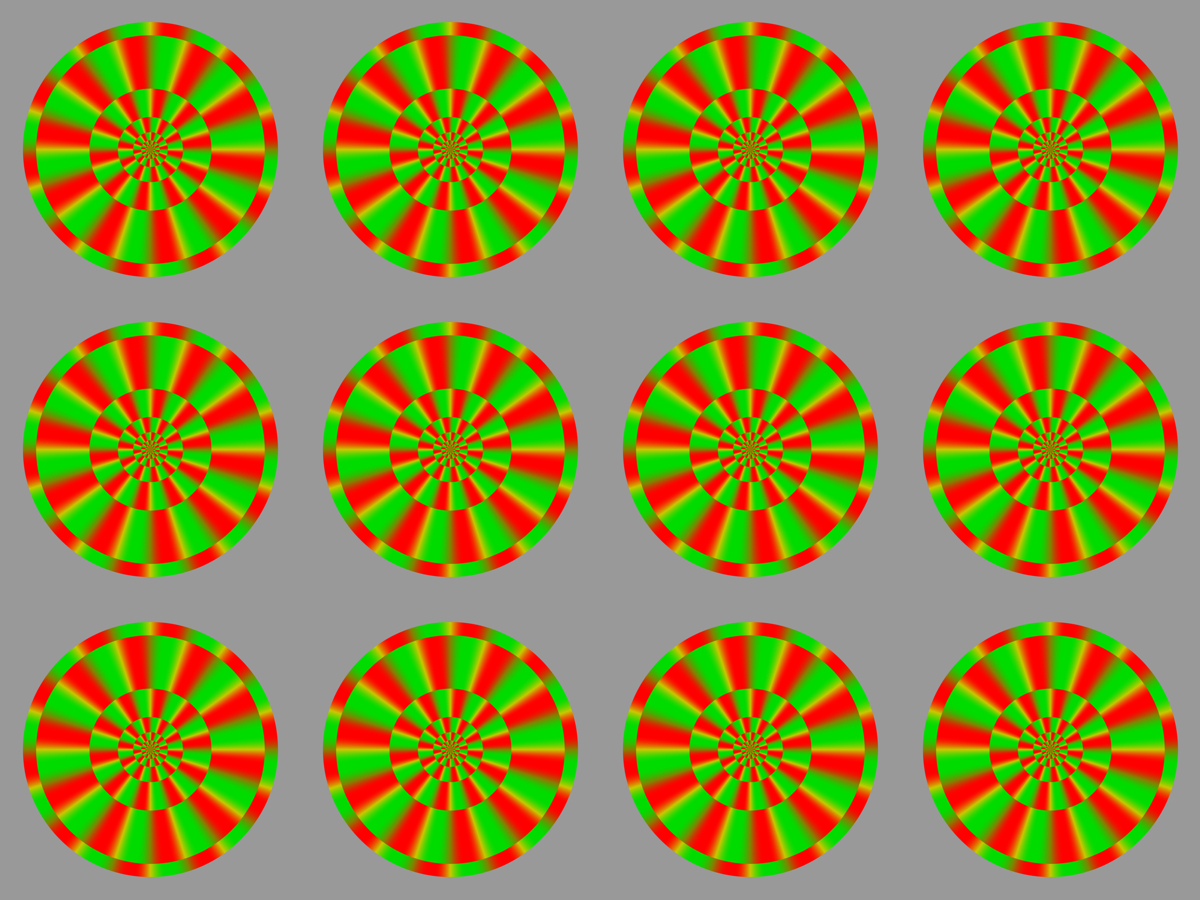
"Rotating red-and-green disks"
Each disk appears to rotate clockwise on a bright display, while it appears to rotate counterclockwise with a printed image under dark illumination.
Copyright Akiyoshi Kitaoka 2013 (January 29)
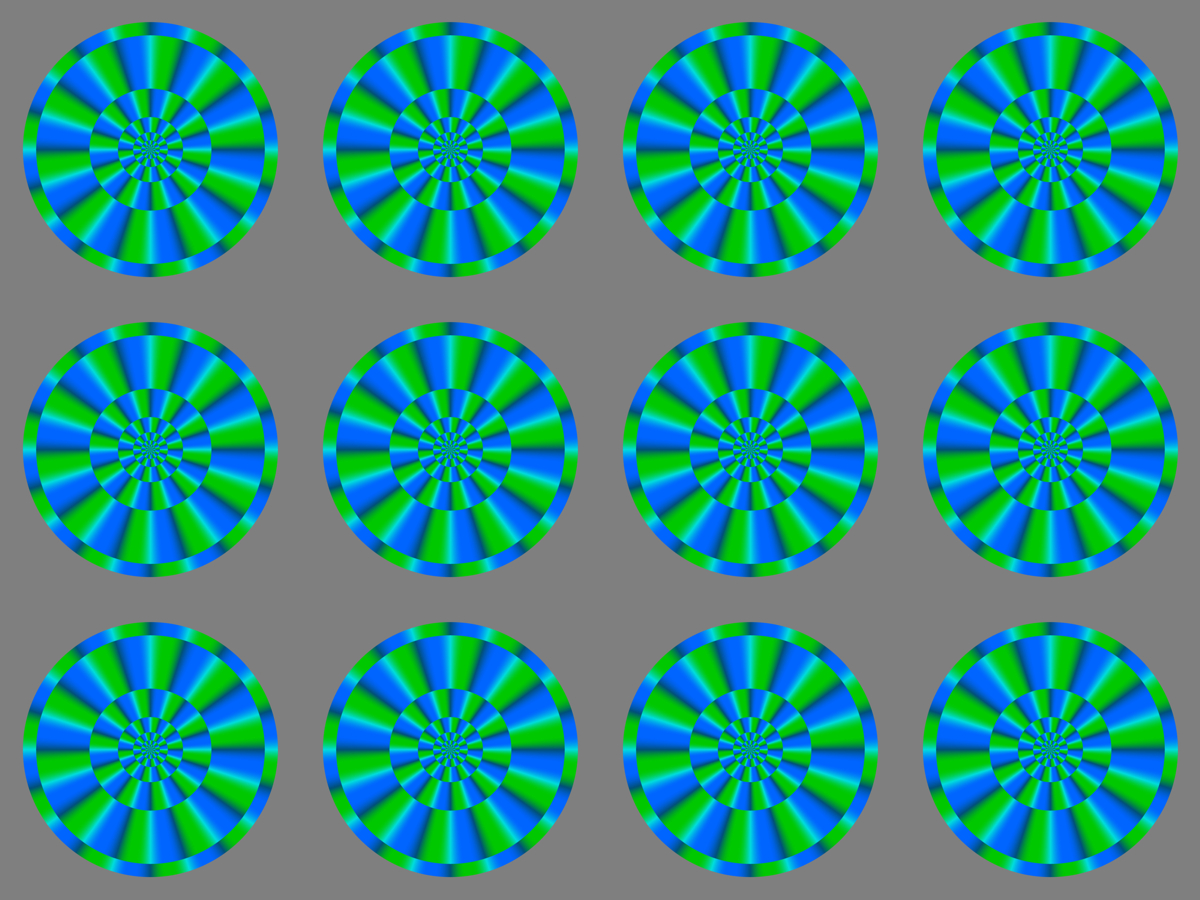
"Rotating blue-and-green disks"
Each disk appears to rotate clockwise on a bright display, while it slightly appears to rotate counterclockwise with a printed image under dark illumination.
Copyright Akiyoshi Kitaoka 2013 (February 6)
13. Kitaoka (2013)
In 2013, Kitaoka (ECVP2013) found that increasing or decreasing illumination makes the illusions.
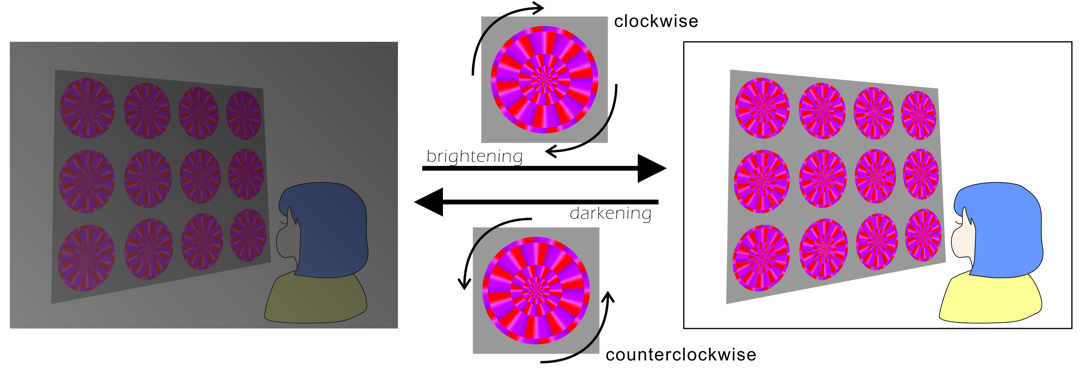
14. Kitaoka (2013)
It is suggested that this ‘luminance change-induced’ motion* might generate
the color-dependent Fraser-Wilcox illusion, being triggered by saccades,
blinks, flickering or shaking the images.
*The luminance change-induced’ motion includes the reverse phi phenomenon
(Anstis, 1970; Anstis and Rogers, 1975) and the phenomenal phenomena (Gregory
and Heard, 1983). Directions of illusory motion depending on the changes
of luminance are shown in the right (Kitaoka, 2006).
References
Anstis S M, 1970 “Phi movement as a subtraction process” Vision Research 10 1411-1430
Anstis S M, Rogers B J, 1975 “Illusory reversal of visual depth and movement
during changes of contrast” Vision Research 15 957-961
Gregory R L, Heard P F, 1983 “Visual dissociations of movement, position,
and stereo depth: some phenomenal phenomena” Quarterly Journal of Experimental
Psychology 35A 217-237
Kitaoka, A. (2006). Configurational coincidence among six phenomena: A
comment on van Lier and Csathó (2006). Perception,
35, 799-806. animations --- PDF
"Rotating gray-scale disks (movie)"
Disks appear to rotate clockwise or counterclockwise.
Copyright Akiyoshi Kitaoka 2013 (February 15)
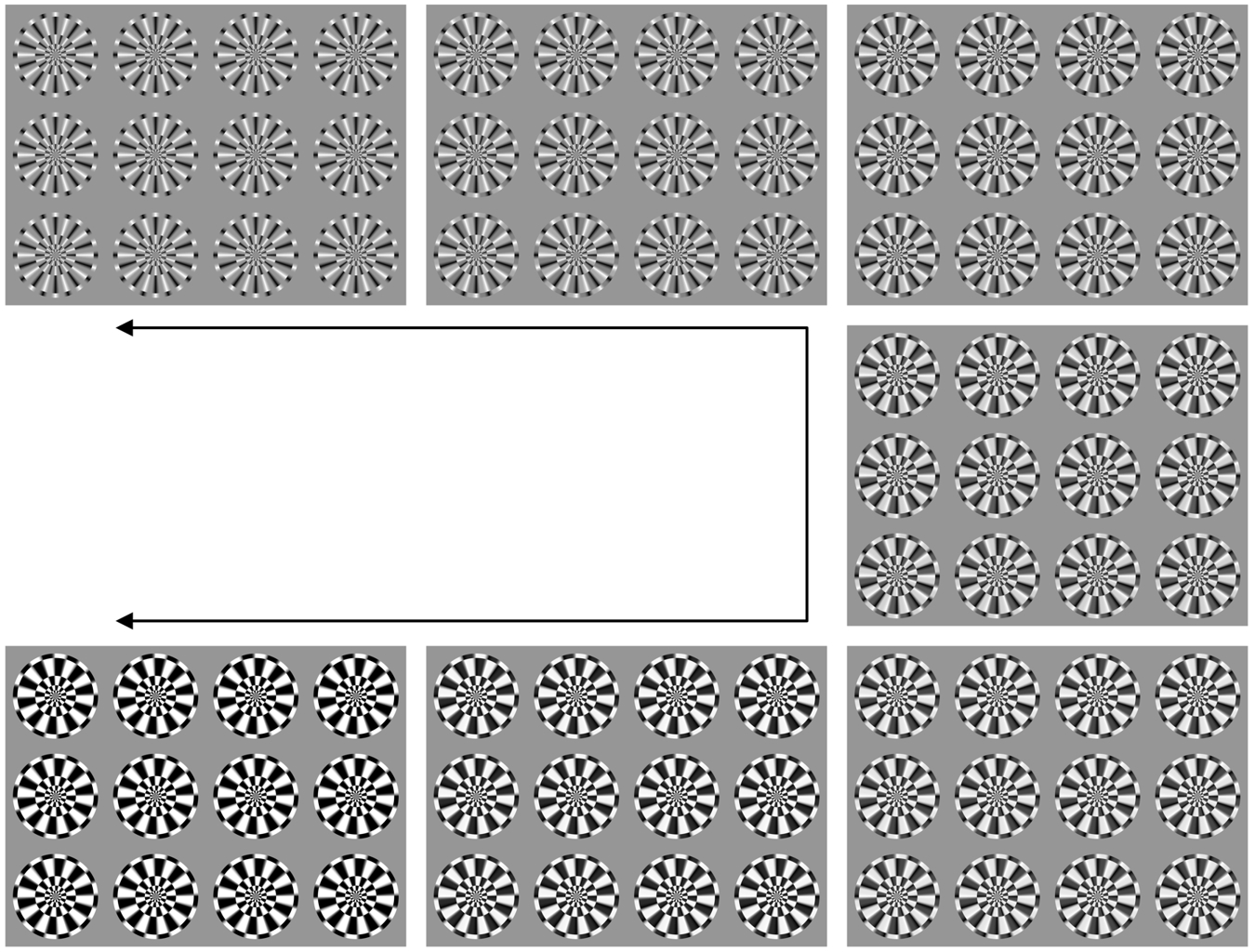
Configurational coincidence among six phenomena: A comment to van Lier
and Csathó (2006)
Kitaoka, A. (2006). Configurational coincidence among six phenomena: A comment on van Lier and Csathó (2006). Perception, 35, 799-806. animations --- PDF
Adobe Flash Player is necessary to play animations on this page.
Animation 1
Reversed phi movement (Anstis and Rogers 1975). There are four rectangles, each of which is flanked by thin lines that are dark or light. When the luminance of the rectangles decreases and that of the background increases accordingly, the upper two appear to converge in motion while the lower two appear to go apart in motion. On the other hand, when the luminance of the rectangles increases and that of the background decreases accordingly, the upper two appear to go apart in motion while the lower two appear to approach each other in motion. In sum, the direction of apparent motion is from the dark flank to the neighboring part that goes darkening or from the light flank to the neighboring part that goes brightening. Although the rectangles are aligned vertically, the apparent positional displacement occurs in the opposite direction to motion. If observers cross-fuse (uncross-fuse) the right and left rectangles, the upper rectangle appears to be in front of (behind) the lower one when they are dark.
Animation 2
The illusory motion investigated by Gregory and Heard (1983). This appearance is quite similar to Animation 1. The only configurational difference from the reversed phi movement is that the luminance of the rectangles is constant.
Animation 3
The illusory motion mentioned by Gregory and Heard (1983), in which the luminance of the rectangles dynamically changes while that of the surround is constant. This appearance is quite similar to Animations 1 and 2.
Animation 4
Phi movement (Anstis and Rogers 1975). For panel (a), dark stationary rectangles are placed on a bright stationary background. When the luminance of the right flank of each rectangle increases and that of the left flank decreases, the rectangle appears to shift leftward in motion as well as in position. Conversely, the luminance of the right flank decreases and that of the left flank increases, the rectangle appears to shift rightward in motion and position. If observers cross-fuse (uncross-fuse) the right and left rectangles, the fused rectangle appears to be in front (behind) when the right flank of the right rectangle are dark and the left flank of the left rectangle are dark. For panel (b), bright rectangles are placed on a dark background. In this case, phenomena are the reversal of panel (a).
(a) (b)
(a) Flash(swf) --- QuickTime(mov)
(b) Flash(swf) --- QuickTime(mov)
Animation 5
Consistency between the reversed phi movement and stereopsis (Anstis and Rogers 1975). In this animation, there are two phases in motion, in which the upper-left and the lower-right rectangles are one eighth phase in advance of the upper-right and the lower-left rectangles. For example, when the luminance of the rectangles increases, the upper-left rectangle appear to go leftward followed by the upper-right one, while the lower-right rectangle appear to go leftward followed by the lower-left one. In this period, the cross-fused (uncross-fused) upper rectangle appears to be in front (behind) as compared with the cross-fused (uncross-fused) lower rectangle.
Animation 6
Consistency between the apparent motion and Café-Wall-like tilt illusions (van Lier and Csathó 2005). According to dynamic changes in luminance gradient, the flanks of the rectangle appears to tilt dynamically. (a) The luminance gradient given to both flanks is dynamically changed while the dark-gray rectangle and the light-gray background are stationary. The dark part of the gradient appears to shift outward in motion and position while the bright part appears to shift inward in motion and position. This distortion agrees with the tilt illusion. (b) The luminance gradient given to the rectangle is dynamically changed while the dark flanks and the gray background are stationary. At the dark part of the gradient, the neighboring part of flanks appears to shift inward in motion and position, while at the bright part of the gradient, the neighboring part of flanks appears to shift outward in motion and position. This distortion agrees with the tilt illusion.
(a) (b)
(a) Flash(swf) --- QuickTime(mov)
(b) Flash(swf) --- QuickTime(mov)
Animation 7
Inconsistency between the apparent motion and Café-Wall-like tilt illusions. According to dynamic changes in homogenous areas, the flanks of the rectangle appears to tilt dynamically. (a) The luminance of the homogeneous rectangle is dynamically changed while the flanks with luminance gradient and the gray background are stationary. The darkening rectangle appears to attract the dark parts of the flanks inward in motion while the brightening rectangles appears to attract the light parts of the flanks inward in motion. This distortion disagrees with the tilt illusion. (b) The luminance of the homogeneous flanks is dynamically changed while the rectangle with luminance gradient and the gray background are stationary. At the dark part of the gradient, brightening flanks appears to shift inward in motion, while at the bright part of the gradient, darkening flanks appears to shift inward in motion. This distortion disagrees with the tilt illusion
(a) (b)
(a) Flash(swf) --- QuickTime(mov)
(b) Flash(swf) --- QuickTime(mov)
Animation 8
Demonstration of the apparent motion in the three elemental spatio-temporal configurations (Figure 6). The behaviors in (a), (b) and (g) are summarized in Figure 6a (off-center line-type configuration); those in (c), (d) and (h) are in Figure 6b (on-center line-type configuration); and those in (e), (f) and (i) are summarized in Figure 6c (edge-type configuration). For further explanations, see the text.
(a) (b)
(a) Flash(swf) --- Quicklime(mov)
(b) Flash(swf) --- QuickTime(mov)
(c) (d)
(c) Flash(swf) --- QuickTime(mov)
(d) Flash(swf) --- QuickTime(mov)
(e) (f)
(e) Flash(swf) --- QuickTime(mov)
(f) Flash(swf) --- QuickTime(mov)
(g) (h) (i)
(g) Flash(swf) --- QuickTime(mov)
(h) Flash(swf) --- QuickTime(mov)
(i) Flash(swf) --- QuickTime(mov)
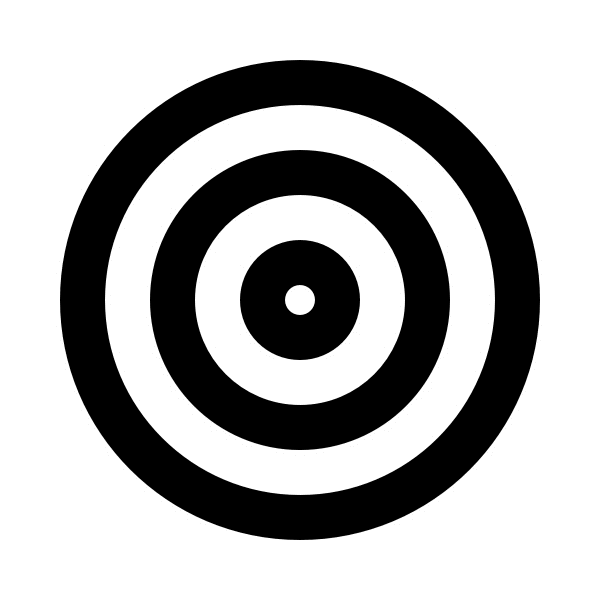
Copyright Akiyoshi Kitaoka 2010 (April 3)
Nice demos
Arthur Shapiro's Illusions and Demonstration
Directions of illusory motion depending on changes of luminance in each
area
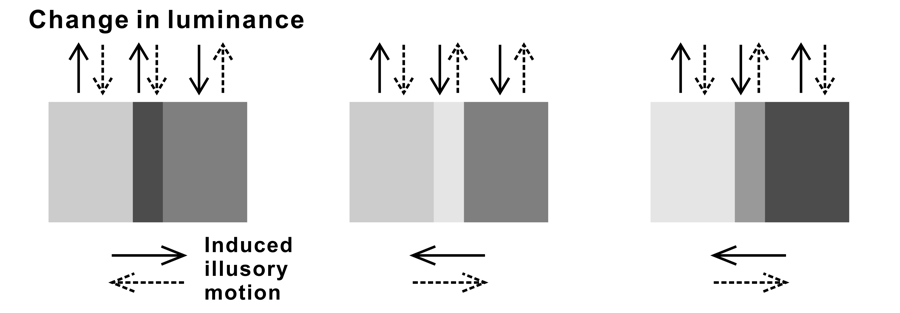

Involvement of the Purkinje shift is suggested. Short wavelength color
appears to be relatively bright under a dark condition. Decreasing illumination
makes short wavelength color relatively bright. This might induce the luminance
change-dependent motion illusion and show the color-dependent Fraser-Wilcox
illusion.
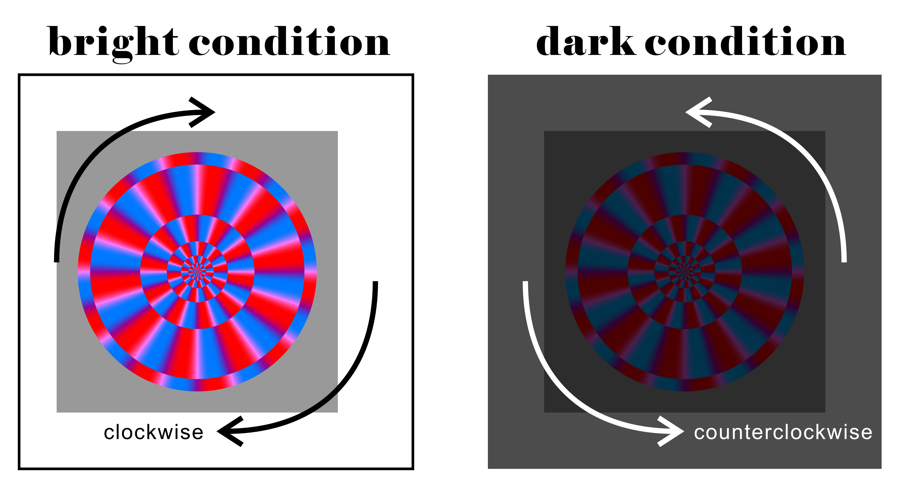
References
Kanazawa, S., Kitaoka, A., and Yamaguchi, M. K. (2013). Infants see illusory motion in static figures. Perception, 42, 828-834.
Ashida, H., Kuriki, I., Murakami, I., Hisakata, R. and Kitaoka, A. (2012). Direction-specific fMRI adaptation reveals the visual cortical network underlying the "Rotating Snakes" illusion. NeuroImage, 61, 1143–1152.
Otero-Millan, J.,Macknik, S. L., and Martinez-Conde, S. (2012). Microsaccades and Blinks Trigger Illusory Rotation in the “Rotating Snakes” Illusion. Journal of Neuroscience, 32, 6043-6051.
Stevanov, J., Marković, S., and Kitaoka, A. (2012). Aesthetic valence of visual illusions. i-Perception, 3(2), 112–140.
Tomimatsu E., Ito, H., Sunaga, S., & Remijn, G. B. (2011). Halt and recovery of illusory motion perception from peripherally viewed static images. Attention, Perception, & Psychophysics, 73, 1823-1832.
Tomimatsu, E., Ito, H., Seno, T., and Sunaga, S. (2010). The ‘rotating snakes’ in smooth motion do not appear to rotate. Perception, 39, 721-724.
Fermüller, C., Ji, H., and Kitaoka, A. (2010). Illusory motion due to causal time filtering. Vision Research, 50, 315–329.
Billino, J., Hamburger, K., & Gegenfurtner, K. R. (2009). Age effects on the perception of motion illusions. Perception, 38, 508-521.
Kuriki, I., Ashida, H., Murakami, I., and Kitaoka, A. (2008). Functional brain imaging of the Rotating Snakes illusion by fMRI. Journal of Vision, 8(10):16, 1-10.
Hisakata, R. and Murakami, I. (2008) The effects of eccentricity and retinal illuminance on the illusory motion seen in a stationary luminance gradient. Vision Research, 49, 1940-1948.
Beer, A. L., Heckel, A. H. and Greenlee, M. W. (2008) A motion illusion reveals mechanisms of perceptual stabilization. PLoS ONE, 3(7): e2741, 1-7. doi:10.1371/journal.pone.0002741
Chi, M-T., Lee, T-Y., Qu, Y., and Wong, T-T. (2008) Self-Animating Images: Illusory Motion Using Repeated Asymmetric Patterns. ACM Transaction on Graphics (Proceedings of SIGGRAPH 2008), 27, No.3.
Murakami, I., Kitaoka, A. and Ashida, H. (2006) A positive correlation between fixation instability and the strength of illusory motion in a static display. Vision Research, 46, 2421-2431.
Conway, R. B., Kitaoka, A., Yazdanbakhsh, A., Pack, C. C., and Livingstone, M. S. (2005) Neural basis for a powerful static motion illusion. Journal of Neuroscience, 25, 5651-5656.
Backus, B. T. and Oruç, I. (2005) Illusory motion from change over time in the response to contrast and luminance. Journal of Vision, 5, 1055-1069.
Kitaoka, A. and Ashida, H. (2003) Phenomenal characteristics of the peripheral drift illusion. VISION (Journal of the Vision Society of Japan), 15, 261-262. PDF
Naor-Raz, G. and Sekuler, R. (2000) Perceptual dimorphism in visual motion from stationary patterns. Perception, 29, 325-335.
Faubert, J. and Herbert, A. M. (1999) The peripheral drift illusion: A motion illusion in the visual periphery. Perception, 28, 617-621.
Fraser, A. and Wilcox, K. J. (1979) Perception of illusory movement. Nature, 281, 565-566.
Visual delay-dependent motion illusion
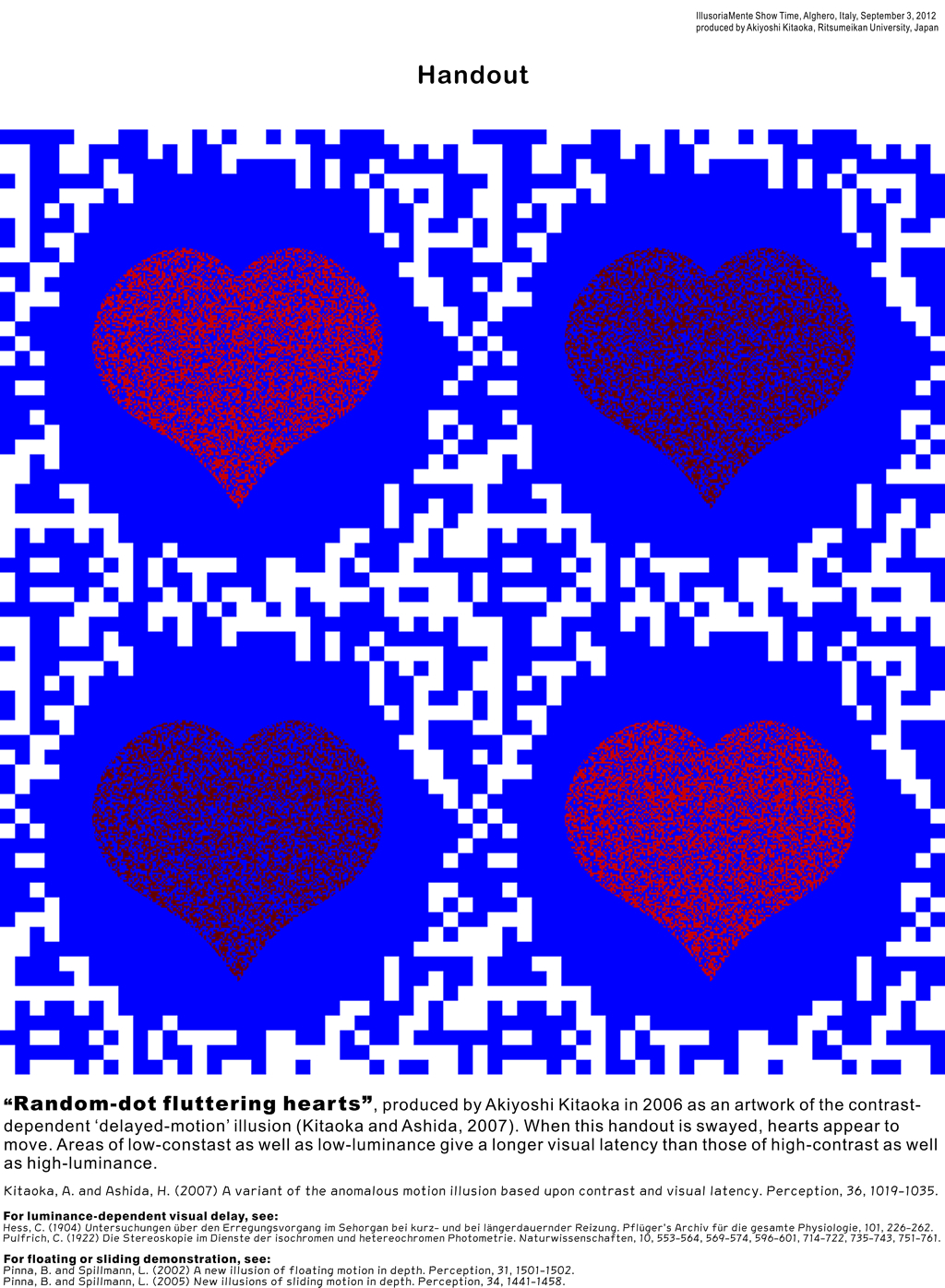
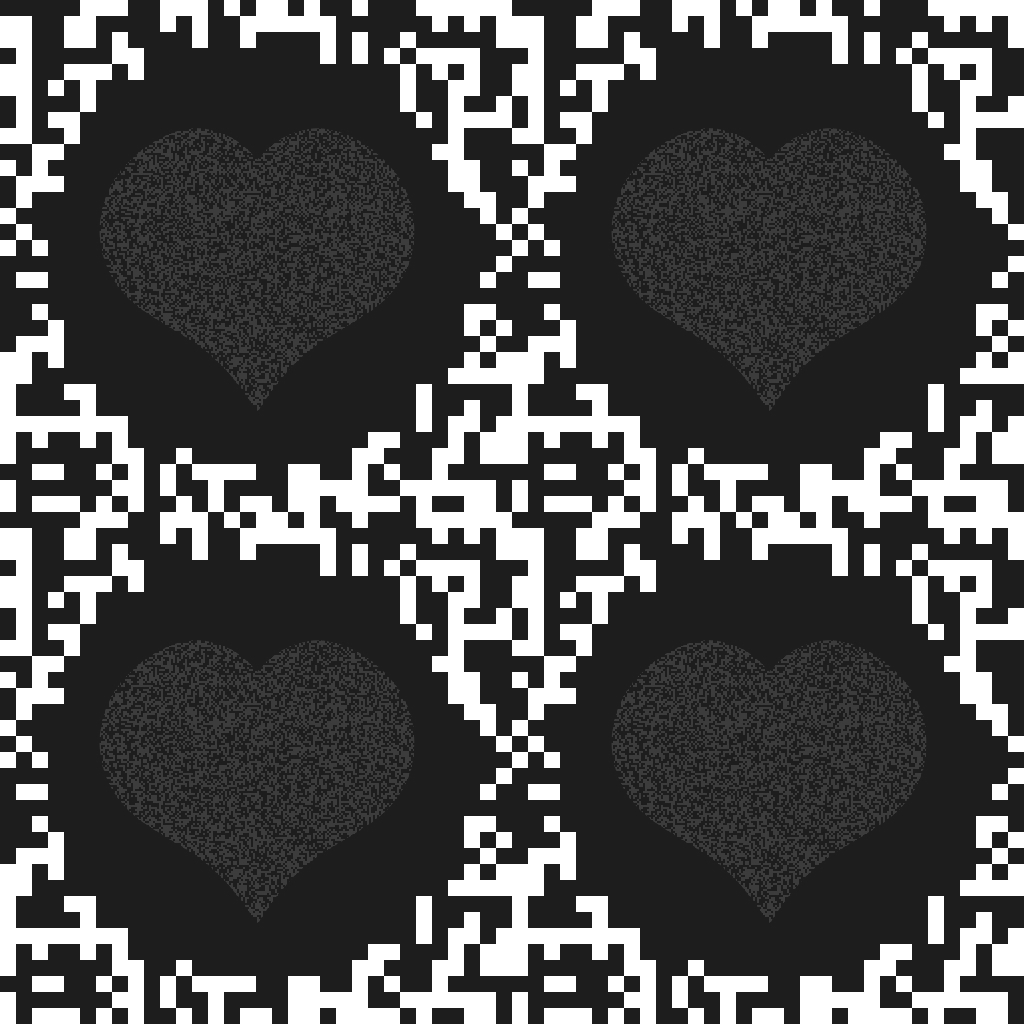
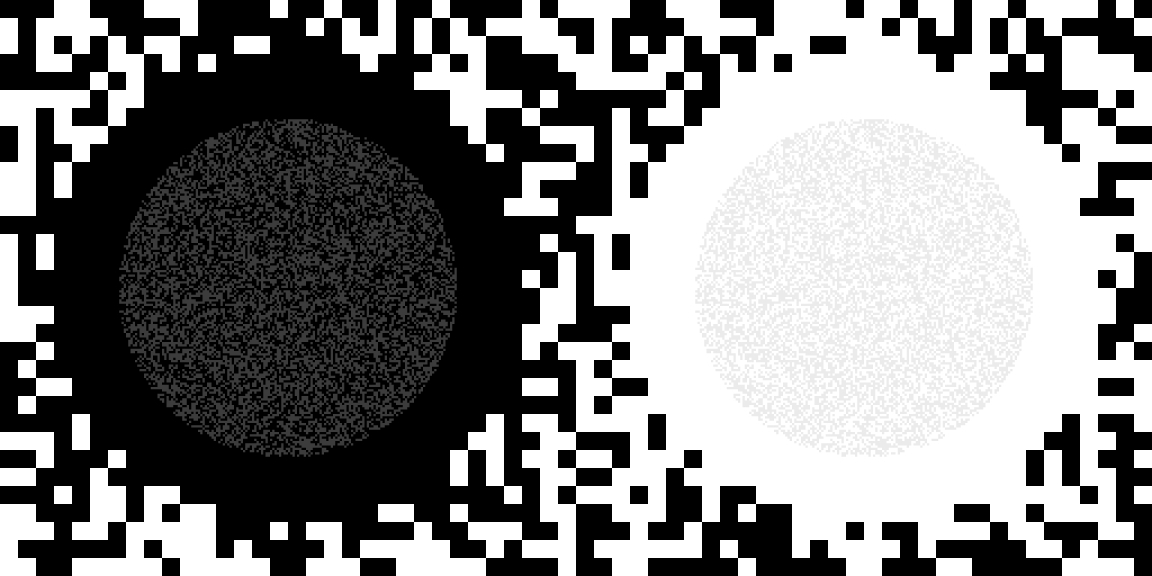
1. High-luminance parts show shorter latency than low-luminance part.
2. High-contrast parts show shorter latency than low-contrast part. <our finding!>
Kitaoka, A. and Ashida, H. (2007) A variant of the anomalous motion illusion based upon contrast and visual latency. Perception, 36, 1019-1035. PDF
中山(2008)によると、踊るハートは赤が重要。青不要。ピンクはダメ。
中山明子 (2008) 「踊るハート」錯視(1844)と「踊るハート達」錯視(2006)の比較検証 2008年度立命館大学文学部(人文学科心理学専攻)卒業論文
cf. fluttering-heart illusion

(Helmholtz, 1867; Nguyen-Tri and Faubert 2003; von Grünau 1975a, 1975b, 1976; von Kries 1896)
References
Helmholtz, H. von (1856, 1860, 1866,
1867) Handbuch der Physiologischen Optik. Leipzig: Voss. Part I (1856),
Part II (1860), Part III (1866). The first two parts were published in
the same volume as the third part in 1866. This was called the first
edition according to Robinson (1972). In many case, “1867” is preferred
for citation as follows. Helmholtz, H. von. (1867). Handbuch der
physiologischen Optik. Leipzig: Voss. Translated by J P C Southall of
the third German edition (1909-1911) was published as Treatise on
Physiological Optics, New York: Dover (1924-1925, 1962). Edited by N.
Wade, Helmholtz's Treatise on Physiological Optics, Bristol: Thoemmes
(2000). The following information was taken from Wade (2004).
Helmholtz H, 1867 "Handbuch der physiologischen Optik", in Allgemeine
Encyklopädie der Physik volume 9, Ed. G Karsten (Leipzig: Voss)
Helmholtz H, 1896 Handbuch der physiologischen Optik 2nd edition (Hamburg: Voss)
Helmholtz H, 1909 Handbuch der physiologischen Optik volume 1, 3rd
edition, Eds A Gullstrand, J von Kries, W Nagel (Hamburg: Voss)
Helmholtz H, 1910 Handbuch der physiologischen Optik volume 3, 3rd
edition, Eds A Gullstrand, J von Kries, W Nagel (Hamburg: Voss)
Helmholtz H, 1911 Handbuch der physiologischen Optik volume 2, 3rd
edition, Eds A Gullstrand, J von Kries, W Nagel (Hamburg: Voss)
Helmholtz H, 1924 Helmholtz's Treatise on Physiological Optics volume 1,
translated by J P C Southall (New York: Optical Society of America)
Helmholtz H, 1925 Helmholtz's Treatise on Physiological Optics volume 2,
translated by J P C Southall (New York: Optical Society of America)
Helmholtz H, 1925 Helmholtz's Treatise on Physiological Optics volume 3,
translated by J P C Southall (New York: Optical Society of America)
Helmholtz H, 2000 Helmholtz's Treatise on Physiological Optics (3 volumes) translated by J P C Southall (Bristol: Thoemmes)
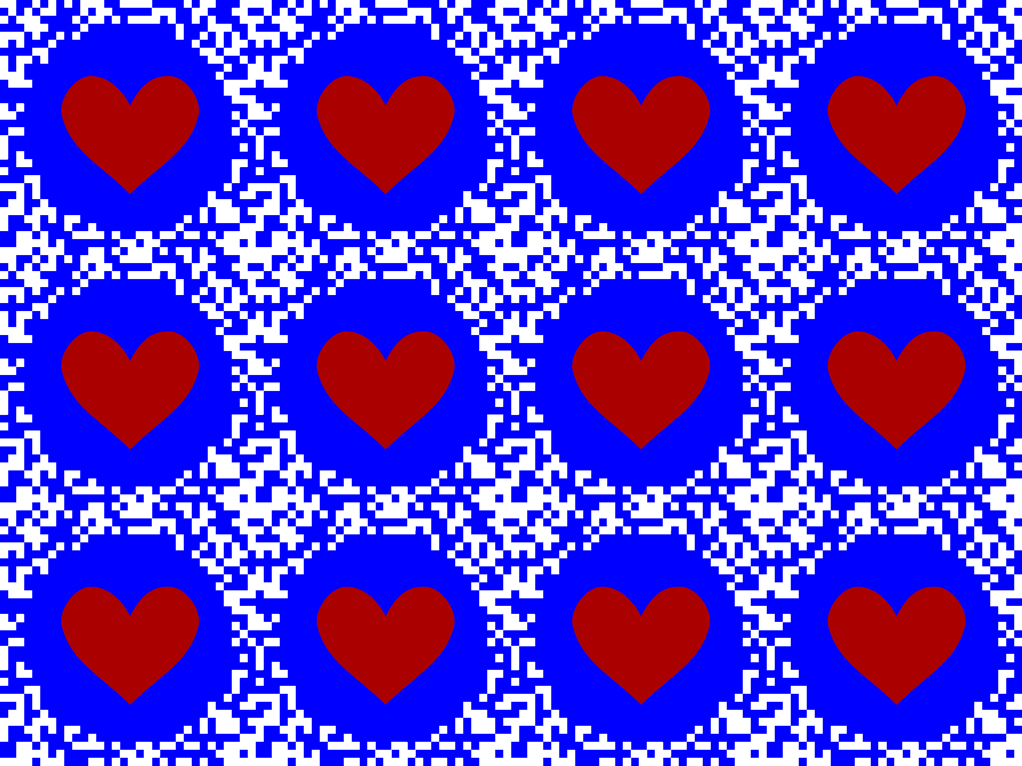
"Fluttering red hearts in front of the blue background 3"
Hearts appear to move when the image is moved or your pair of glasses are moved. This illusion is enhanced in a dark condition or in the mesopic vision.
Copyright Akiyoshi Kitaoka 2013 (February 15)
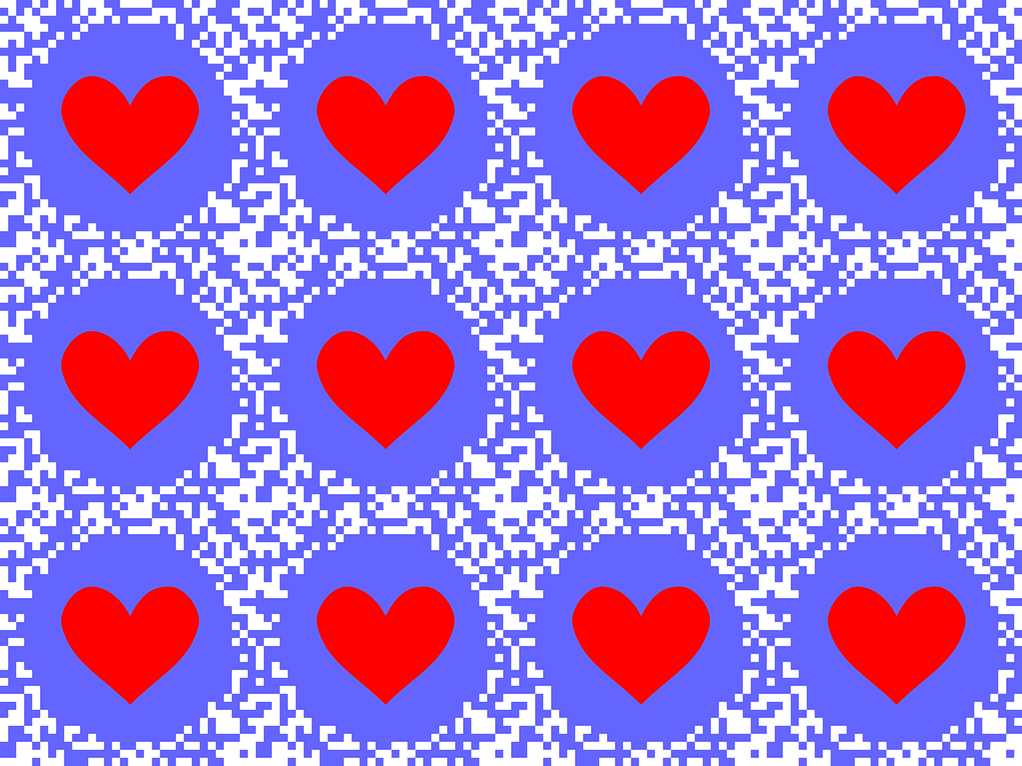
"Fluttering red hearts in front of the blue background"
Hearts appear to move when the image is moved or your pair of glasses are moved. This illusion is enhanced in a dark condition or in the mesopic vision.
Copyright Akiyoshi Kitaoka 2013 (January 18)
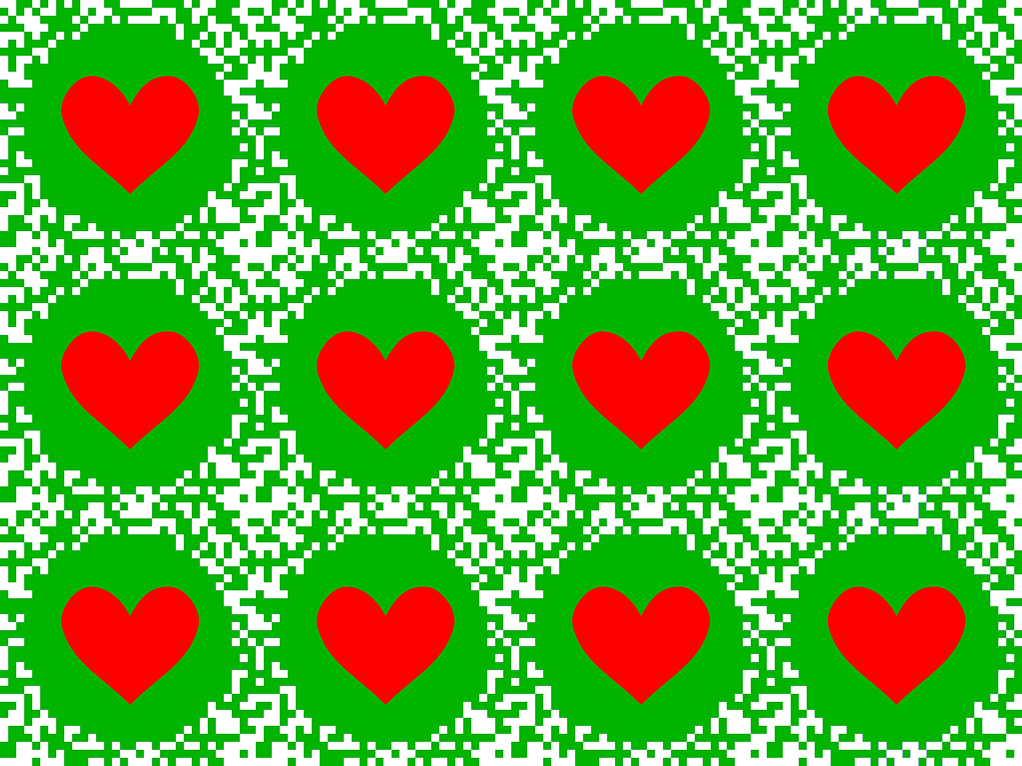
"Fluttering red hearts in front of the green background"
Hearts appear to move when the image is moved or your pair of glasses are moved. This illusion is enhanced in a dark condition or in the mesopic vision.
Copyright Akiyoshi Kitaoka 2013 (January 21)
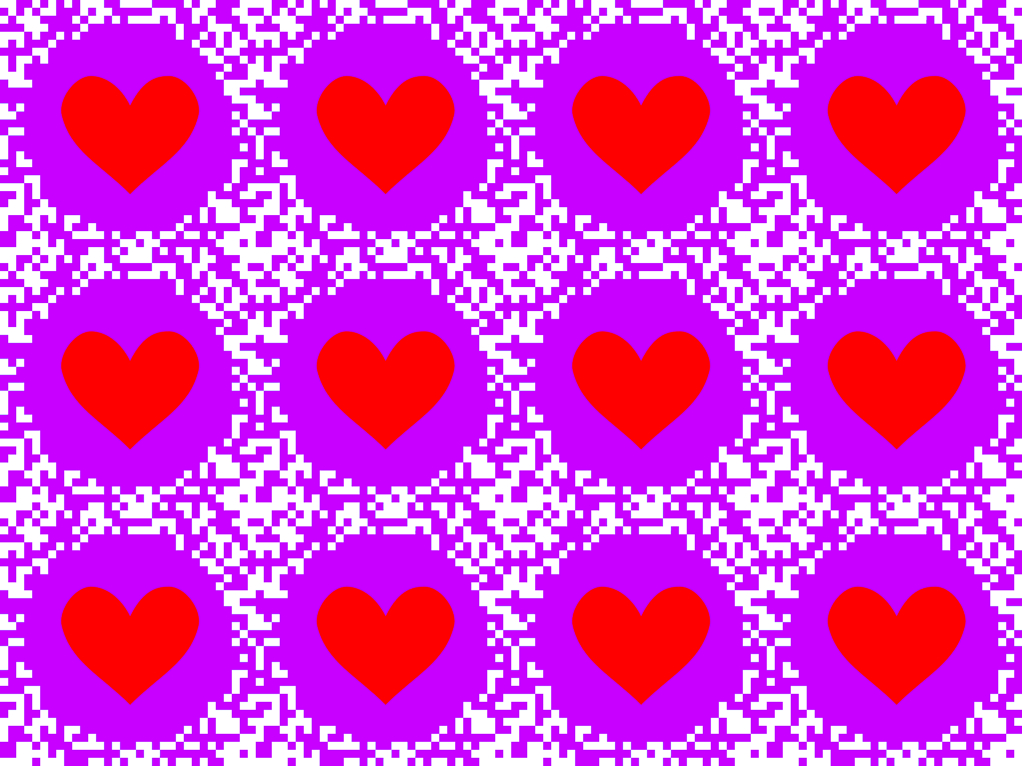
"Fluttering red hearts in front of the red-purple background"
Hearts appear to move when the image is moved or your pair of glasses are moved. This illusion is enhanced in a dark condition or in the mesopic vision.
Copyright Akiyoshi Kitaoka 2013 (January 16)
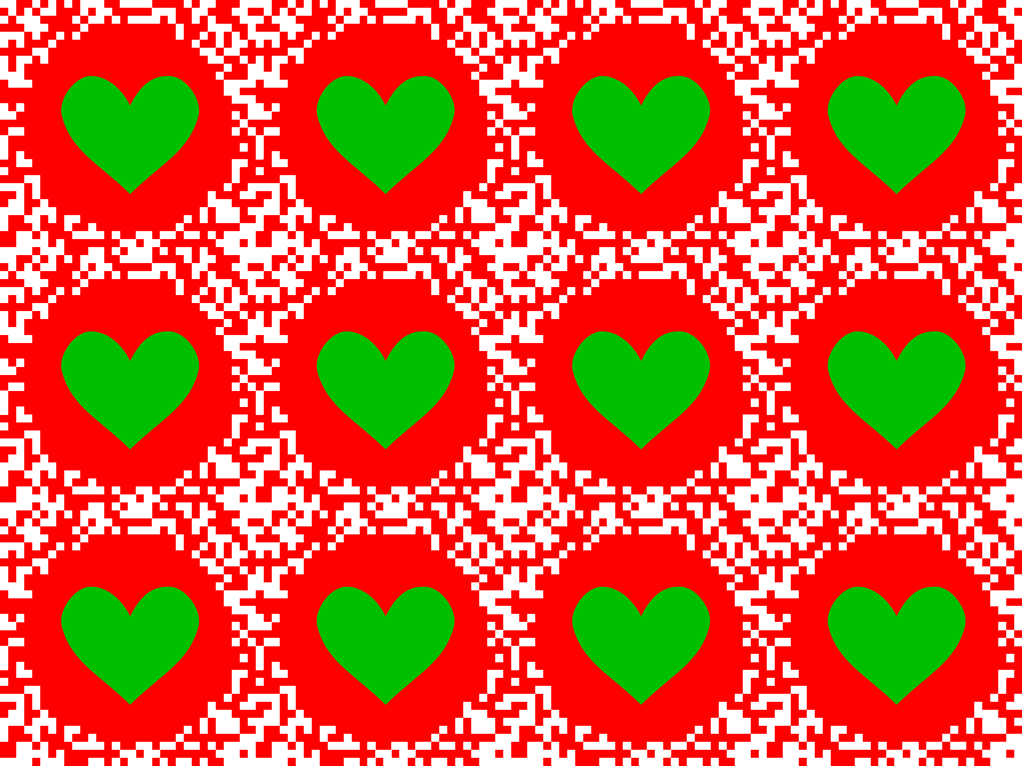
"Fluttering green hearts in front of the red background"
Hearts appear to move when the image is moved or your pair of glasses are moved. This illusion is enhanced in a dark condition or in the mesopic vision.
Copyright Akiyoshi Kitaoka 2013 (February 15)
<色の錯視クイズ>
左のハートと物理的に同じ色は(1)(2)(3)のうちどれでしょう。
問1
問2
問3
問4 
問5 
問6
問7
問8
問9
問10
2012/8/17
ムンカー錯視を用いた作品「赤の渦巻き」↓
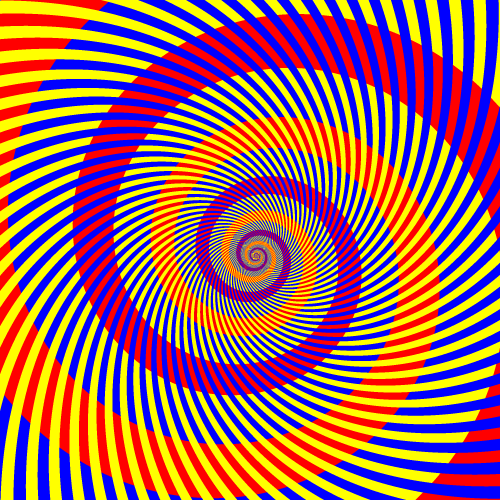
赤紫がかった赤い螺旋とオレンジ色がっかった赤い螺旋があるように見えるが、どちらも同じ赤である。
Copyright A.Kitaoka 2002
ムンカー錯視を用いた作品「緑の渦巻き」↓
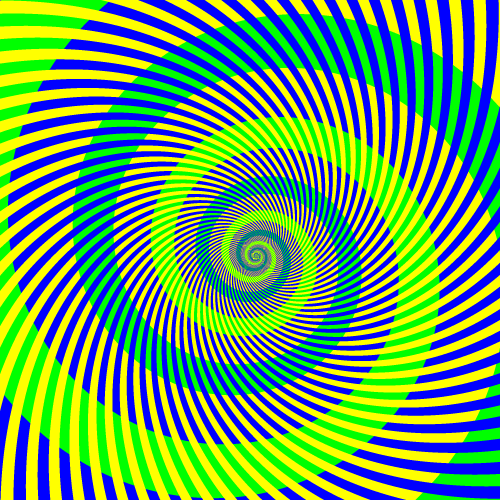
黄緑の螺旋と青緑の螺旋があるように見えるが、どちらも同じ緑である。
Copyright A.Kitaoka 2002
ムンカー錯視を用いた作品「水色と黄緑の渦巻き」↓
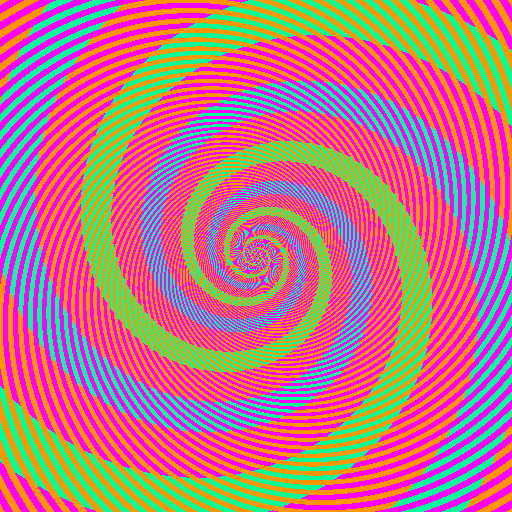
水色の螺旋と黄緑の螺旋があるように見えるが、どちらも同じ色(r = 0, g = 255, b = 150)である。この色の錯視はモニエ・シェベル錯視に近いと思うが、彼らの理論には合わないのかもしれない。
Copyright A.Kitaoka 2003
ムンカー錯視(Munker illusion)
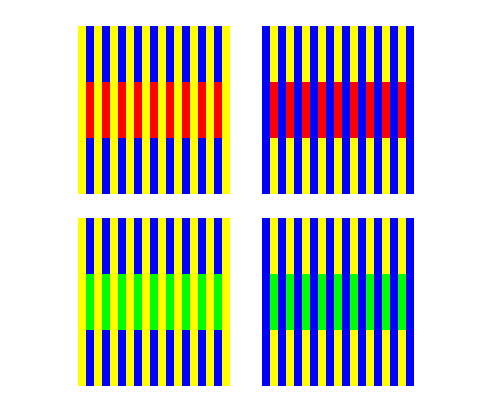
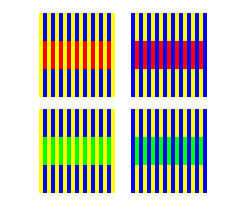
黄と青の縞の青部分に赤を乗せるとオレンジ色に見え、黄部分に赤を乗せると赤紫がかって見える。緑を乗せるとそれぞれ黄緑と青緑に見える。高空間周波数図形で錯視量が多い。
Munker, H. (1970) Farbige Gitter, Abbildung auf der Netzhaut und übertragungstheoretische Beschreibung der Farbwahrnehmung. München: Habilitationsschrift.
ムンカー錯視の作り方
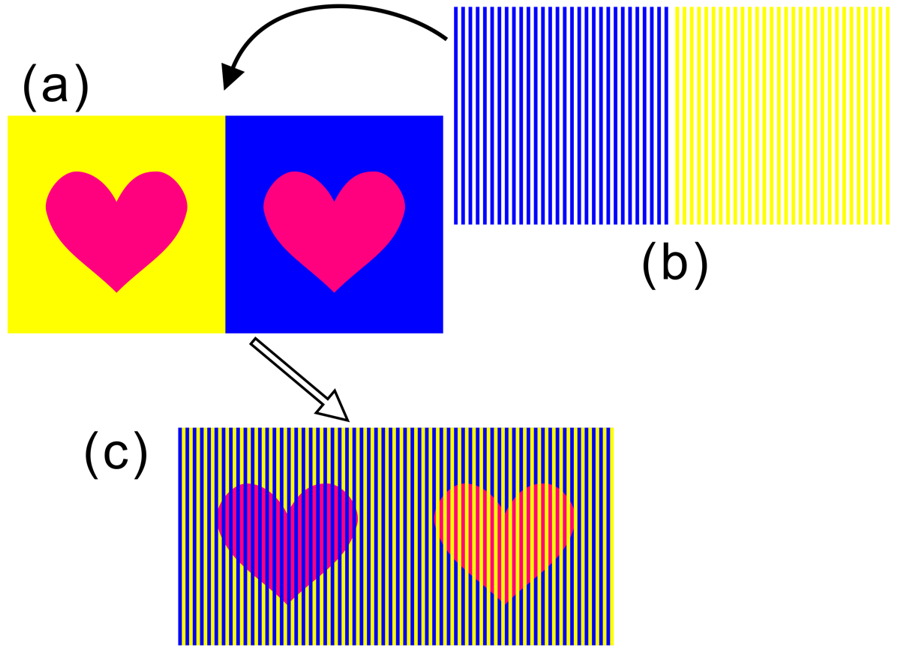
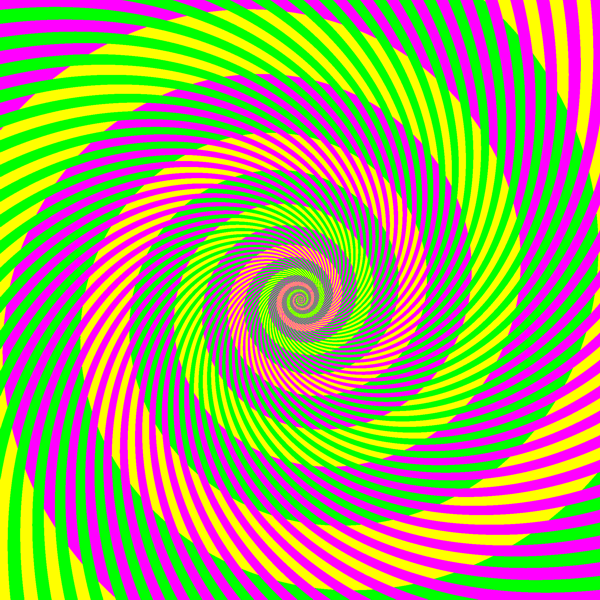
「レモン色の渦巻きとクリーム色の渦巻き」
渦巻きにはレモン色のとクリーム色のと2種類あるように見えるが、どちらも同じ黄色(R255, G255, B0)である。
Copyright A.Kitaoka 2005 (May 22)
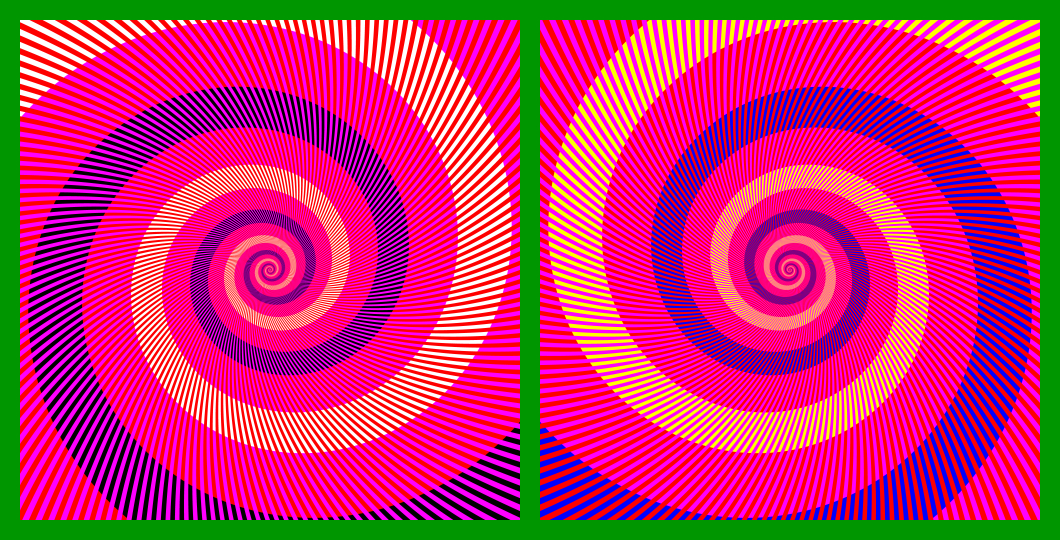
「武田信玄」
薄い黄色と濃い青色の渦巻きがあるように見えるが、左半分は白(R=255, G=255, B=255)と黒(R=0, G=0, B=0)であるのに対し、右半分は黄(R=255, G=255, B=0)と青(R=0, G=0, B=255)である。
Copyright Akiyoshi .Kitaoka 2007 (March 12)
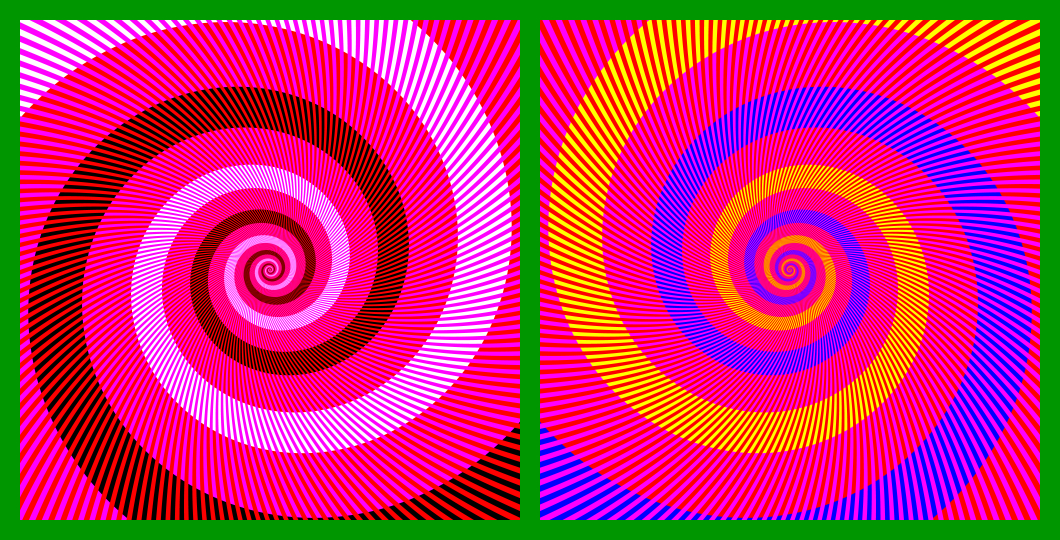
「風林火山」
「武田信玄」の白黒黄青と同じであるが、この図では違いがはっきりわかる。
Copyright Akiyoshi .Kitaoka 2007 (March 12)
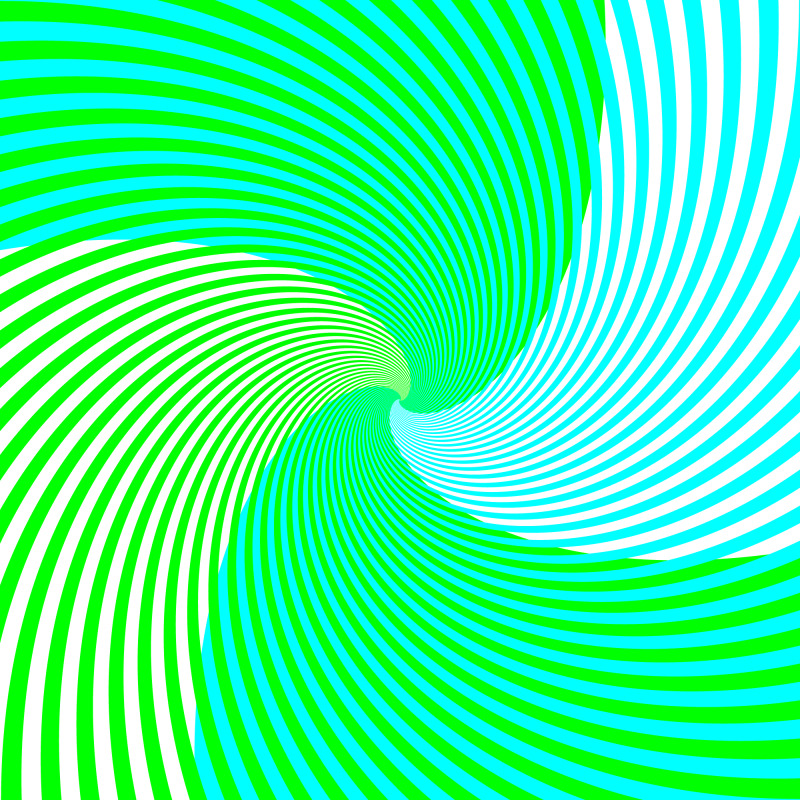
「小家族」
左の鳩も右の鳩も同じ色なのだが、左の方は黄味がかって見える。
Copyright Akiyoshi .Kitaoka 2007 (March 12)
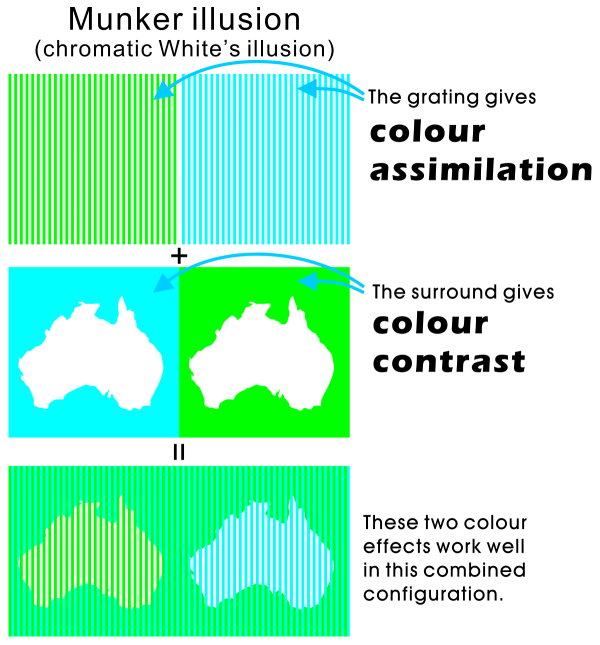
Left: Green (assimilation) + Red (contrast of cyan) = Yellow induction; Right: Cyan (assimilation) + Magenta (contrast of Green) = Blue induction
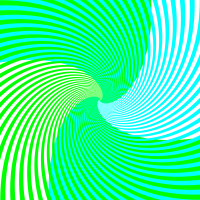 OK?
OK?
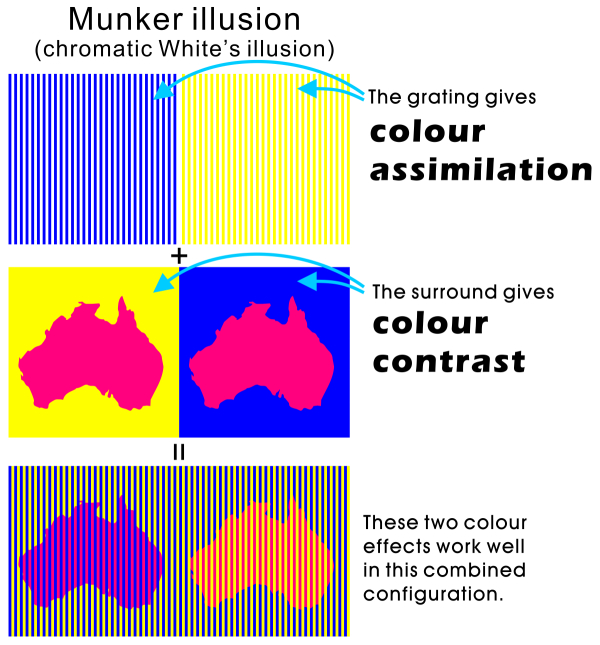
Left: Blue (assimilation) + Blue (contrast of yellow) = Blue induction; Right: Yellow (assimilation) + Yellow (contrast of blue) = Yellow induction
色の土牢錯視 (Chromatic dungeon illusion)
「犬」
赤い犬は2種類、緑の犬も2種類いるように見えるが、それぞれ同じ赤と緑である。色の土牢錯視である。
別バージョン 別バージョン2
Copyright Akiyoshi .Kitaoka 2007 (January 5)
「四色の犬」
上から1番目と3番目の列の犬は2種類、2番目と4番目の列の犬も2種類いるように見えるが、それぞれ同じ色である。色の土牢錯視である。
Copyright Akiyoshi .Kitaoka 2007 (January 5)
土牢錯視(dungeon illusion)(Bressan, 2001)とは?
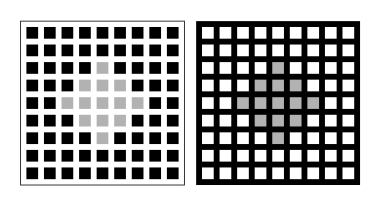
左の「牢屋」の灰色のダイヤモンド形は右のよりも明るく見えるが、物理的には同じ明るさである。
Bressan, P. (2001) Explaining lightness illusions. Perception, 30, 1031-1046.
色の土牢錯視とは?
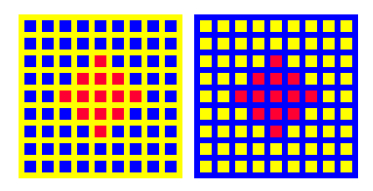
左の「牢屋」のダイヤモンド形はオレンジ色に、右のは少し紫がかった赤に見えるが、物理的には同じ色である。
引用文献は調査中(ないかもしれない)
色の土牢錯視は雰囲気はムンカー錯視だが、普通に色の同化で説明することも可能だし、ゲシュタルト要因を考えて色の対比というのもあるのかもしれない。
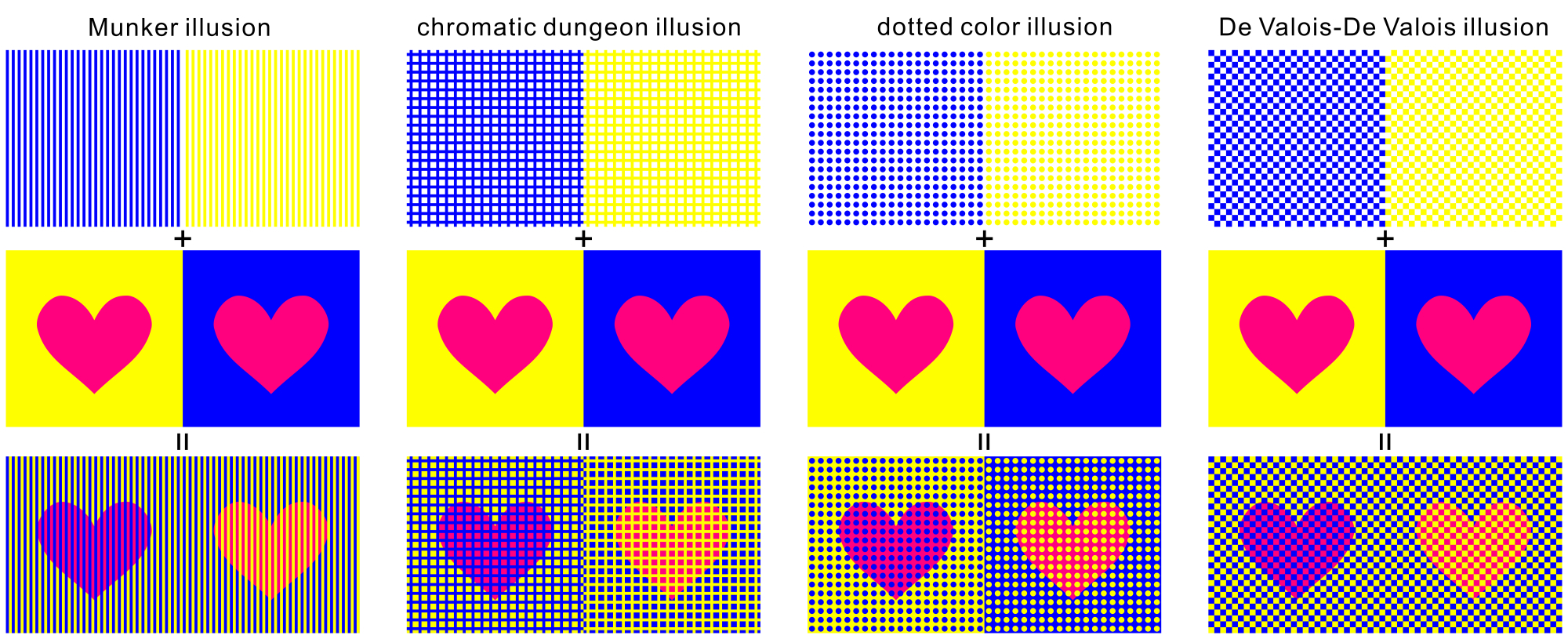
「4種類の色の錯視の作り方」
物理的に同じ色(R=255, G=0, B=127)のハートが錯視によってピンクとオレンジのハートに見える。左から、ムンカー錯視(Munker illusion)、色の土牢錯視(chromatic dungeon illusion)、ドット色錯視(dotted color illusion)、デヴァロイス・デヴァロイス錯視(De Valois-De Valois illusion)である。 上図の高解像度ファイルはこちら(8000 x 3262 pixel, 10MB)。
Copyright Akiyoshi Kitaoka 2009 (June 1)
References
| Munker illusion | Munker, H. (1970) Farbige Gitter, Abbildung auf der Netzhaut und übertragungstheoretische Beschreibung der Farbwahrnehmung. Habilitationsschrift, Ludwig-Maximilians-Universität, München. |
| chromatic dungeon illusion | For the dungeon illusion: Bressan, P. (2001) Explaining lightness illusions.
Perception, 30, 1031-1046. Kitaoka (2007) http://www.psy.ritsumei.ac.jp/~akitaoka/saishin22e.html |
| dotted color illusion | For the dotted brightness illusion: White, M. (1982) The assimilation-enhancing effect of a dotted surround upon a dotted test region. Perception, 11, 103-106. Kitaoka (2008) http://www.psy.ritsumei.ac.jp/~akitaoka/color10e.html |
| De Valois-De Valois illusion | De Valois, R. L. and De Valois, K. K. (1988) Spatial Vision. New York: Oxford University Press. |
北岡明佳 (2012) 色の錯視いろいろ (4) 簡単で錯視量の多い色相の錯視図形の作り方 日本色彩学会誌, 36(1), 45-46. PDF(スキャンコピー) <配布資料>
<色の恒常性的錯視>
問: 下記のような色から、オレンジ色と赤紫色を同時に作る方法はあるか?
Make orange color and red-purple color from the three color shown below.

答: ある。
You can do like this.

Produced Akiyoshi Kitaoka 2012 (September 16)
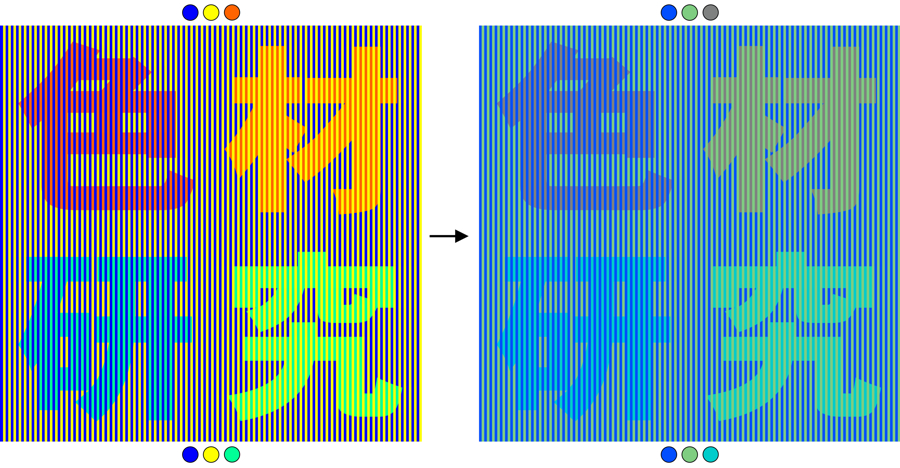
「ムンカー錯視と色の恒常性の色材研究」
Munker illusion and its "color constantancy illusion"
左の「色材」は赤が赤紫とオレンジに見え、「研究」は水色と黄緑色に見える。右の「色材」は灰色が赤紫とオレンジに見え、「研究」は青緑色が水色と黄緑色に見える。
There appear red purple and orange characters but they are the same red
in the left image and the same gray in the right image.
Copyright Akiyoshi Kitaoka 2012 (September 16)
色の錯視の色の恒常性図形の作り方
How to make an image which demonstrates the color constancy illusion of
color illusion
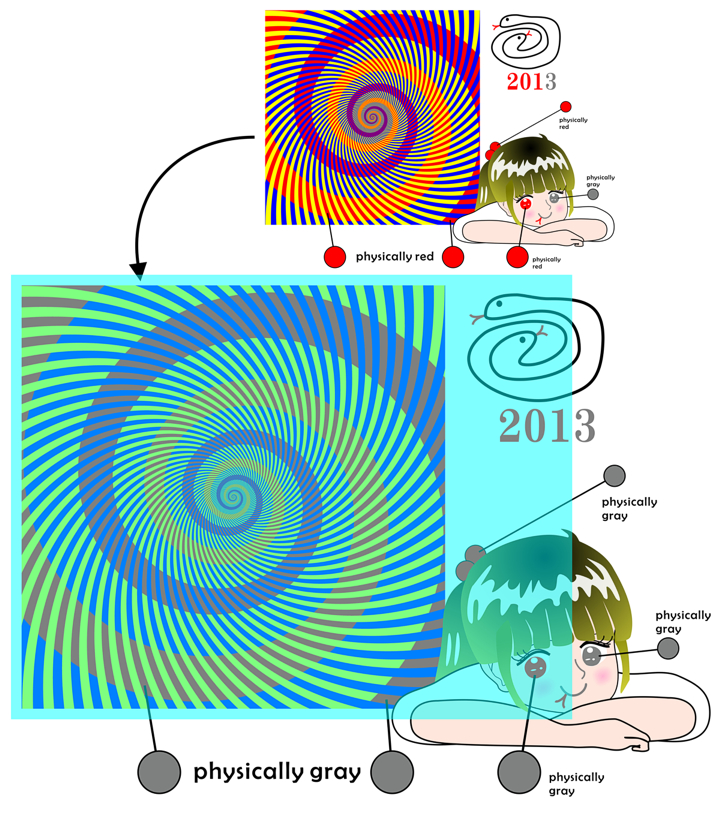
Copyright Akiyoshi Kitaoka 2012 (December 7)
問: 下記のような色から金色を作る方法はあるか?
Make gold color from such colors shown below.

答: ある。
You can do like this.
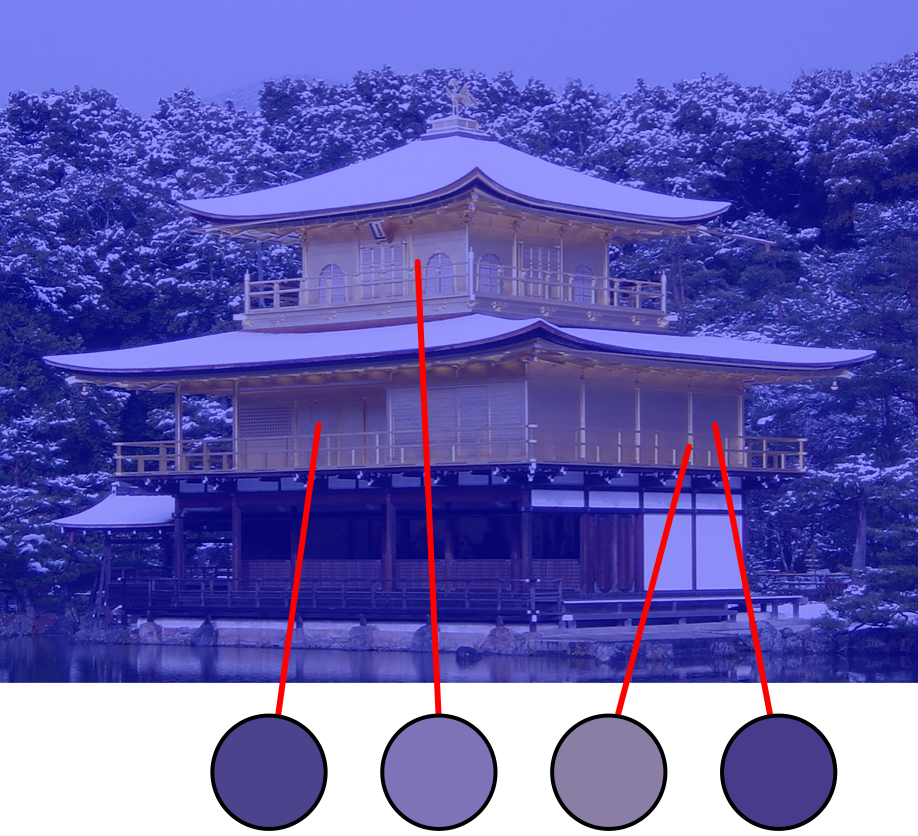
「青い金閣」
"Bluish Golden Palace"
青フィルターがかかっていやな感じではあるが金閣は金色に見える。金色は黄色系統でなければならないという前提があるなら、この合成画像で金閣が金色に見えることは錯視であり、知覚される金色は物理的には青系統の色である。
Copyright Akiyoshi Kitaoka 2011 (July 14)
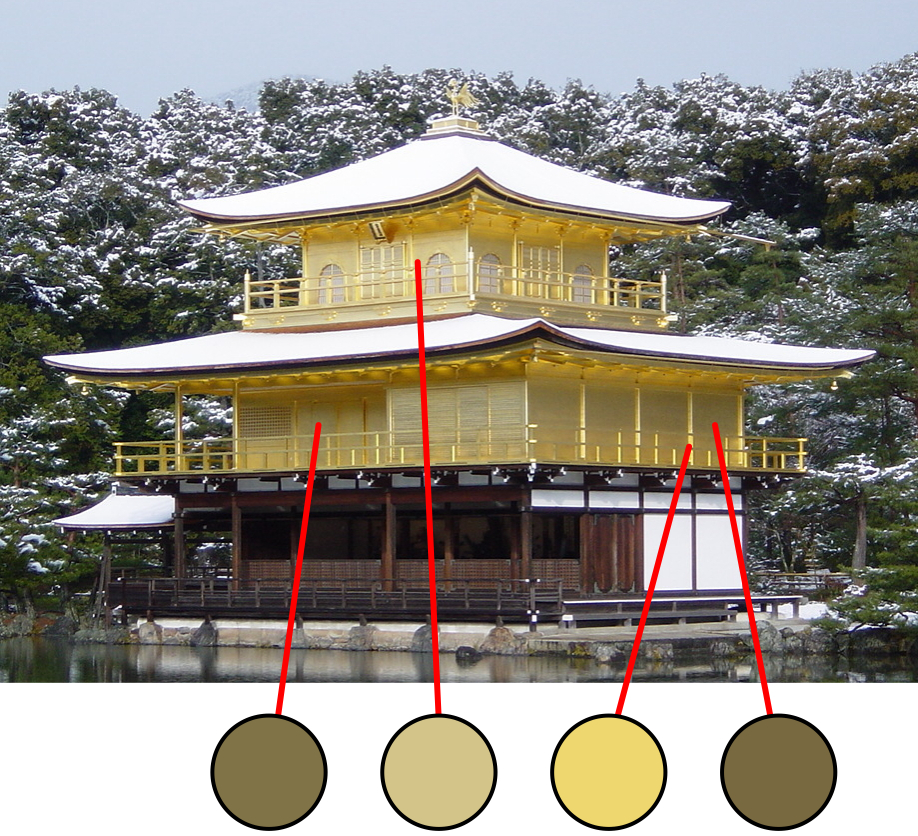
Golden Palace
黄色系統でなくても金色に見える。
Gold color can be made from bluish colors.
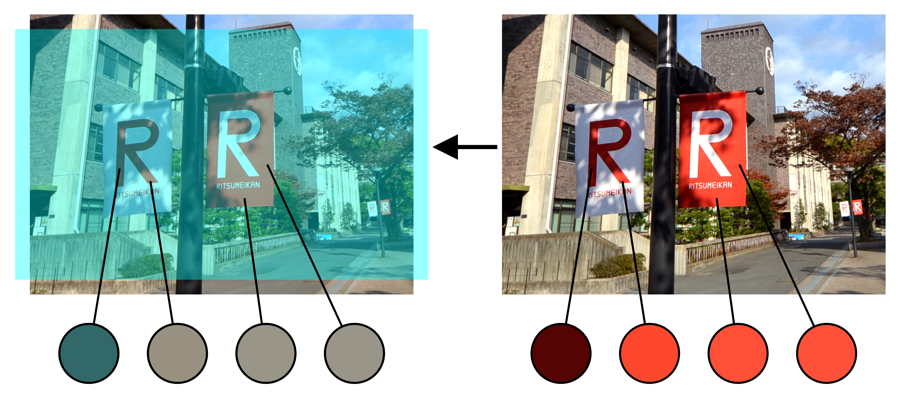
「立命館大学ののぼりの色の恒常性」
"Ritsumeikan flags"
Copyright Akiyoshi Kitaoka 2012 (November 30)
色の恒常性錯視デモ用のプリント用ファイル DOC

References
北岡明佳 (2011) 色の錯視いろいろ (2)色の恒常性と2つの色フィルタ 日本色彩学会誌, 35(3), 234-236. PDF(スキャンコピー), PDF(高解像度スキャンコピー)
北岡明佳 (2011) 色の錯視いろいろ (1)「目の色の恒常性」という錯視の絵 日本色彩学会誌, 35(2), 118-119. PDF(スキャンコピー)
加法的色変換
Additive color changes
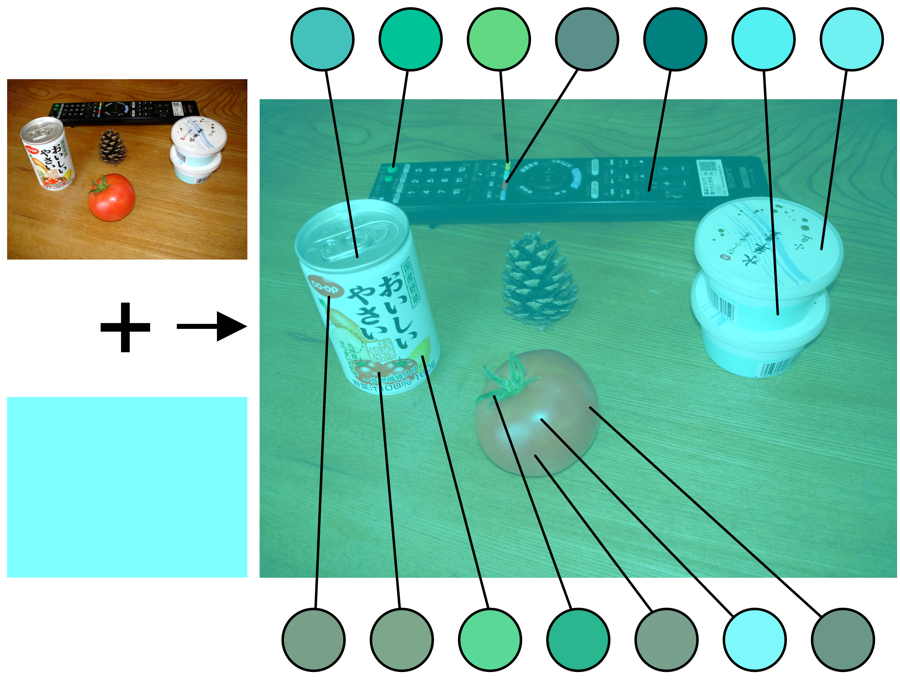
北岡明佳 (2011) 色の錯視いろいろ (2)色の恒常性と2つの色フィルタ 日本色彩学会誌, 35(3), 234-236. <図2>

乗法的色変換
Multiplicative color change
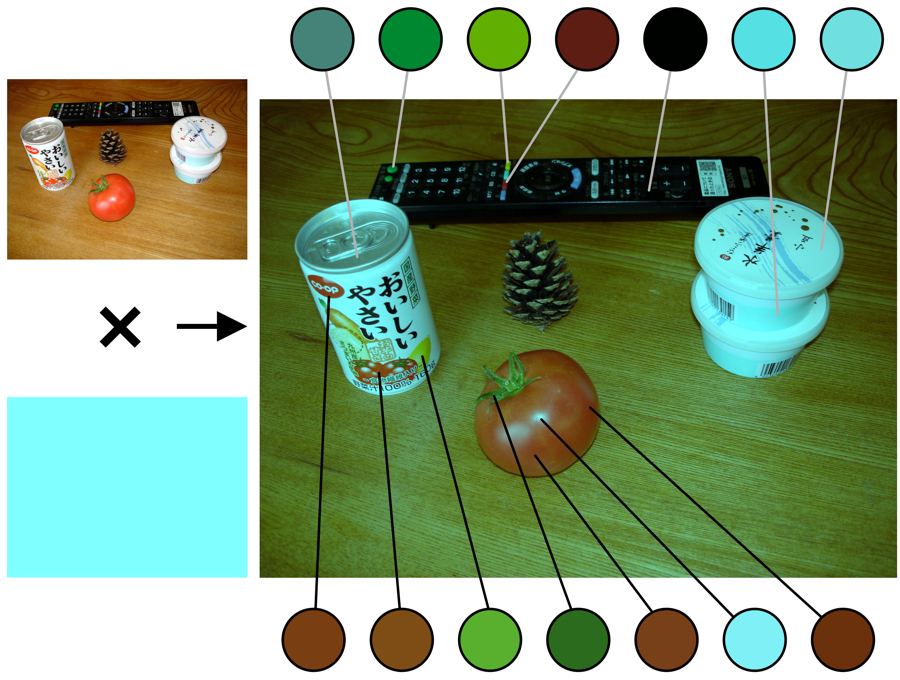
北岡明佳 (2011) 色の錯視いろいろ (2)色の恒常性と2つの色フィルタ 日本色彩学会誌, 35(3), 234-236. <図4>
北岡明佳 (2011) 色の錯視いろいろ (2)色の恒常性と2つの色フィルタ 日本色彩学会誌, 35(3), 234-236. PDF(スキャンコピー), PDF(高解像度スキャンコピー)
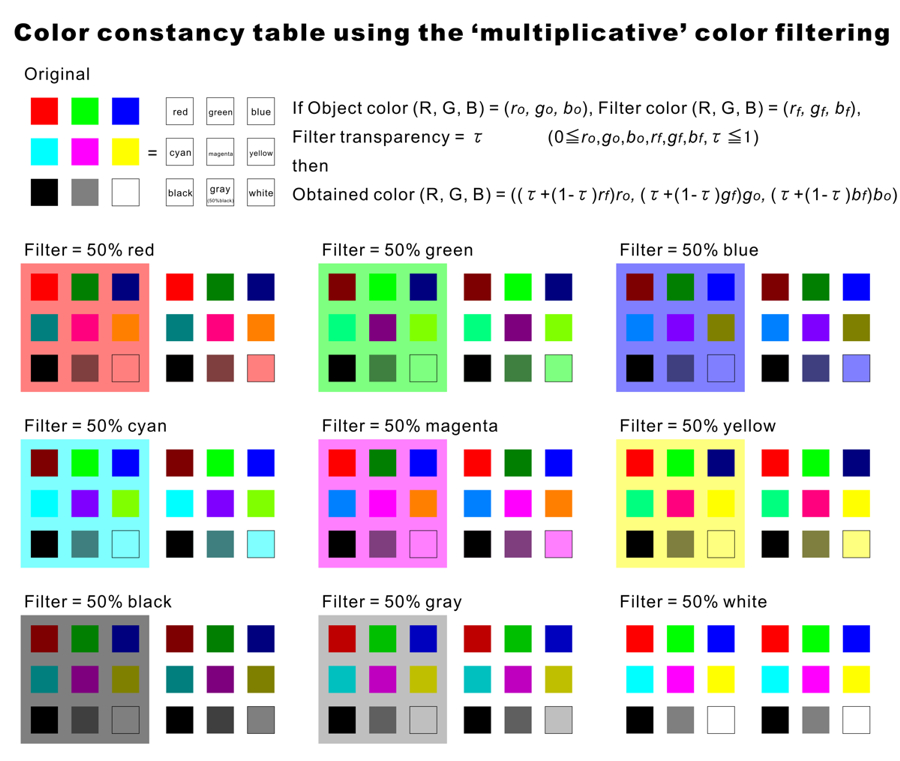
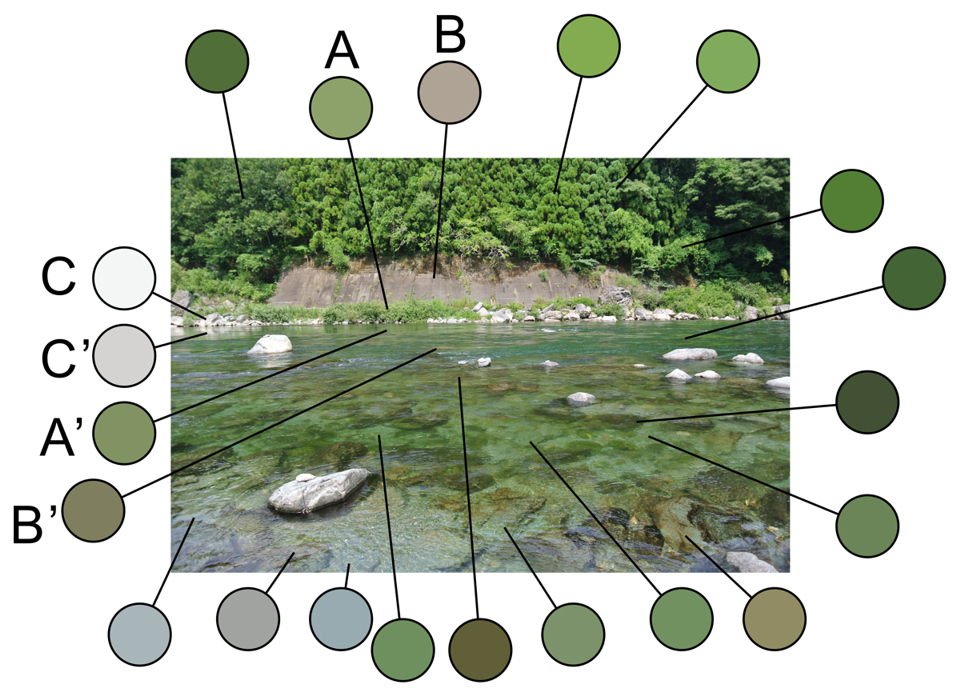
加法的色変換の例・・・「清流」の緑は山の緑
Example of additive color changes
Copyright Akiyoshi Kitaoka 2013 (August 3)

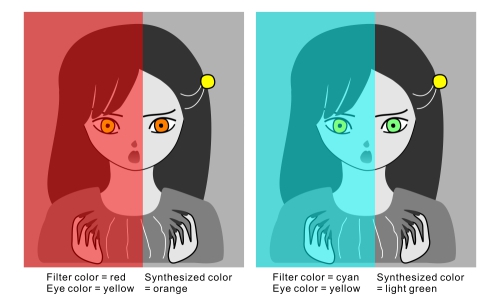
「色の恒常性による両眼闘争の抑制」
"No binocular rivalry in the color constancy eye"
2つの図を両眼融合して見ると、左目はオレンジ色と緑色の間の両眼闘争を起こすが、右目は黄色に見えたままである。しかし、右目は左目と同じく、物理的にはオレンジ色と緑色なのである。
Try to fuse them binocularly. Then, the left eye shows binocular rivalry
between orange and green, while the right eye does not. This observation
is remarkable since the right eye is the same color as the left eye in
each image.
Copyright Akiyoshi Kitaoka 2009 (June 29)
色の恒常性は高次な知覚という先入観が私にはあったが、本図は低次処理の証拠となるかもしれない。
This phenomenon might suggest that color constancy should reflect a rather
low-level visual process.
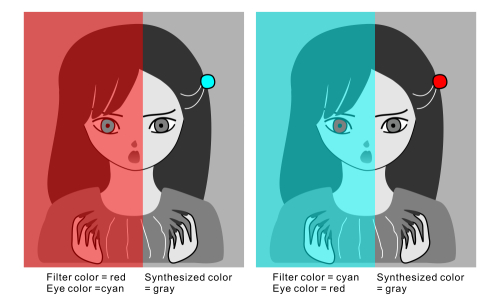
「色の恒常性による両眼闘争」
"Binocular rivalry in the color constancy eye"
2つの図を両眼融合して見ると、右目はシアン色(水色)と赤色の間の両眼闘争を起こすことがあるが、左目は灰色に見えたままである。しかし、どちらの右目も左目と同じく、物理的には灰色なのである。
Try to fuse them binocularly. Then, the right eye sometimes shows binocular
rivalry between cyan and red, while the left eye does not. This observation
is remarkable since the right eye is the same gray for each image.
Copyright Akiyoshi Kitaoka 2009 (June 29)
両眼の情報が統合される前に色の恒常性が成立していないと両眼闘争はしないよね・・・その論理でいいのか??
This phenomenon might also support the idea that color constancy should
reflect a rather low-level visual process.

Limited case: "No binocular rivalry in the color constancy eye"
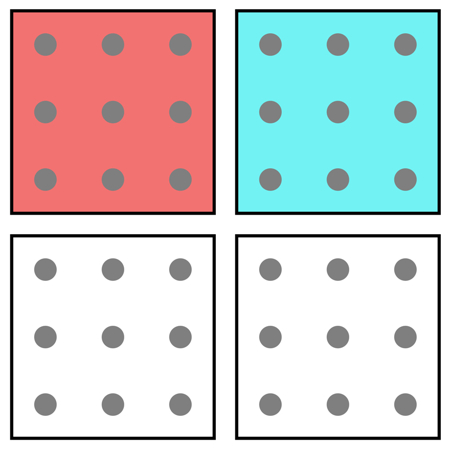
Limited case: "Binocular rivalry in the color constancy eye"
Copyright Akiyoshi Kitaoka 2013 (October 22)
<図地分離による色の錯視>
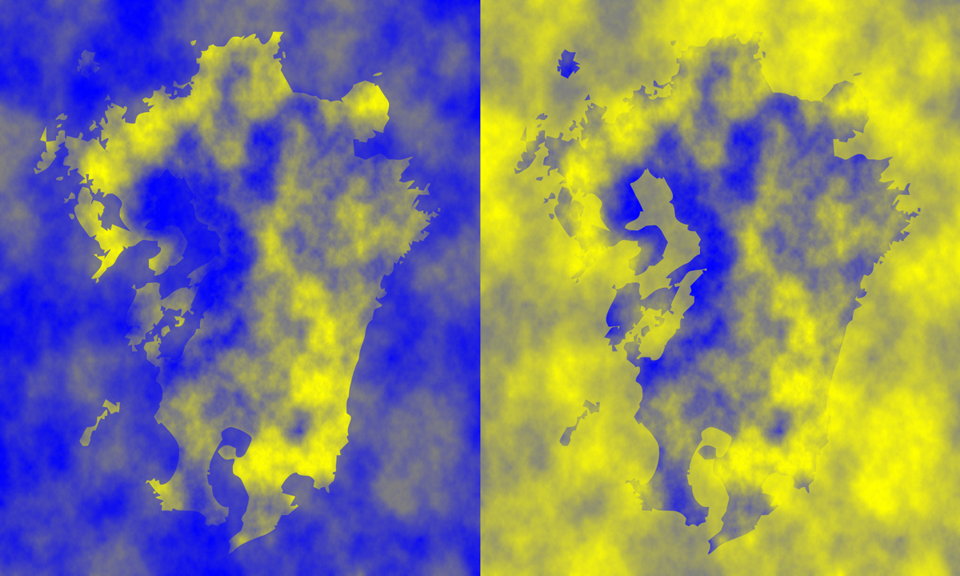
「黄色の九州と青色の九州」
九州部分はどちらも同じパターンなのに、左は黄色い九州に見え、右は青い九州に見える。
Copyright Akiyoshi Kitaoka 2012 (November 23)
Anderson, B. L. and Winawer, J. (2005) Image segmentation and lightness perception. Nature, 434, 79-83.
Wollschläger, D. and Anderson, B.L. (2009) The role of layered scene representations in color appearance. Current Biology, 19, 430-435.
北岡明佳 (2012) 色の錯視いろいろ (6) 「図地分離による錯視」 日本色彩学会誌, 36(3), 237-238.
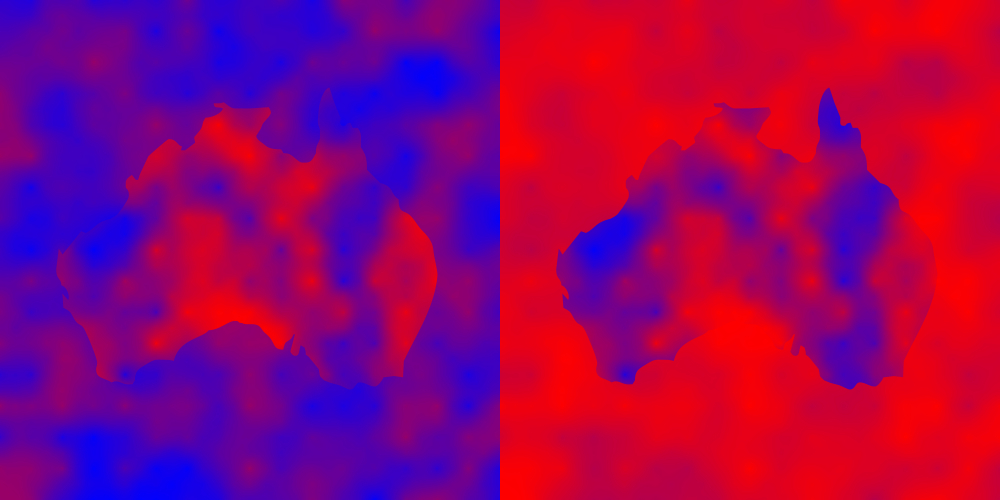
"Australia seen from space and dust storm over Australia"
The two Australia shapes are physically the same color and texture, but the left Australia appears to be reddish while the right one appears to be bluish with red dust storm blanketing it. This effect depends on the chromatic version of Anderson's illusion.
Copyright Akiyoshi .Kitaoka 2009 (September 25)
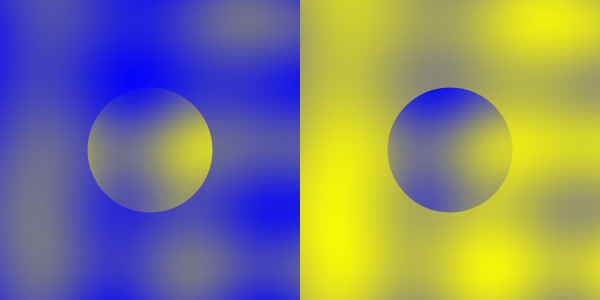
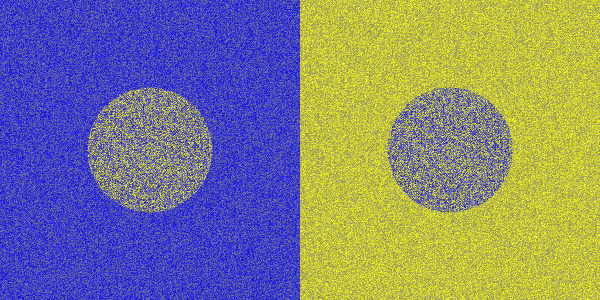
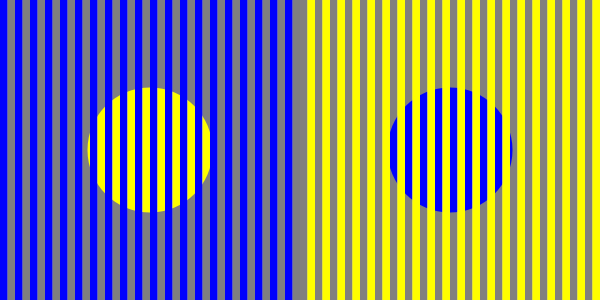
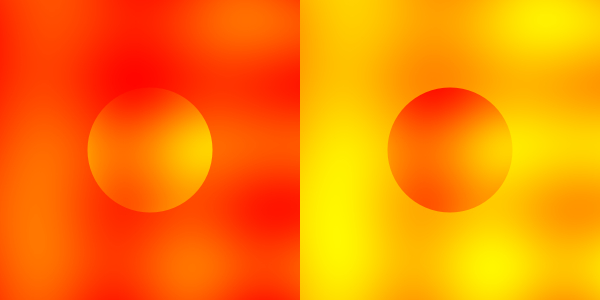
「満月と夕日」
円内は左右で同じパターンであるが、左は満月に見え、右は夕日に見える。
Copyright Akiyoshi Kitaoka 2007 (August 21)
「『九州の錯視』の作り方」
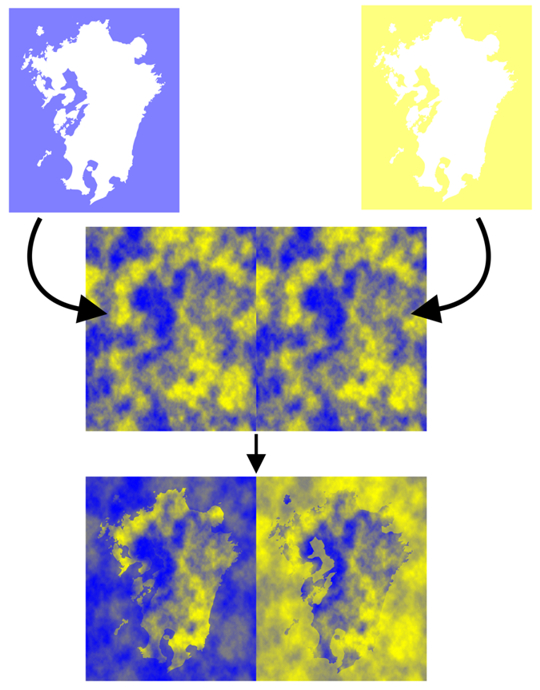
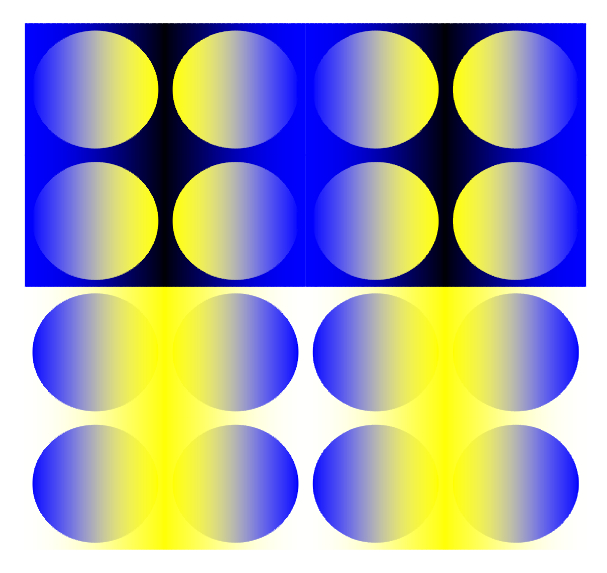
「サーチライト」
黄色のサーチライトが当たっているように見える。各縦列の円の中の色グラデーションは同じであるが、上2つは黄色の円に見え、下2つは青の円に見える。
Copyright Akiyoshi Kitaoka 2005 (December 7)
Color phantoms

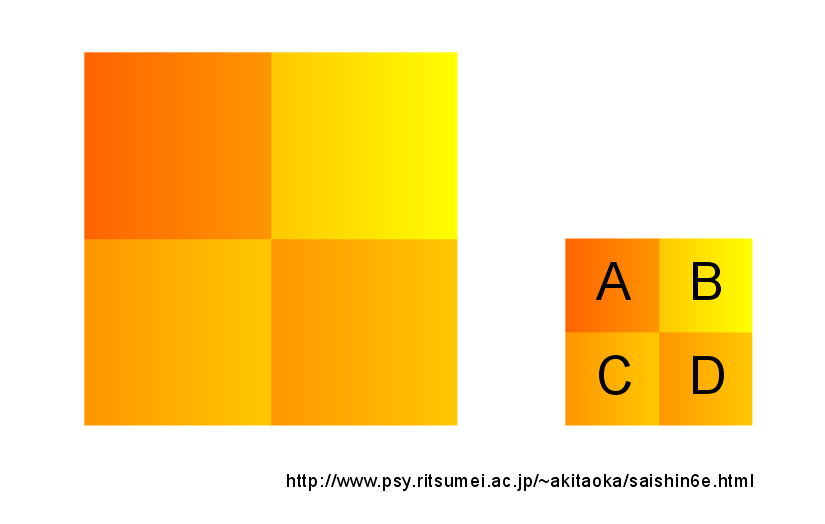
A と D、B と C が同じ感じに見えるが、物理的には C と D が同じである。
Copyright Akiyoshi .Kitaoka 2005 (August 12)
<色の対比>
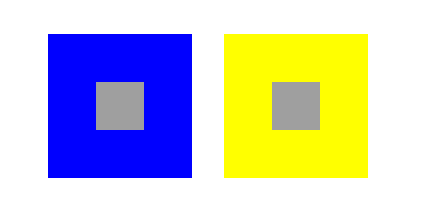
ある領域が別の色の領域で囲まれると、そこに囲んだ色の反対色が誘導される現象。灰色領域が青で囲まれると黄が誘導され(左図)、同じ灰色領域が黄で囲まれると青が誘導される(右図)。
「強化型色対比」
正方形の色は a = d と b = c のように見えるが、物理的な色は b = d である。
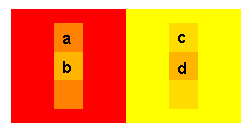
by Akiyoshi Kitaoka 2005 (May 27)
ただの色対比にあらず。上下の正方形を取ると、錯視量が減る(下図)。

Piersの論文1)に刺激されて作成。
1) Howe, P. D. L. (2005) White's effect: Removing the junctions but preserving the strength of the illusion. Perception, 34, 557 - 564.
もし先行研究で同じものがあるのを発見されましたら、ご一報下さい。直ちに修正します。 北岡にメールする
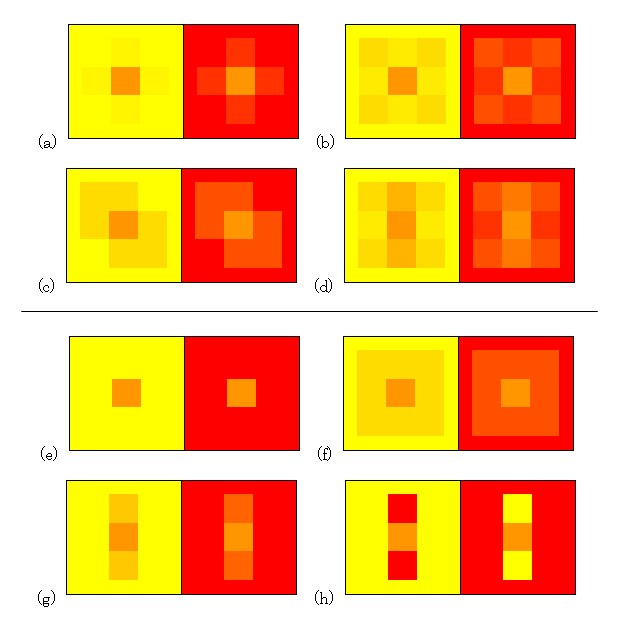
"Color contrast: Miscellaneous 2007 YR"
(a)-(g) The central square in the left half appears to be more reddish or less yellowish than that in the right one, though they are identical in color. (a)-(d) are the new demonstrations. (e) is the standard type. (f) is known (I guess). (g) is the enhanced color contrast I presented before. (h) is chromatic White's effect, where the central square in the left half might appear to be more yellowish or less reddish than that in the right one.
Copyright Akiyoshi Kitaoka 2007 (February 6)
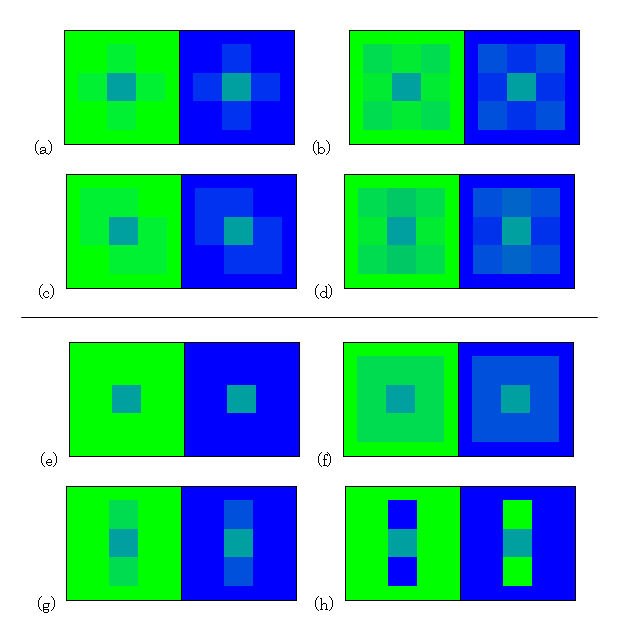
"Color contrast: Miscellaneous 2007 GB"
(a)-(g) The central square in the left half appears to be more bluish or less greenish than that in the right one, though they are identical in color. (a)-(d) are the new demonstrations. (e) is the standard type. (f) is known (I guess). (g) is the enhanced color contrast I presented before. (h) is chromatic White's effect, where the central square in the left half might appear to be more greenish or less bluish than that in the right one.
Copyright Akiyoshi Kitaoka 2007 (February 6)
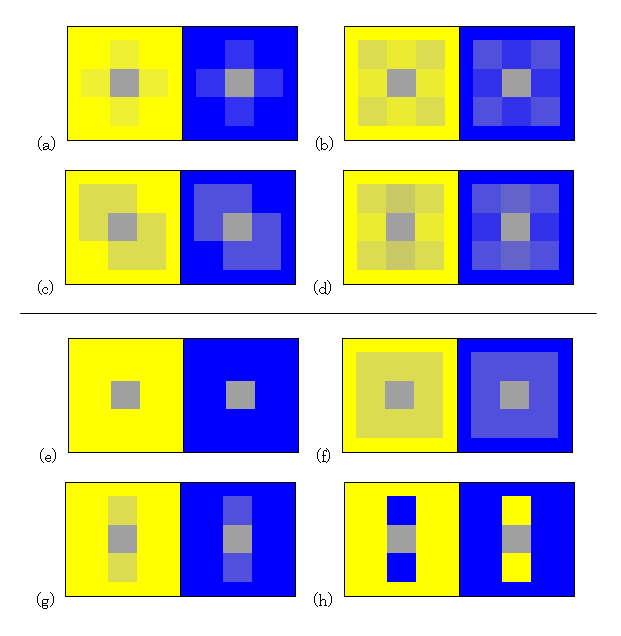
"Color contrast: Miscellaneous 2007 YB"
(a)-(g) The central gray square in the left half appears to be more bluish or less yellowish than that in the right one, though they are identical in color. (a)-(d) are the new demonstrations. (e) is the standard type. (f) is known (I guess). (g) is the enhanced color contrast I presented before. (h) is chromatic White's effect, where the central gray square in the left half might appear to be more yellowish or less bluish than that in the right one.
Copyright Akiyoshi Kitaoka 2007 (February 6)
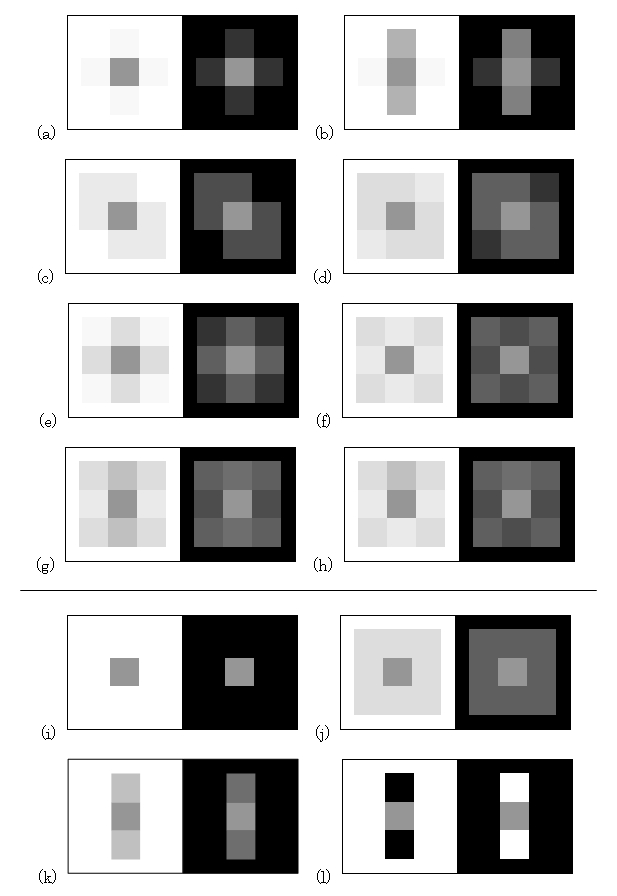
"Brightness contrast: Miscellaneous 2007"
(a)-(k) The central square in the left half appears to be darker than that in the right one, though they are identical in luminance. (a)-(h) are the new demonstrations. (i) is the standard type. (j) is known (I guess). (k) is the enhanced brightness contrast I presented before. (l) is White's effect, where the central square in the left half appears to be brighter or lighter than that in the right one.
Copyright Akiyoshi Kitaoka 2007 (February 5)
誘導部分が分節化(articulation)していると、明るさ対比の効果は大きい(Gilchrist and Annan, 2002)。
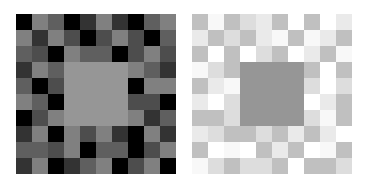
分節化は色の錯視には有効でないかもしれない
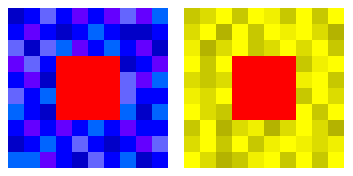
これでもダメな感じ。
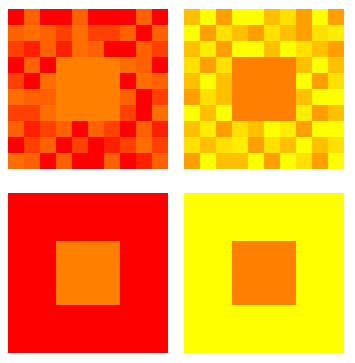
栗木一郎先生のデモ 元のページ(東北大学) そのコピー(アクセスできない場合に使用)
最初に作った作品「ドラゴン」・・・錯視量が少ない↓

左の大きい正方形の中心の小さい正方形は緑色に見えるが、下の列の左の黒(r = 50, g = 50, b = 50)と同じである。一方、右の大きい正方形の中心の小さい正方形は紫色に見えるが、下の列の右の灰色(r = 80, g = 80, b = 80)と同じである。
Copyright Akiyoshi .Kitaoka 2005 (October 13)
「緑のタヌキ」と「ピンクの正方形」・・・色の恒常性の一種?色の対比の一種?
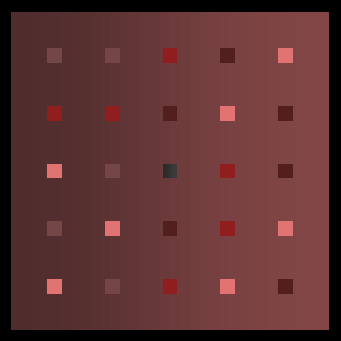
中央の灰色が緑に見える。こういう深い緑はモニターでは出せないはずだったのだが・・・
Copyright Akiyoshi Kitaoka 2005 (October 14)
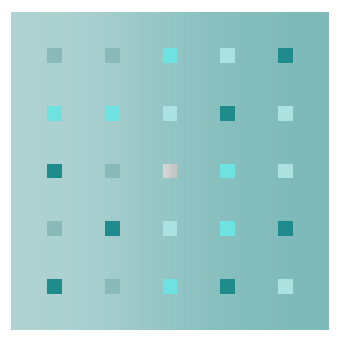
中心の小さい正方形はピンクに見えるが、実際には灰色(のグラデーション)である。
Copyright Akiyoshi .Kitaoka 2005 (October 14)
キルシュマンの法則(色の対比の法則) (Graham and Brown (1965) からの抄訳)
(1)誘導領域(取り囲む領域)と比較してテスト領域(ターゲット領域)が小さければ小さいほど、色の対比は大きい。
(2)色の対比は2つの領域が離れていても起こる。しかし、離れれば離れるほど対比の効果は減少する。
(3)色の対比の量は誘導領域の面積によって異なる。
(4)色の対比は、明るさの対比がないか少ないところで最大となる。 (第3法則と呼ばれる)
(5)明るさが同じならば、色の対比は誘導する色の飽和度(彩度)に影響される。
Graham, C. H. and Brown, J. L. (1965) Color contrast and color appearance:
Brightness constancy and color constancy. In C. H. Graham (Ed.), Vision
and visual perception, New York: John Wiley & Sons (pp 452-478). (In
this paper, the third and fourth laws are exchanged)
Kirschmann, A. (1891) Über die quantitativen Verhältnisse des stimultanen Helligkeits- und Farben-Contrastes. Phil. Stud., 6, 417-491.
Yund, E. W. and Armington, J. C. (1975) Color and brightness contrast effects as a function of spatial variables. Vision Research, 15, 917-929.
第3法則には否定的見解が出ている。
Kinney, J. A. S. (1962) Factors affecting induced colors. Vision Research, 2, 503-525.
Oyama, T. and Hsia, Y. (1966) Compensatory hue shift in simultaneous color contrast as a function of separation between inducing and test fields. Journal of Experimental Psychology, 71, 405-413.
しかし、
「入学式」
灰色で描いたサクラの花びらに、色が付いて見える。
Copyright Akiyoshi .Kitaoka 2007 (March 2)
図にカーソルを載せると、花びらは灰色であることがわかる。
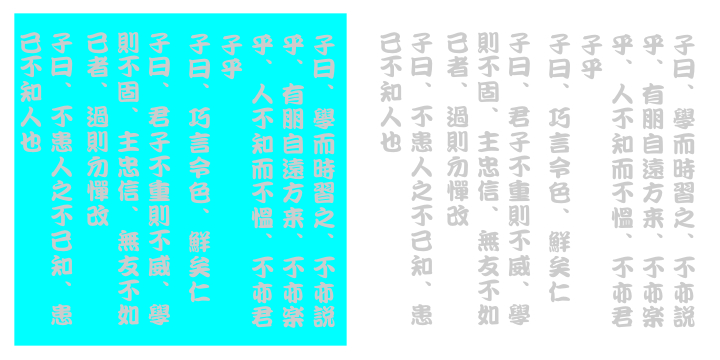
遠隔色対比
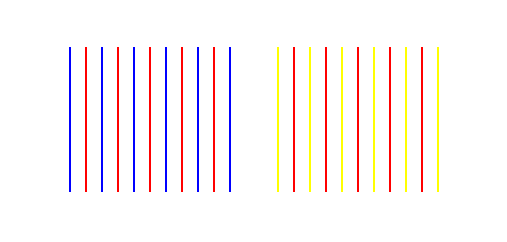
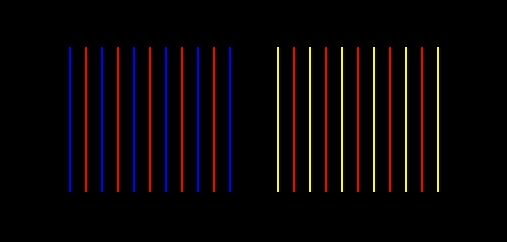
赤い線がある程度青い線より離れたところに置かれると、青の補色の黄色味がかって見える。黄色の線の間に置かれると黄の補色の青味がかって見える。
北岡明佳 (2001) 錯視のデザイン学(6)・色彩知覚の知られざる不安定性 日経サイエンス, 31(7), 128-129.
作品「色の分裂」・・・遠隔色対比の誘導図形は線でなくてもよい。↓
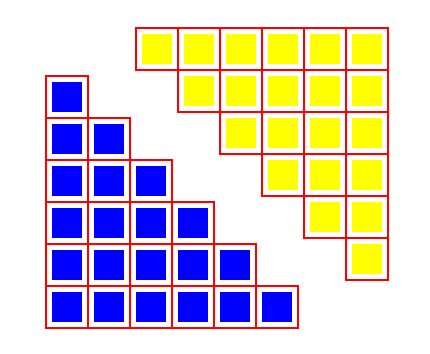
青色の正方形のまわりの赤はオレンジ色に見え、黄色の正方形のまわりの赤はマゼンタ色に見えるが、同じ赤である。
Copyright Akiyoshi .Kitaoka 2005 (May 27)
遠隔色同化
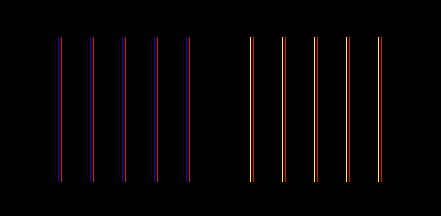
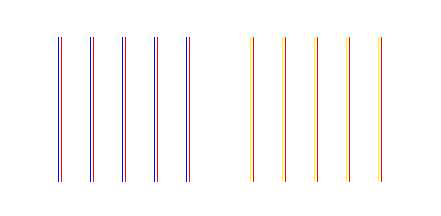
赤い線がある程度青い線より離れてはいるが近くに置かれると、青味がかって見える。黄色の線に近づくと、黄味がかって見える。
北岡明佳 (2001) 錯視のデザイン学(6)・色彩知覚の知られざる不安定性 日経サイエンス, 31(7), 128-129.
<色の同化>
(視覚の実験的研究でよく出てくるタイプ)
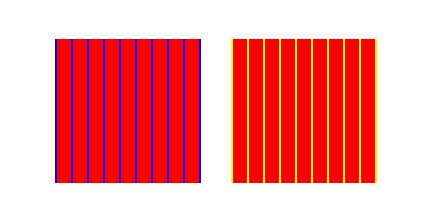

ある領域に、色の付いた細い線が乗ると、その色味が誘導されて見える現象。赤い領域に青線を乗せると赤紫に見え(左図)、同じ赤の領域に黄線を乗せるとオレンジ色に見える(右図)。
色の同化
(デザインの教科書等によく見かけるタイプ)
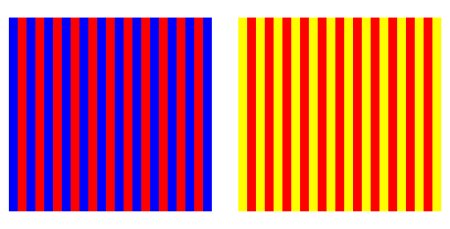

等間隔で細い縞模様を描くと、隣合った色相が誘導される。左の赤は青みがかって見え、右の赤は黄みがかかって見える。
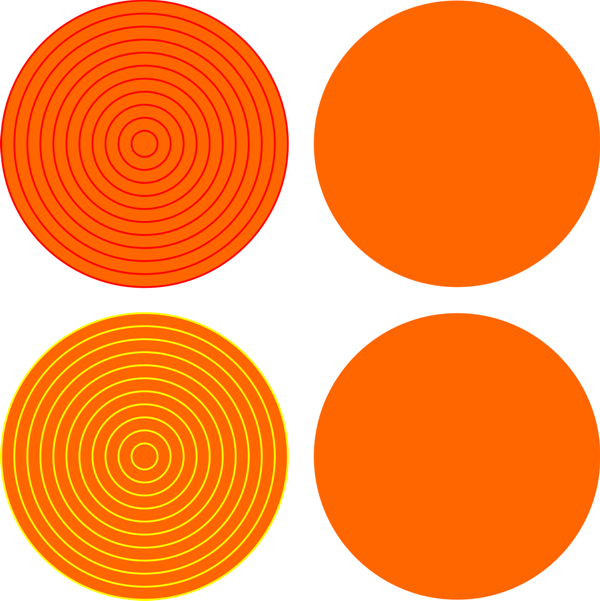
ミカンのネットタイプの色の同化
Copyright Akiyoshi Kitaoka 2011 (May 5)
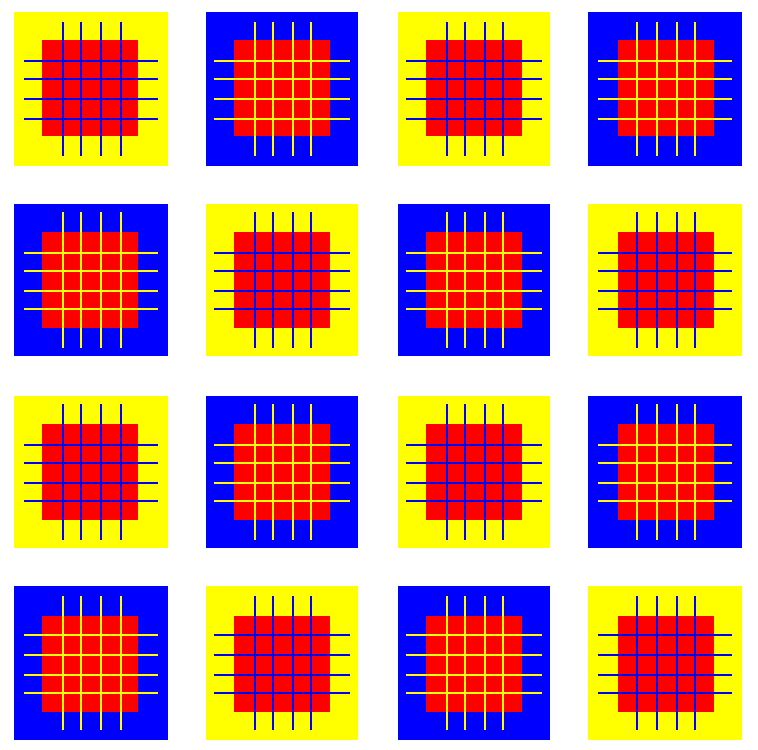
「ひまわりとダリア」
同じ赤が青味がかったり、オレンジ色に見える。
Copyright A.Kitaoka 2001
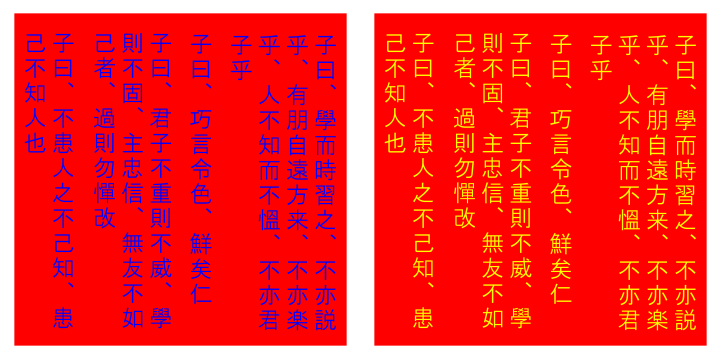
「論語式色の同化」
左右の赤の背景は同じ色であるが、右の方がややオレンジっぽく見える。
produced by Akiyoshi .Kitaoka 2008 (July 7)
テキストは「論語の世界」より借用
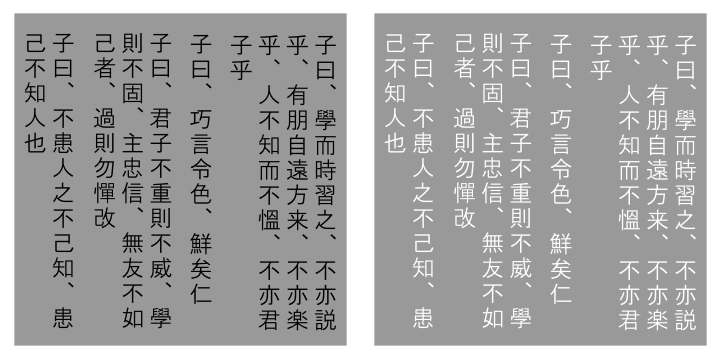
「論語式明るさの同化」
左右の灰色の背景は同じ明るさであるが、右の方がやや明るく見える。(暗く見えるような気もするなあ)
Copyright Akiyoshi Kitaoka 2008 (July 7)
<色の逆同化>
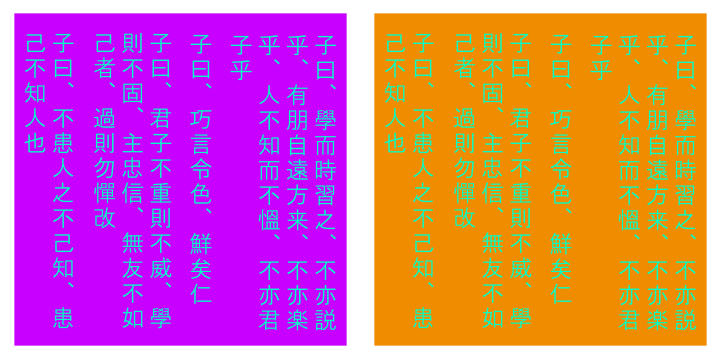
「論語式色の逆同化」
左右の文字は同じ色であるが、左は水色、右は黄緑色に見える。
Copyright Akiyoshi Kitaoka 2008 (July 7)
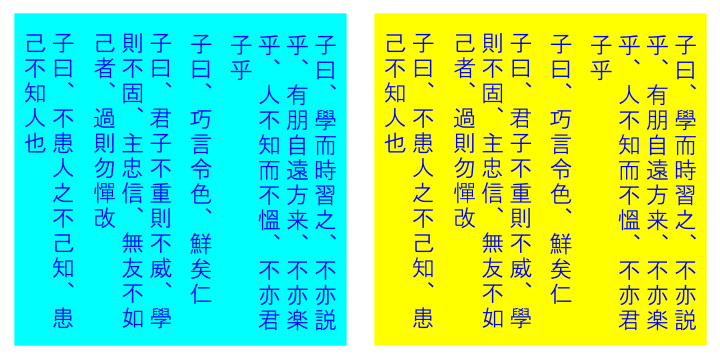
「論語式色の逆同化 3」
左右の文字は同じ青であるが、右は彩度が低く見える。
Copyright Akiyoshi Kitaoka 2008 (July 7)
More info
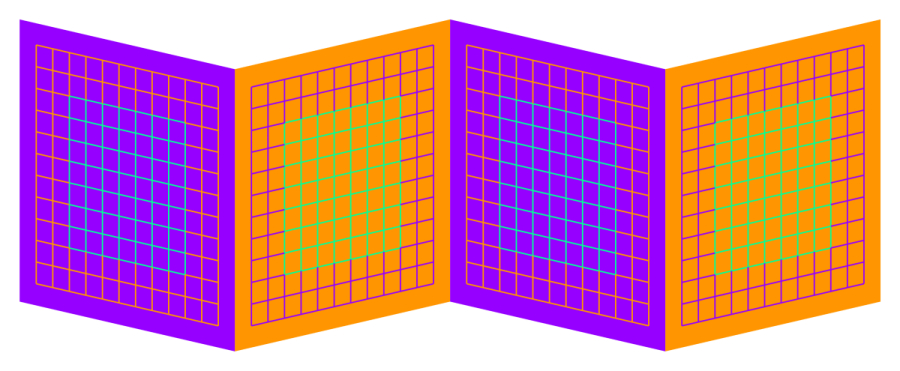
「4枚カード問題」
カードの内側のグリッドが水色と黄緑に見えるが、同じ色である。
Copyright Akiyoshi Kitaoka 2008 (July 7)
「ぐるぐる 3」
それぞれの同心円の内側の4つのリングは同じ色であるが、違う色に囲まれると異なって見える。画面から離れてみた方が効果が大きい。
Copyright Akiyoshi .Kitaoka 2007 (January 15)
「ぐるぐる 6」
それぞれの同心円の内側の4つのリングは同じ色であるが、違う色に囲まれると異なって見える。画面から離れてみた方が効果が大きい。
Copyright Akiyoshi .Kitaoka 2007 (January 15)
「ぐるぐる 7」
それぞれの同心円の内側の4つのリングは同じ色であるが、違う色に囲まれると異なって見える。画面から離れてみた方が効果が大きい。
Copyright Akiyoshi .Kitaoka 2007 (January 15)
「ぐるぐる」という絵本がある。
鈴木亜弥(絵)・安井智草(文) 「ぐるぐる」 新風舎 ISBN4-7974-5595-0 (定価1000円
+ 税)
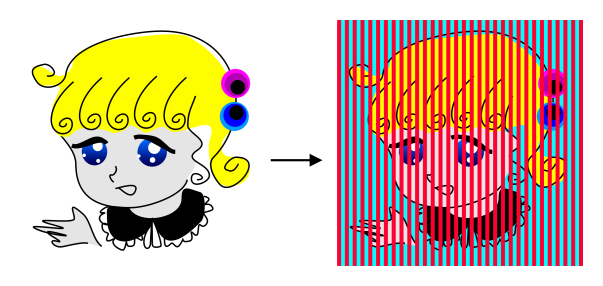
「顔色がよくなる錯視」
顔色がよくなった。
Copyright Akiyoshi .Kitaoka 2007 (March 10)
<彩度の対比と同化?>
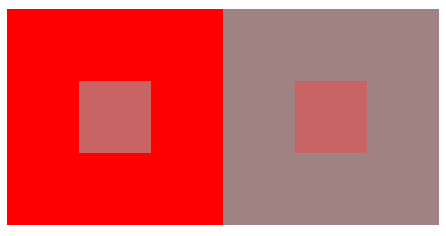
彩度(色の鮮やかさ)の高い色に囲まれた領域の彩度は低く見え(左図)、彩度の低い色の囲まれた領域の彩度は高く見える(右図)。
「絆創膏」
絆創膏(バンドエイドあるいはカットバン)の真ん中の正方形は左右とも同じ色であるが、左の方が鮮やかに見える。
Copyright Akiyoshi .Kitaoka 2007 (January 6)
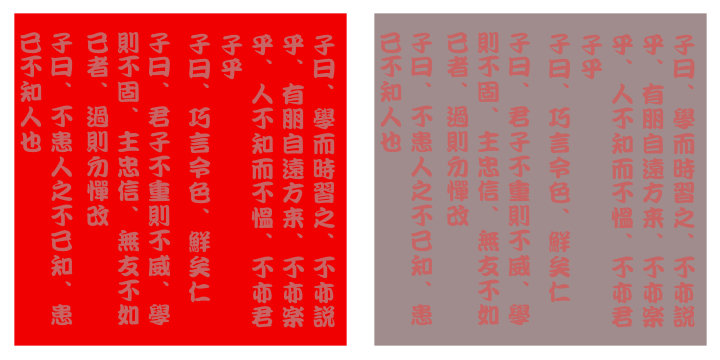
「論語式彩度対比」
左右の文字は同じ色であるが、右の方があざやかに見える。
Copyright Akiyoshi Kitaoka 2008 (July 7)
酒井の色対比・・・彩度対比の一種?色の対比の一種?色の恒常性の一種?
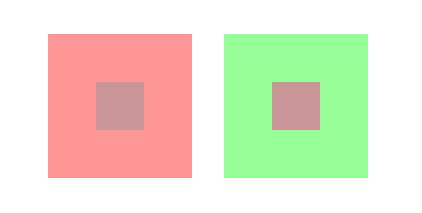
中の正方形の色は同じであるが、左のは灰色に見える。
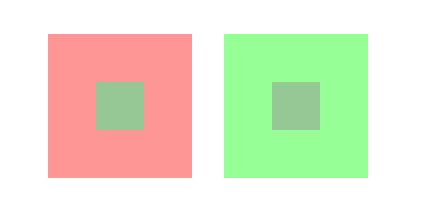
中の正方形の色は同じであるが、右のは灰色に見える。
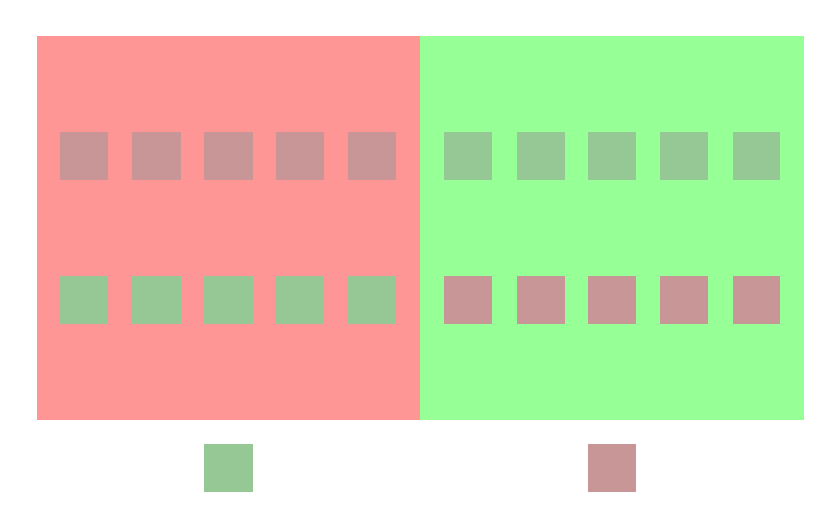
左上5列の「灰色」と右下5列の「赤」は物理的には同じであり、右上5列の「灰色」と左下5列の「緑」は物理的には同じである。
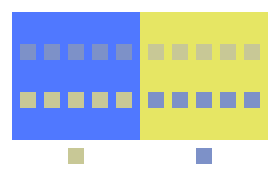
左上5列の「灰色」と右下5列の「青」は物理的には同じであり、右上5列の「灰色」と左下5列の「黄」は物理的には同じである。
酒井香澄(「Landの二色法による色再現とBelseyの仮説検証」立命館大学文学部哲学科心理学専攻2002年度卒業論文)の発見をベースにしている。
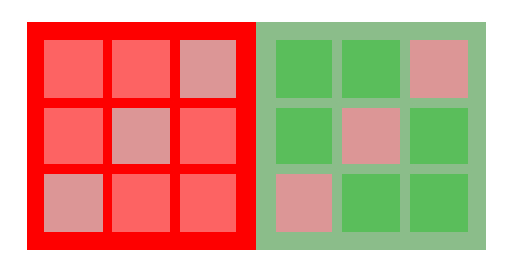
「あじさい」
斜めに並んだ3個同士は同じ色であるが、右の方が赤味が多く見える。
Copyright A.Kitaoka 2005 (May 26)
「みやびなカメ」
カメには赤、緑、灰色の3種類がいるように見えるが、物理的な色で言えば2種類しかいない。
Copyright Akiyoshi .Kitaoka 2007 (January 6)
cf. Snake illusion: Adelson, E. H. (2000) Lightness perception and lightness illusions. In M. Gazzaniga (Ed.), The New Cognitive Neurosciences, 2nd ed. Cambridge, MA: MIT Press. (pp. 339-351).
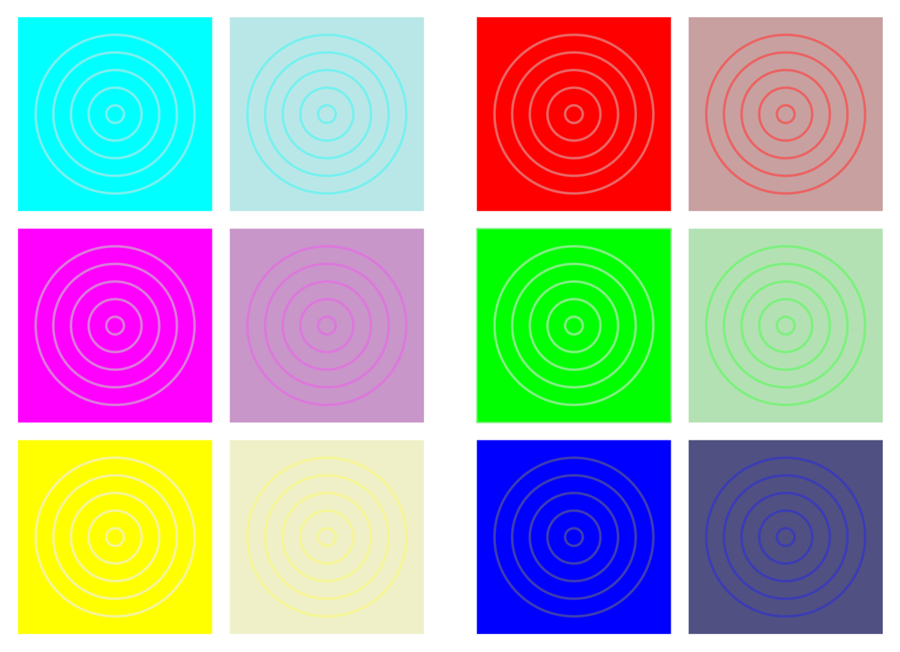
Copyright Akiyoshi Kitaoka 2011 (May 5)
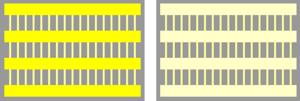
「松田の彩度同化」
縦の細い格子は左右同じ色であるが、左の方がより鮮やかに見える。松田博子先生による。
Copyright Akiyoshi Kitaoka 2011 (May 2)
松田先生によると「トーン同化」と言えるかもしれないとのことである。
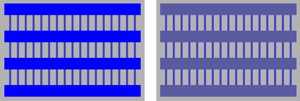
Copyright Akiyoshi Kitaoka 2011 (May 9)
<色の補完>
ネオン色拡散
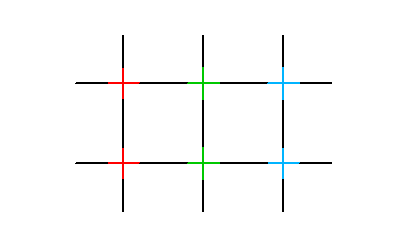
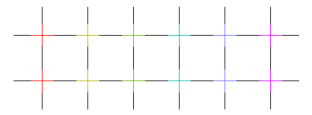
色の十字の周りがパッチ状に同色に色づいて見える。
Varin, D. (1971) Fenomeni di contrasto e diffusione cromatica nell'organizzazione spaziale del campo percettivo. Rivista di Psicologia, 65, 101-128.
Van Tuijl, H. F. J. M. (1975). A new visual illusion: Neonlike color spreading and complementary color induction between subjective contours. Acta Psychologica, 39, 441-445.
Redies, C. and Spillmann, L. (1981). The neon color effect in the Ehrenstein illusion. Perception, 10, 667-681.
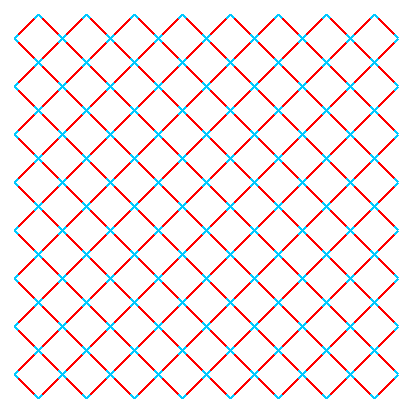
「ネオン色拡散による針差し格子錯視」1)
一様な白い背景上を縦横に水色の線が走って見える。「クモの巣の糸」(Spinnwebfäden)2)あるいは「色の筋」(colored street)3)と呼ばれたものと同じと考えられる。
Copyright Akiyoshi Kitaoka 2001
1) 北岡明佳 (2001) 錯視のデザイン学(7):工学的にはとらえきれない幻の光知覚 日経サイエンス, 31(8), 66-68.
2) Prandtl, A. (1927). Über gleichsinnege Induktion und die Lichtverteilung in gitterartigen Mustern. Zeitschrift für Sinnesphysiologie, 58, 263-307.
3) Redies, C., Spillmann, L. and Kunz, K. (1984). Colored neon flanks and line gap enhancement. Vision Research, 24, 1301-1309.
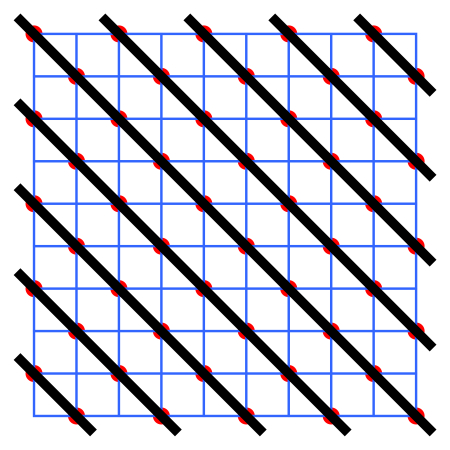
「色光線錯視」1)
一様な白い背景上を赤色の線が斜めに走って見える。
Copyright Akiyoshi Kitaoka 2001
1) 北岡明佳 (2001) 錯視のデザイン学(7):工学的にはとらえきれない幻の光知覚 日経サイエンス, 31(8), 66-68.
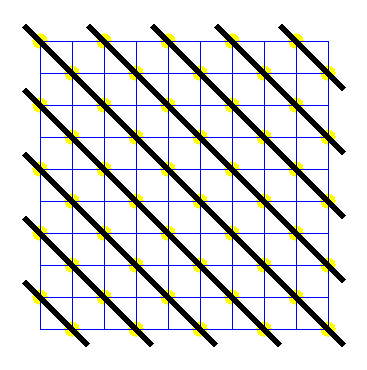
「色光線錯視2」1)
一様な白い背景上を黄色の線が斜めに走って見える。
Copyright Akiyoshi Kitaoka 2001
1) 北岡明佳 (2001) 錯視のデザイン学(7):工学的にはとらえきれない幻の光知覚 日経サイエンス, 31(8), 66-68.
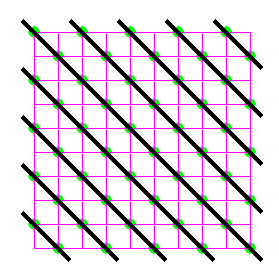
「色光線錯視3」1)
一様な白い背景上を緑色の線が斜めに走って見える。
Copyright Akiyoshi Kitaoka 2001
1) 北岡明佳 (2001) 錯視のデザイン学(7):工学的にはとらえきれない幻の光知覚 日経サイエンス, 31(8), 66-68.
水彩錯視
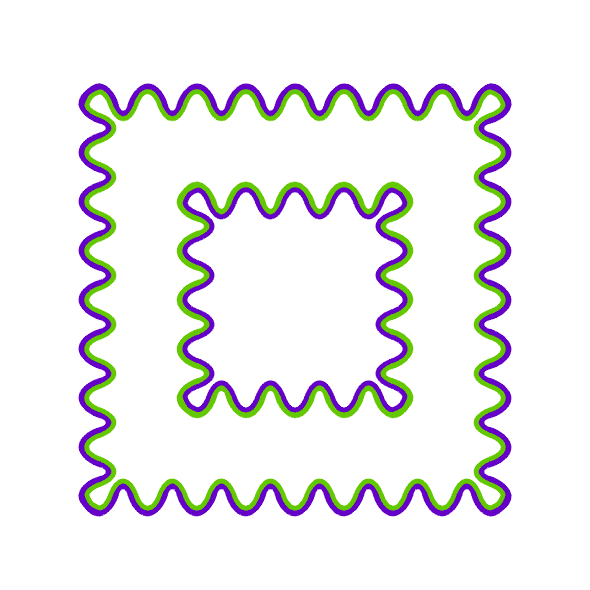
水彩効果(watercolor effect)あるいは水彩錯視(watercolor illusion):
Pinna, B., Brelstaff, G., and Spillmann, L. (2001) Surface color from boundaries: a new ‘watercolor’ illusion. Vision Research, 41, 2669-2676.
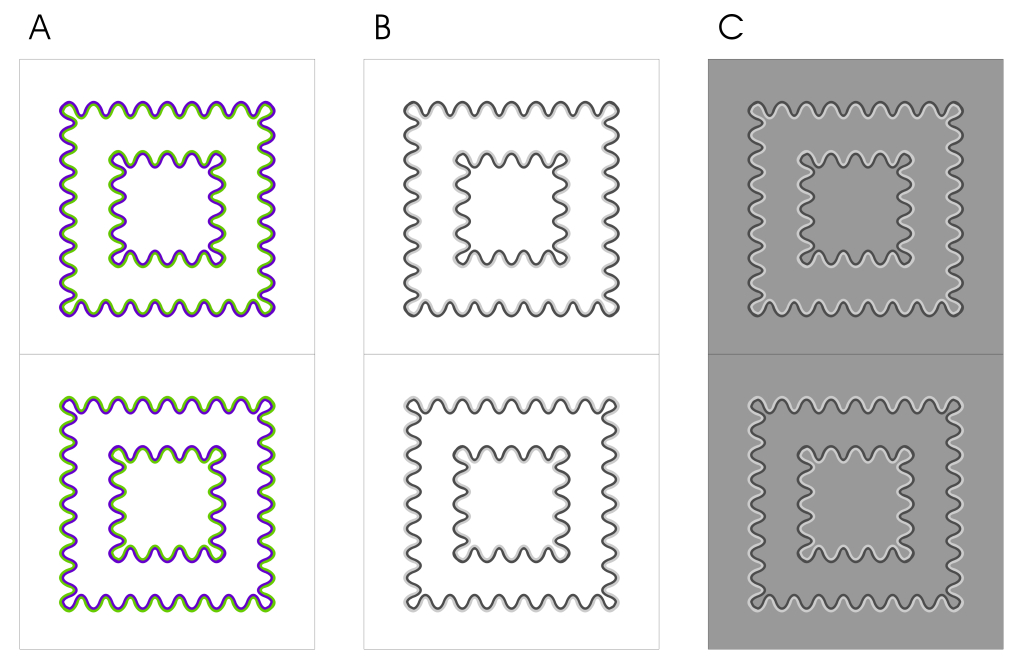
下図は水彩錯視いろいろ
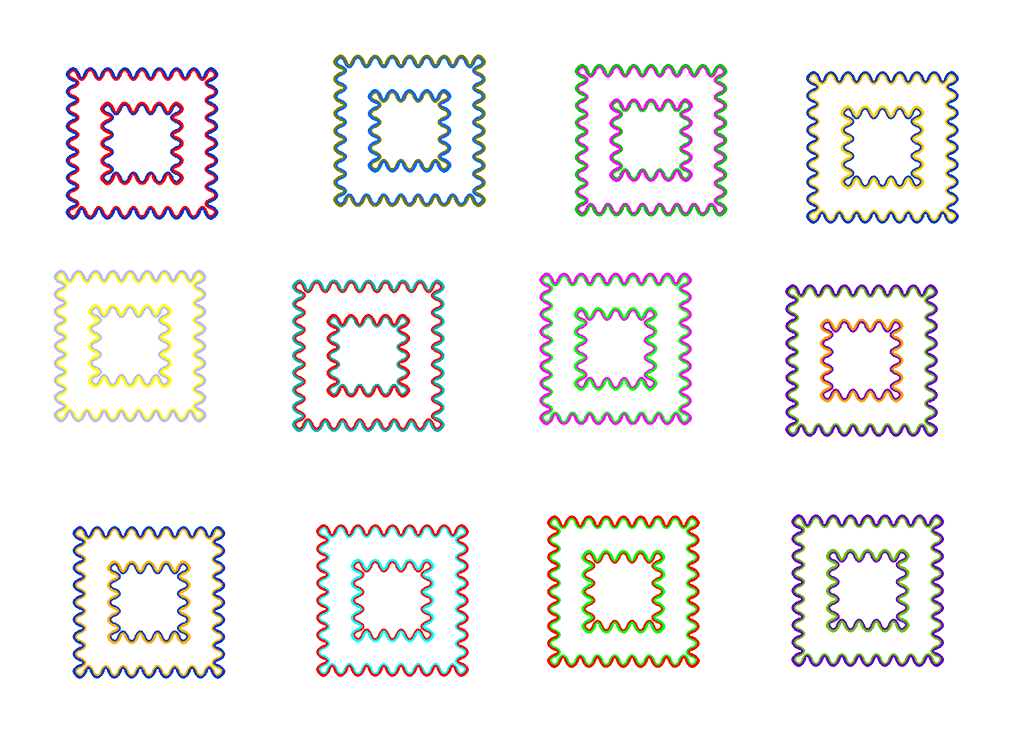
宗宮の波線色錯視
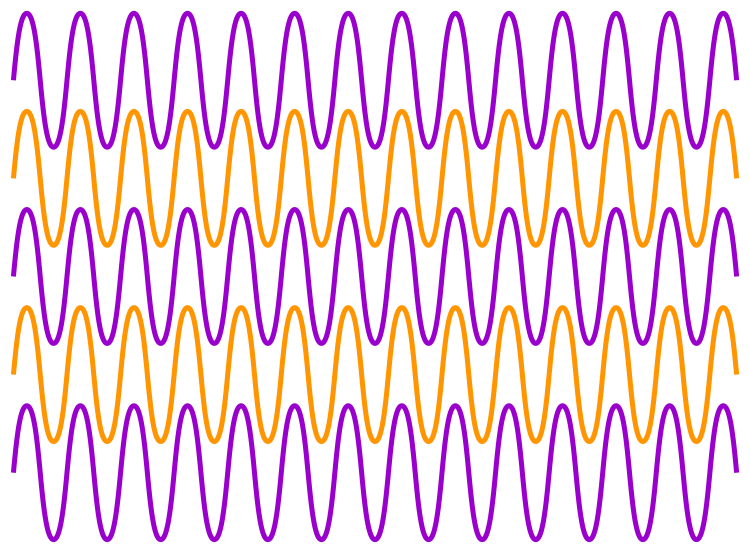
"Wave-line color illusion" (Sohmiya's
illusion)
(Sohmiya, S. (2007) A wave-line colour illusion.
Perception, 36, 1396-1398)
The white background behind the orange waves appears to be tinted orange.
produced by Akiyoshi Kitaoka 2009 (February 19)

「黄ばみ錯視」
格子の中央部分が黄ばんで見える。しかし、これらの図には黄色は使っていないし、輝度条件から考えるとネオン色拡散が起こる位置が逆である。
Copyright Akiyoshi Kitaoka 2007 (September 18)
cf.
Van Tuijl, H. F. J. M. (1975). A new visual illusion: Neonlike color spreading and complementary color induction between subjective contours. Acta Psychologica, 39, 441-445.
Sohmiya, S. (2005) Explanation for neon color effect in achromatic line segments on chromatic inducers based on the multiple interprertation hypothesis. Perceptual and Motor Skills, 101, 267-282.
以下、類似図形。




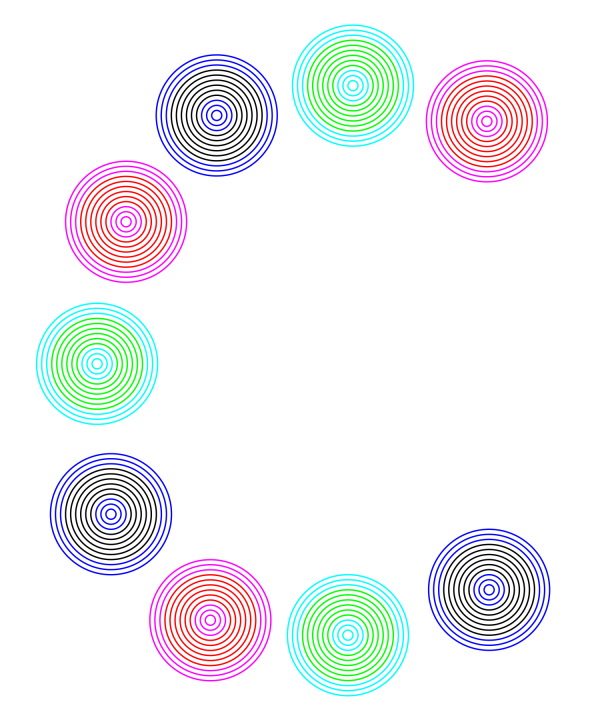
「黄ばみ研究C」
同心円の内部がドーナツ状に黄ばんで見える。
Copyright Akiyoshi Kitaoka 2007 (September 27)
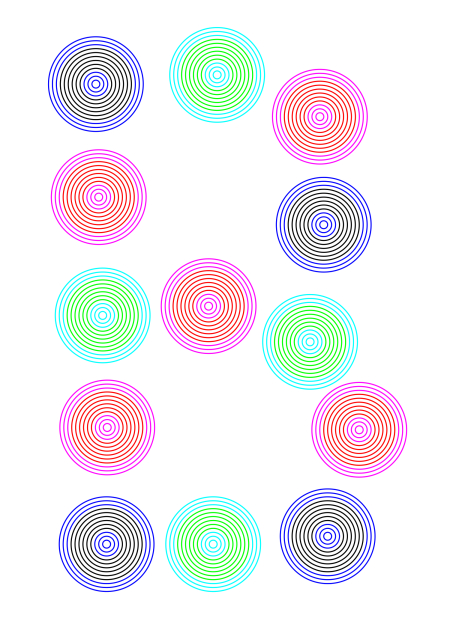
「黄ばみ研究B」
同心円の内部がドーナツ状に黄ばんで見える。
Copyright Akiyoshi Kitaoka 2007 (September 27)
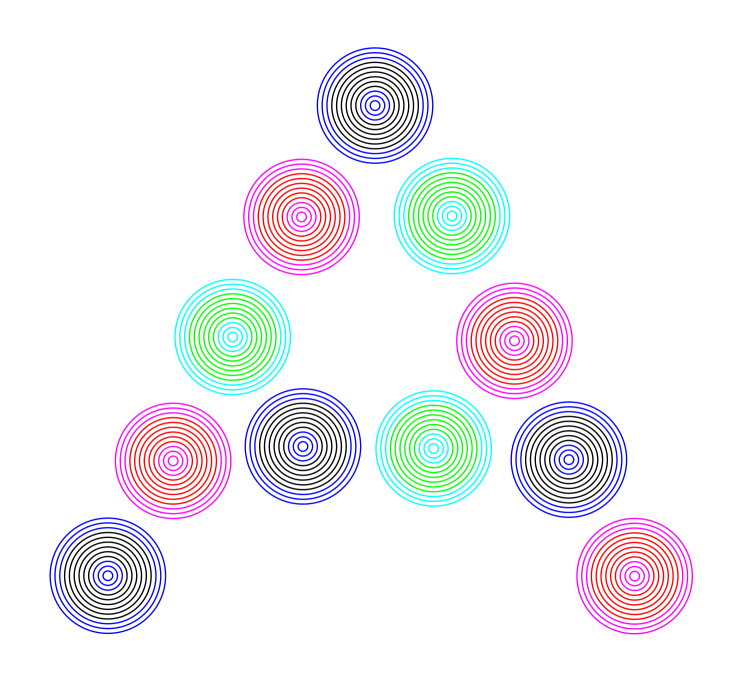
「黄ばみ研究A」
同心円の内部がドーナツ状に基盤ではなくて黄ばんで見える。
Copyright Akiyoshi Kitaoka 2007 (September 27)
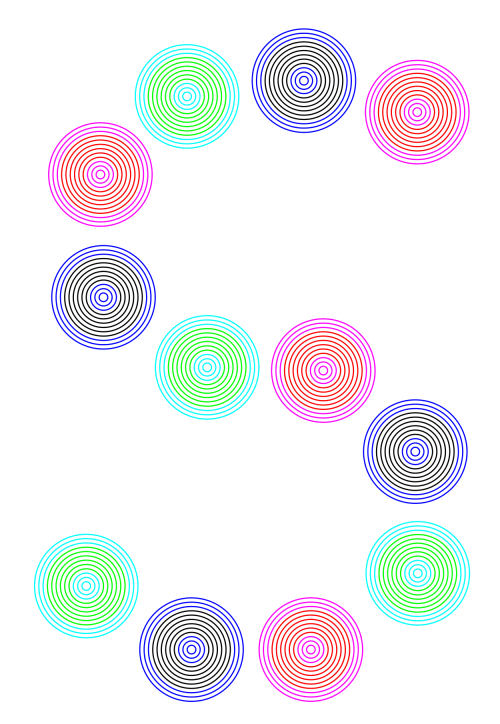
「黄ばみ研究S」
同心円の内部がドーナツ状に黄ばんで見える。
Copyright Akiyoshi Kitaoka 2007 (September 27)
色立体視
Chromostereopsis
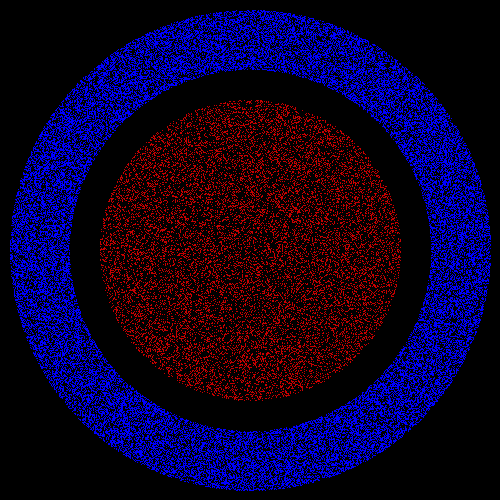
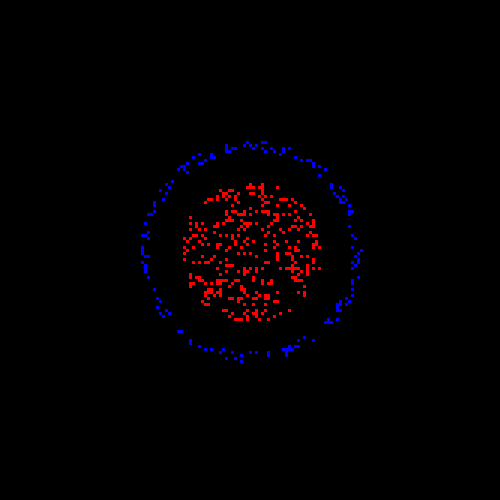
赤が青より手前に見える人が過半数を占めるが、青が赤よりも手前に見える人も20%程度いる。
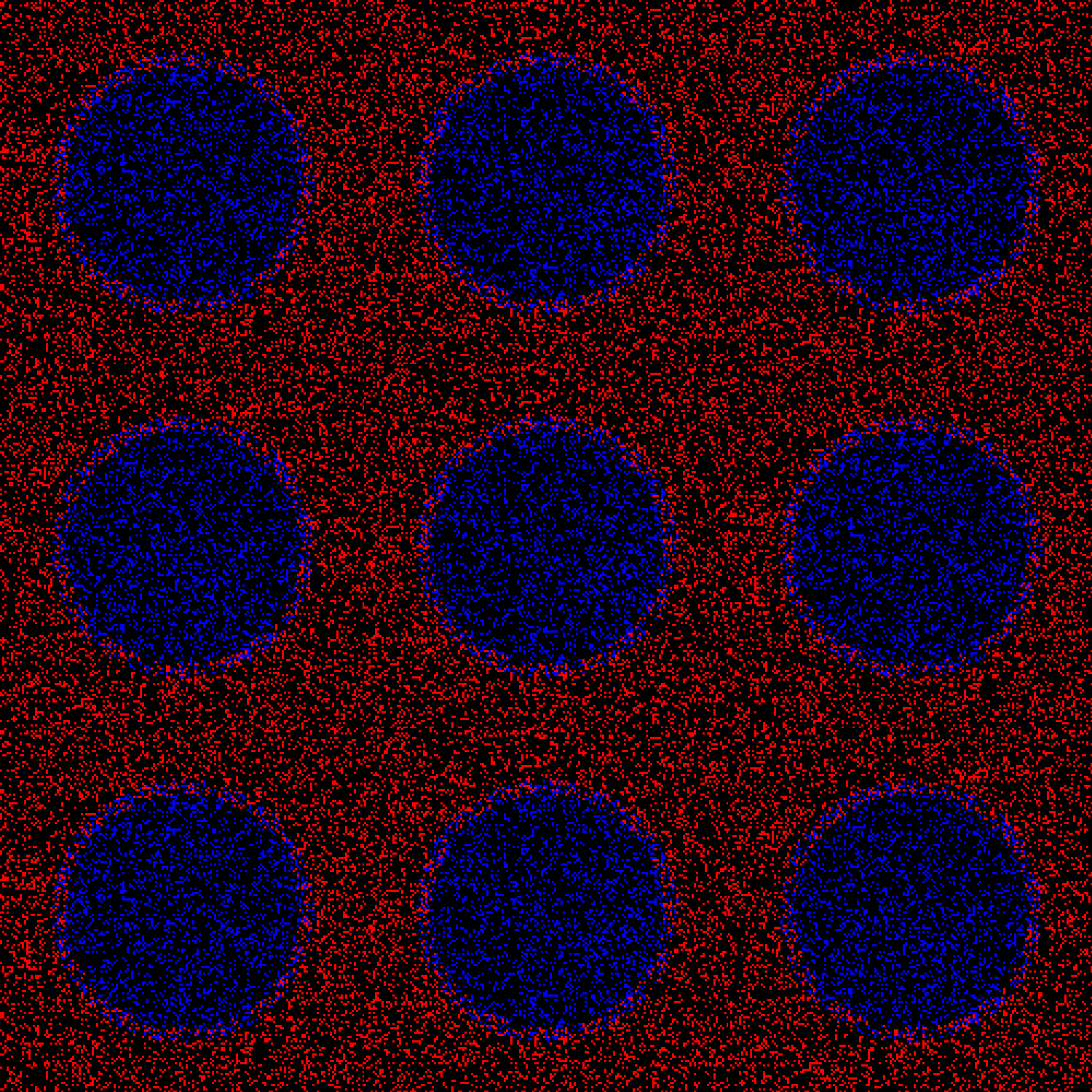
「青い穴」
青い穴が開いているように見える。離れて見ると効果的。孔の周囲のドットが赤紫に見えるが、その外側の赤と同じ色である。
Copyright Akitaoka Kitaoka 2007 (March 9)
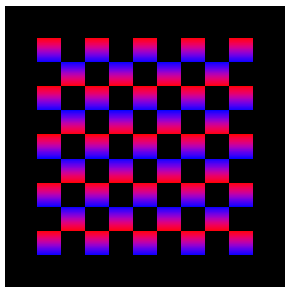
「カマボコ」
赤い部分がカマボコ形の頂点に見える、という見え方をする人が多いと推定される。
Copyright A.Kitaoka 2003
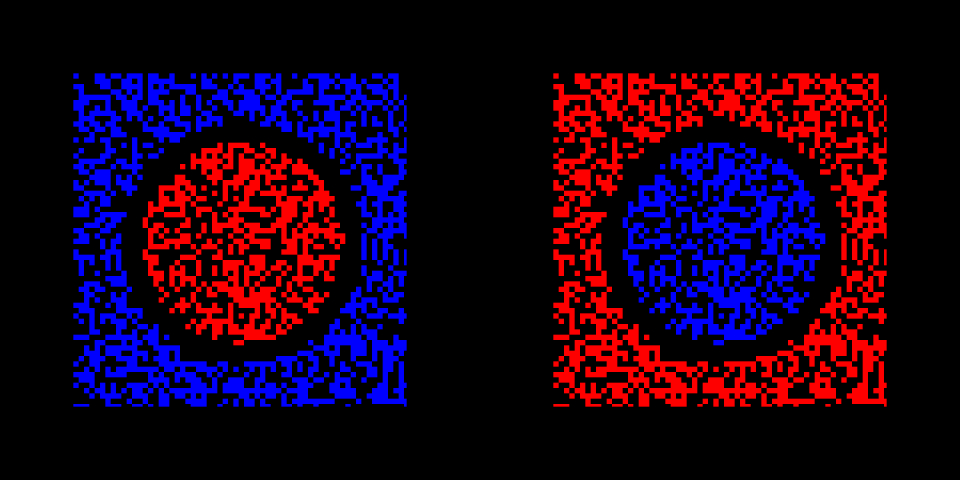
Chromostereopsis. For the majority of observers, the inset made up of red random dots appears to be in front of the surround constituted of blue ones. For a minority, the inset appears to be behind the surround. The rest do not experience the phenomenon. Chromostereopsis is strong when observers see the image at a distance.
Copyright Akiyoshi Kitaoka 2013 (August 3)
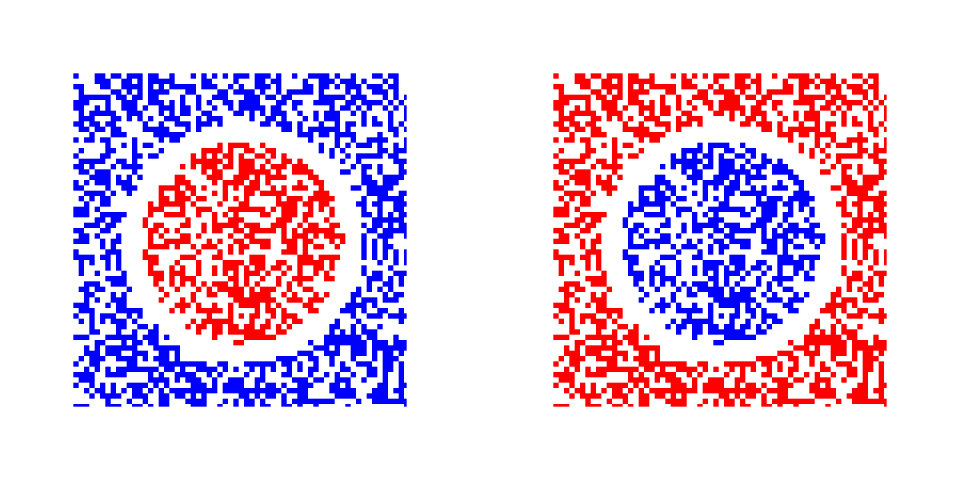
Background luminance-dependent reversal; color reversal
Copyright Akiyoshi Kitaoka 2013 (August 3)
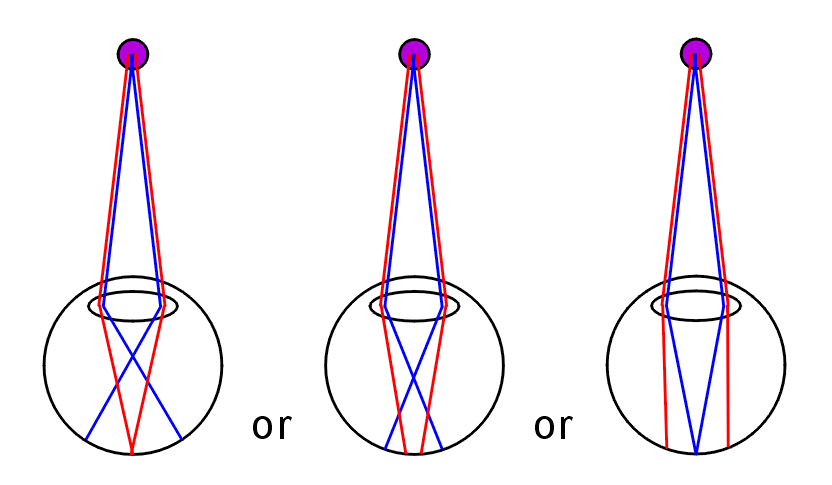
Longitudinal chromatic aberration
Copyright Akiyoshi Kitaoka 2005 (November 24)
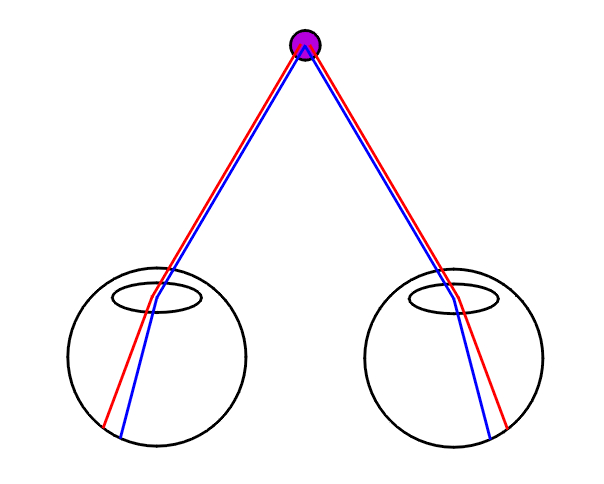
Transverse chromatic aberration
Copyright Akiyoshi Kitaoka 2005 (November 24)
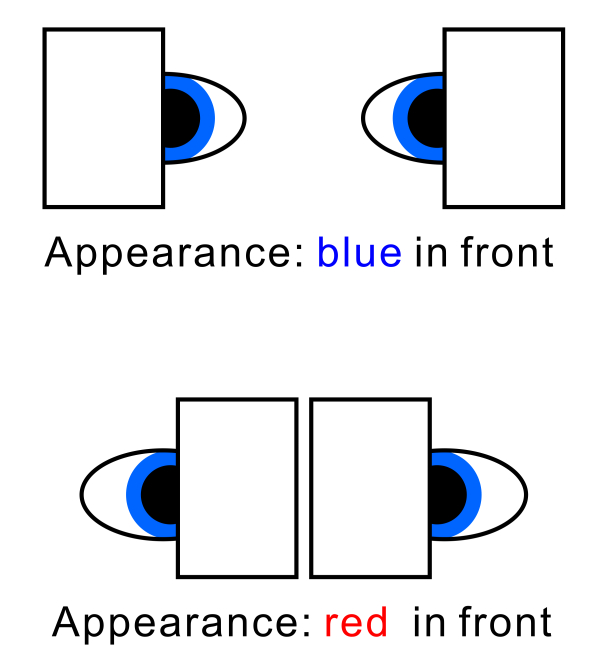
Einthoven's (1885) covering method
Copyright Akiyoshi Kitaoka 2009 (February 29)
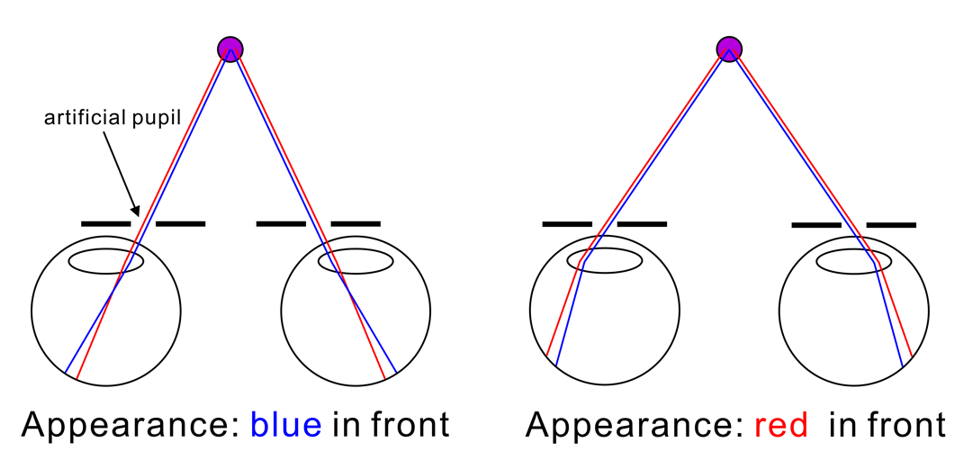
Artificial pupil method & Stiles-Crawford effect
---> Vos' (1960, 2008) "generalised Bruecke-Einthoven explanation"
Copyright Akiyoshi Kitaoka 2009 (February 29)
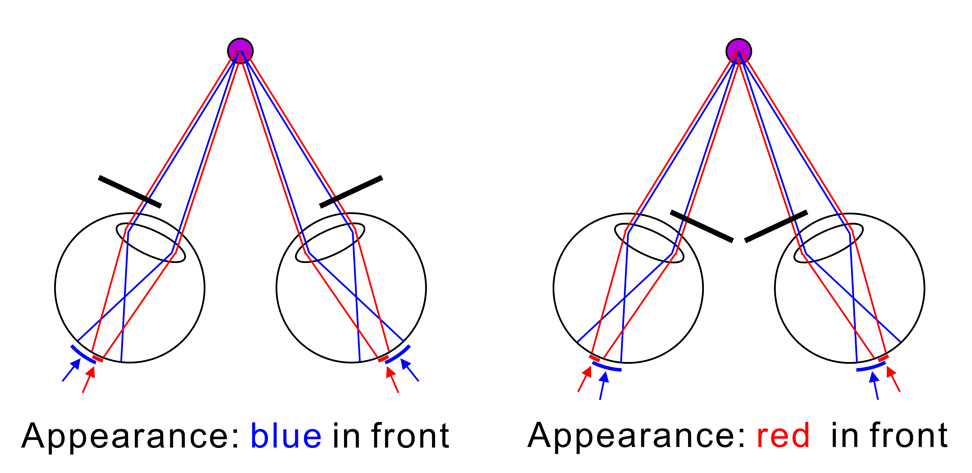
Center-of-gravity model (Kitaoka et al., 2005)
Copyright Akiyoshi Kitaoka 2013 (July 25)
Kitaoka, A, Kuriki, I. and Ashida, H. (2006). The center-of-gravity model of chromostereopsis. Ritsumeikan Journal of Human Sciences, 11, 59-64. PDF
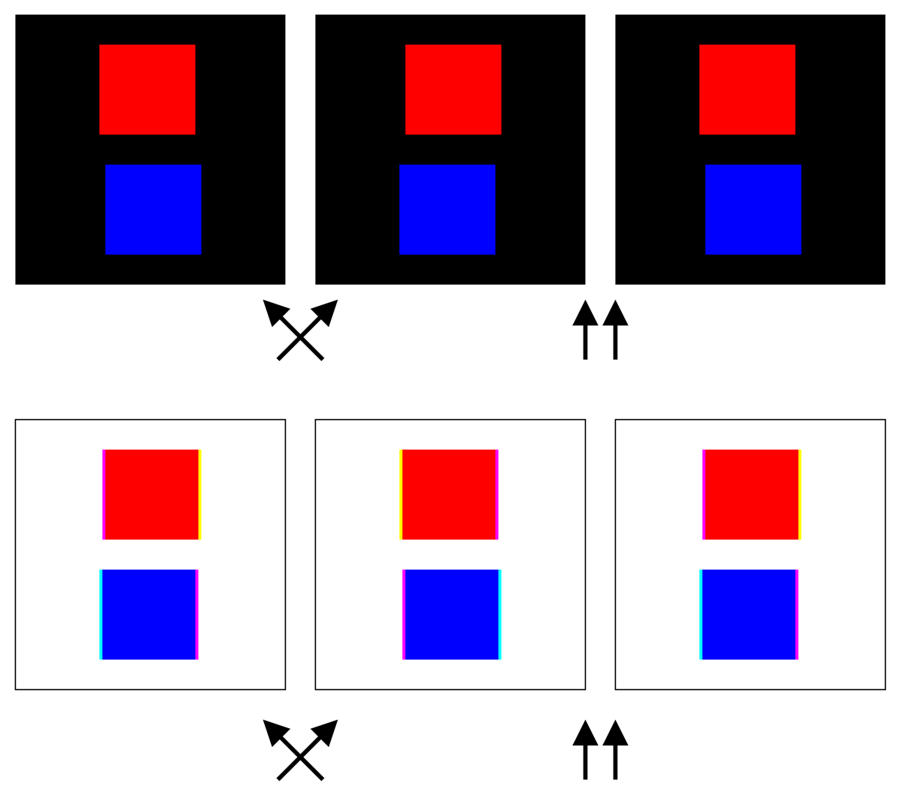
Kitaoka's explanation of the background luminance-dependent reversal
Copyright Akiyoshi Kitaoka 2013 (July 25)
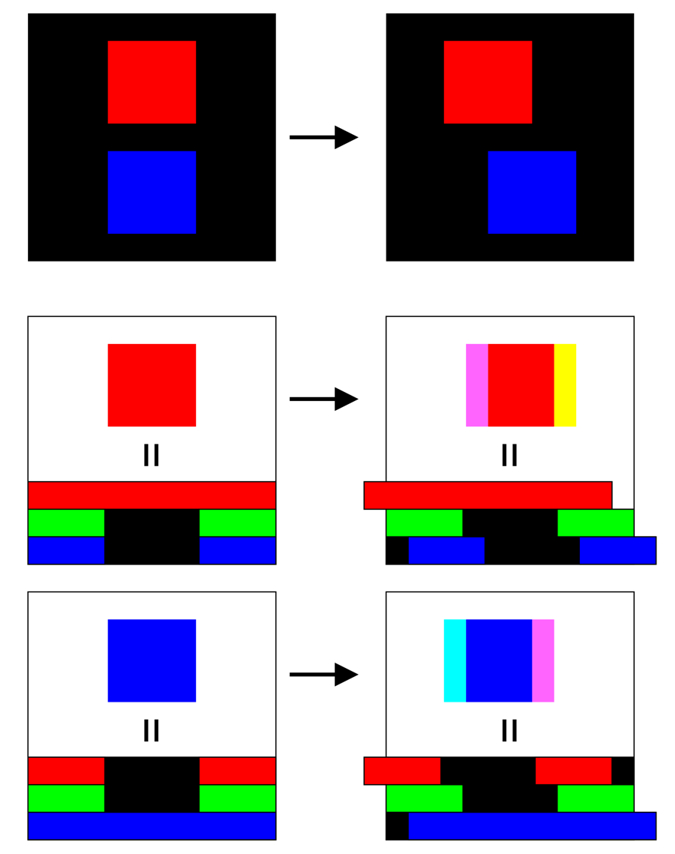
その他、色収差による色ずれの作品「額がガクガク」↓
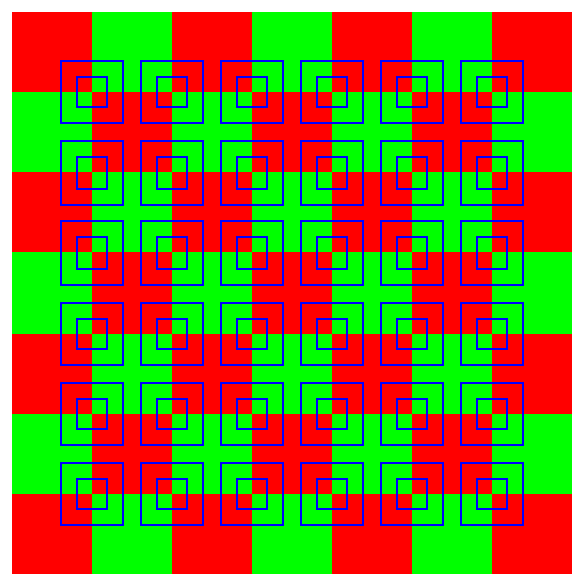
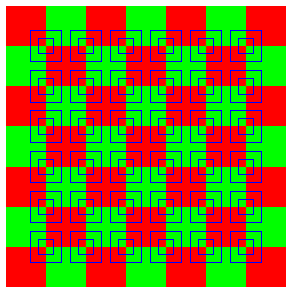
青い線の正方形が赤と緑の境界のところでずれているように見える。作者にはそう見えるが、理論的にはそう見えない人もいると思われる。そのほか、ヘルマン格子錯視や色の同化が見られる。
Copyright A.Kitaoka 2003 (June 16, 2003)
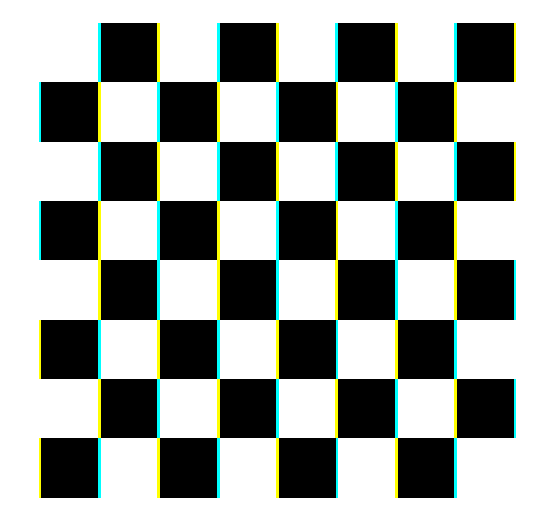
「色収差錯視チェッカーボード」
近眼で眼鏡をかけている人は、顔を右に向けて目は左でこの図を見ると、上半分のそれぞれの正方形の左側は鮮やかな水色、右側は黄色(あるいはオレンジ色)に見える。この時、下半分の正方形の両側は緑色に見える。顔を左に向けた場合はその反対。遠視あるいは老視の眼鏡をかけている人は多分逆。
Copyright Akiyoshi .Kitaoka 2005 (October 9)
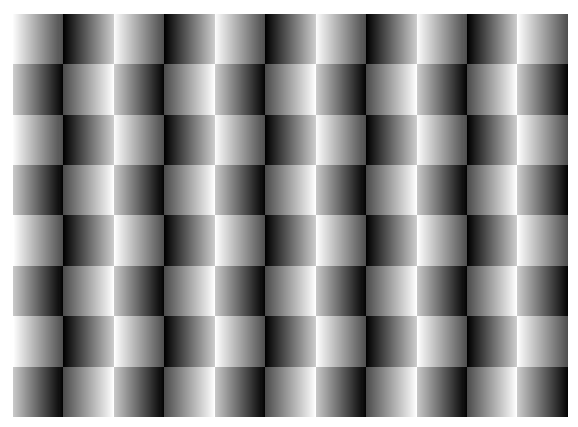
「色変化ふにゃふにゃカーペット」
近眼で眼鏡をかけている人は、顔を右に向けて目は左でこの図を見ると、左から2、4、6、8、10列目が黄味を帯びて見え、残りが青味を帯びて見える。顔を左に向けた場合はその反対。遠視あるいは老視の眼鏡をかけている人は多分逆。そのほか、図がふにゃふにゃと不安定に見える錯視がある。
Copyright Akiyoshi .Kitaoka 2005 (October 9)
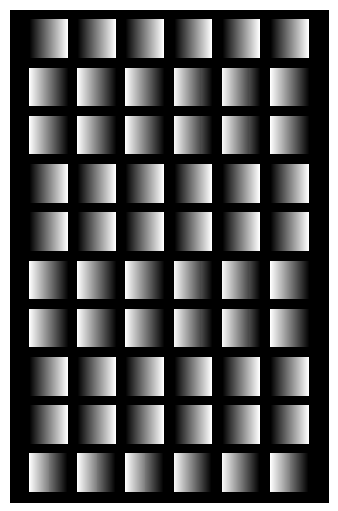
「金箔と銀箔」
近眼で眼鏡をかけている人は、顔を右に向けて目は左でこの図を見ると、上から1、4、5、8、9列目が金色に、残りが銀色に見える。顔を左に向けた場合はその反対。遠視あるいは老視の眼鏡をかけている人は多分逆。そのほか、列が動いて見える錯視と、正方形なのに明るい側が大きく見える錯視がある。
Copyright Akiyoshi .Kitaoka 2005 (October 9)
<動くと色が変わって見える錯視>

「明るさ変調リング」
中央を見ながら図に目を近づけると、上と下の扇は連動して明るく、やや黄色っぽく見え、右と左の扇は連動して暗く、やや青みがかって見える。図から遠ざかる時は、その逆に、上と下の扇は連動して暗く、やや青みがかって見え、右と左の扇は連動して明るく、やや黄色っぽく見える。
Copyright Akiyoshi Kitaoka 2012 (November 19)
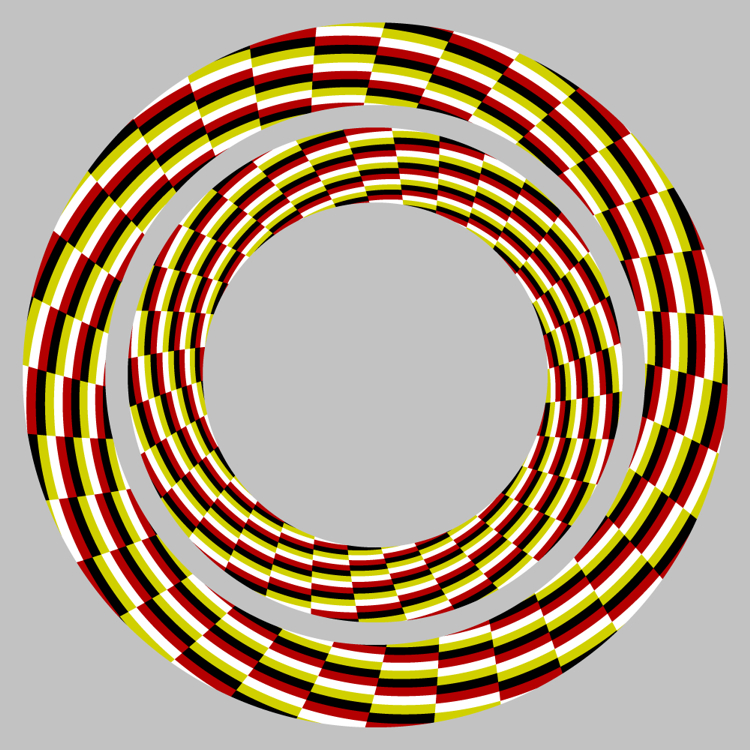
「二つの環」
内側のリングは縮小して見え、外側のリングは拡大して見える(最適化型フレーザー・ウィルコックス錯視)。中心を見ながら図に目を近づけたり遠ざけたりすると、リングがお互いに反対方向に回転して見える(回転オオウチ錯視)。また、中心を見ながら図に目を近づけると内側のリングが赤味を増し、目を遠ざけると外側のリングが赤味を増す。1つの図で3つも錯視が楽しめるおトクな錯視デザイン。
Copyright A.Kitaoka 2005 (April 1)
色が変わる錯視を説明する仮説・・・処理速度説↓
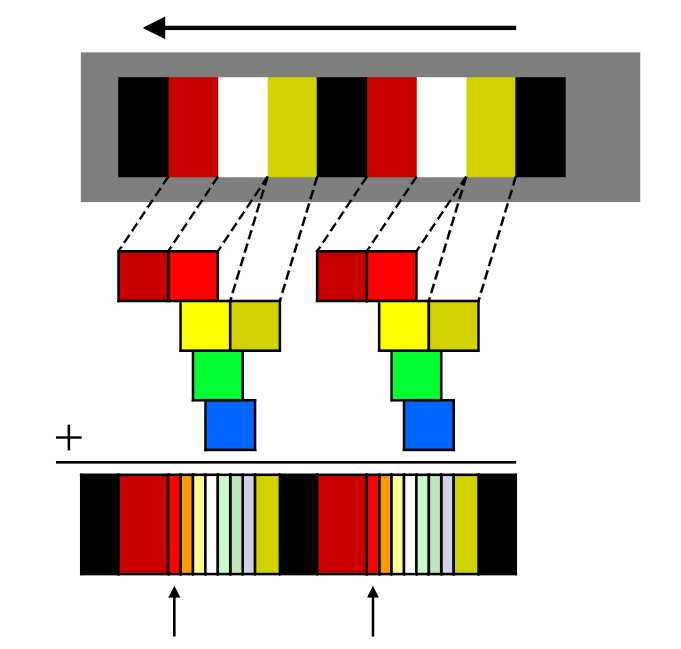
刺激イメージが網膜上で動いた場合、長波長の刺激の視覚処理が早く、短波長の刺激の視覚処理が遅いと考えると説明できる。図では矢印の先の赤が増加して見え、後方に残る青は黄色と打ち消しあって無彩色に近くなる。
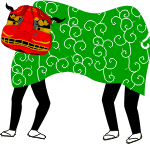 おしまい
おしまい


